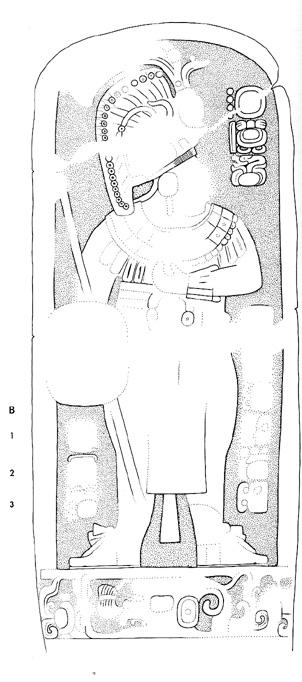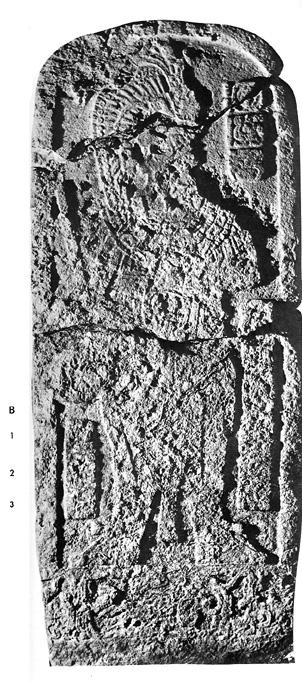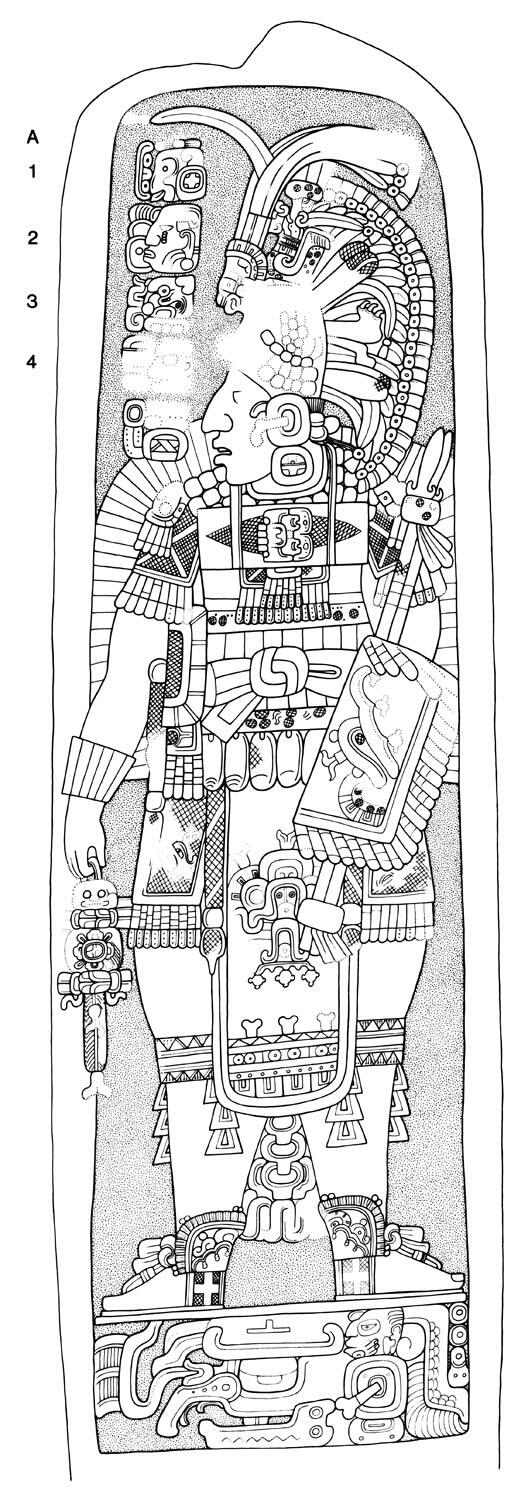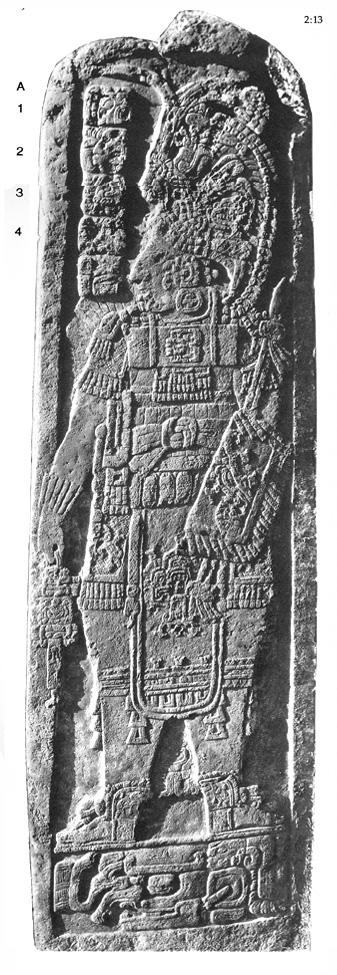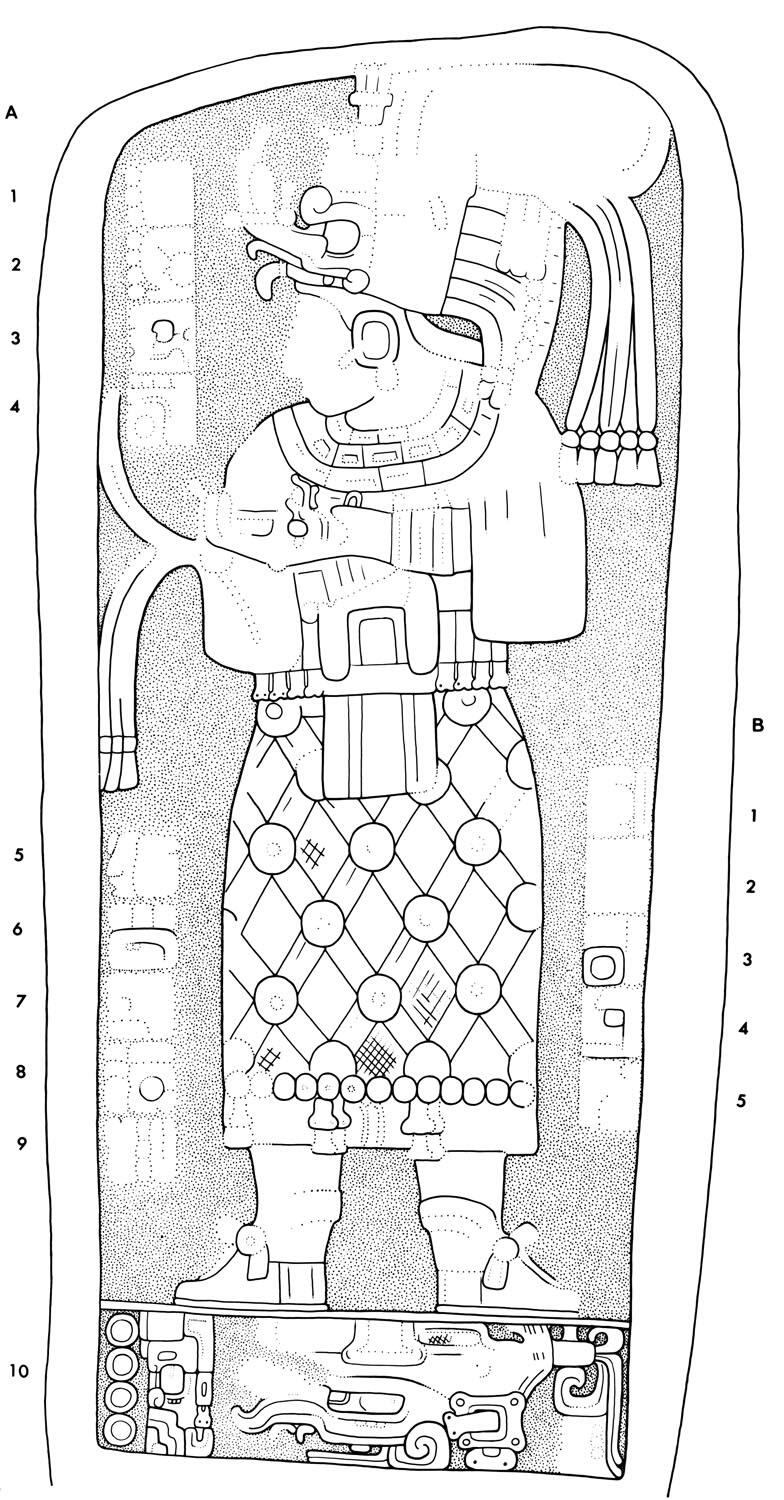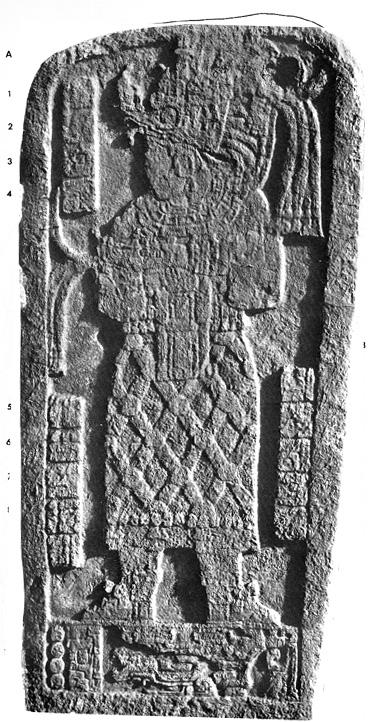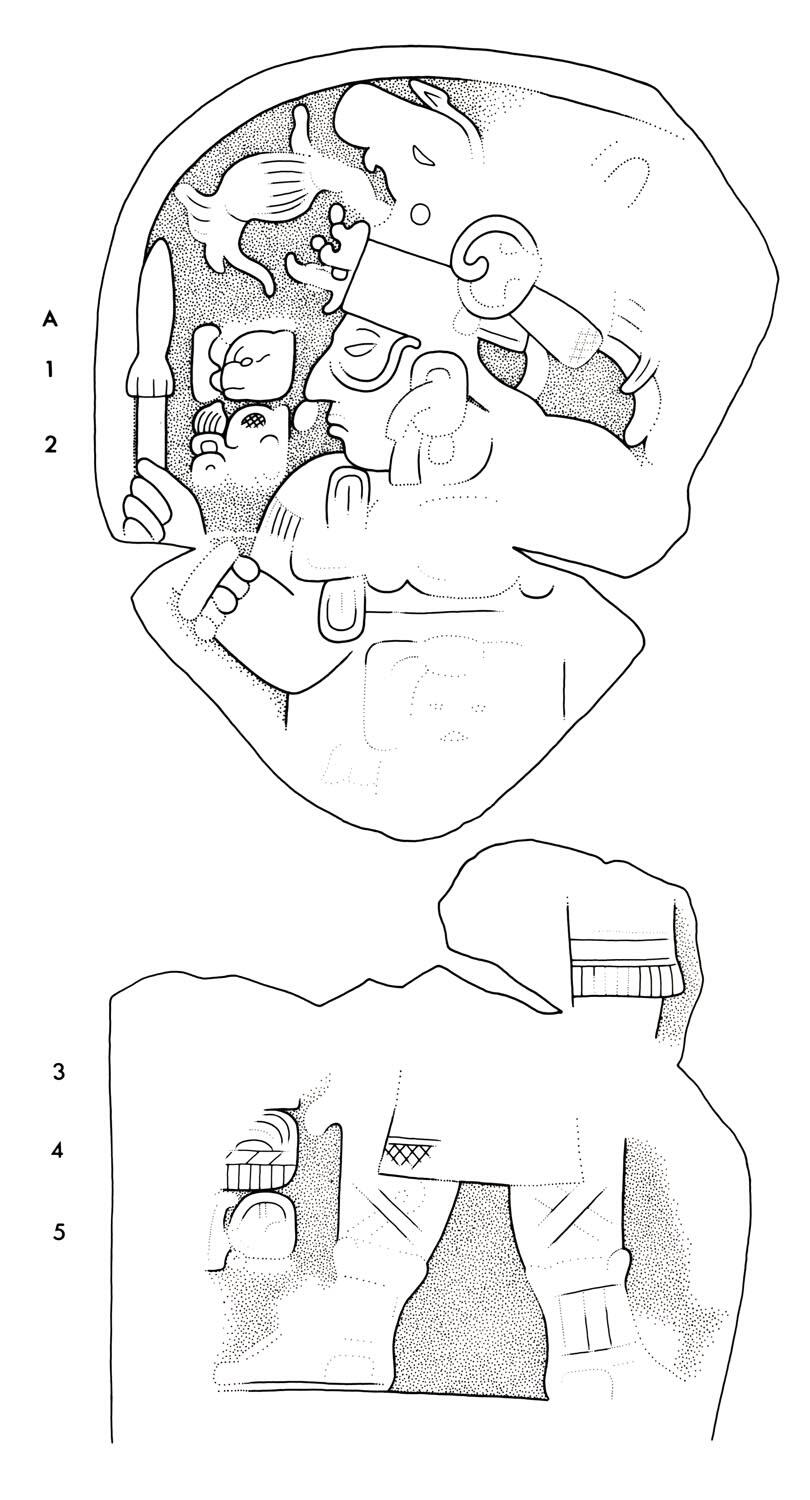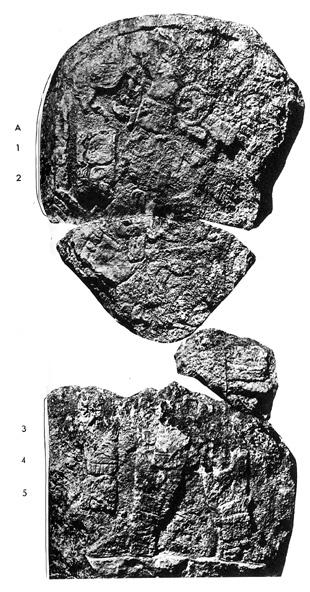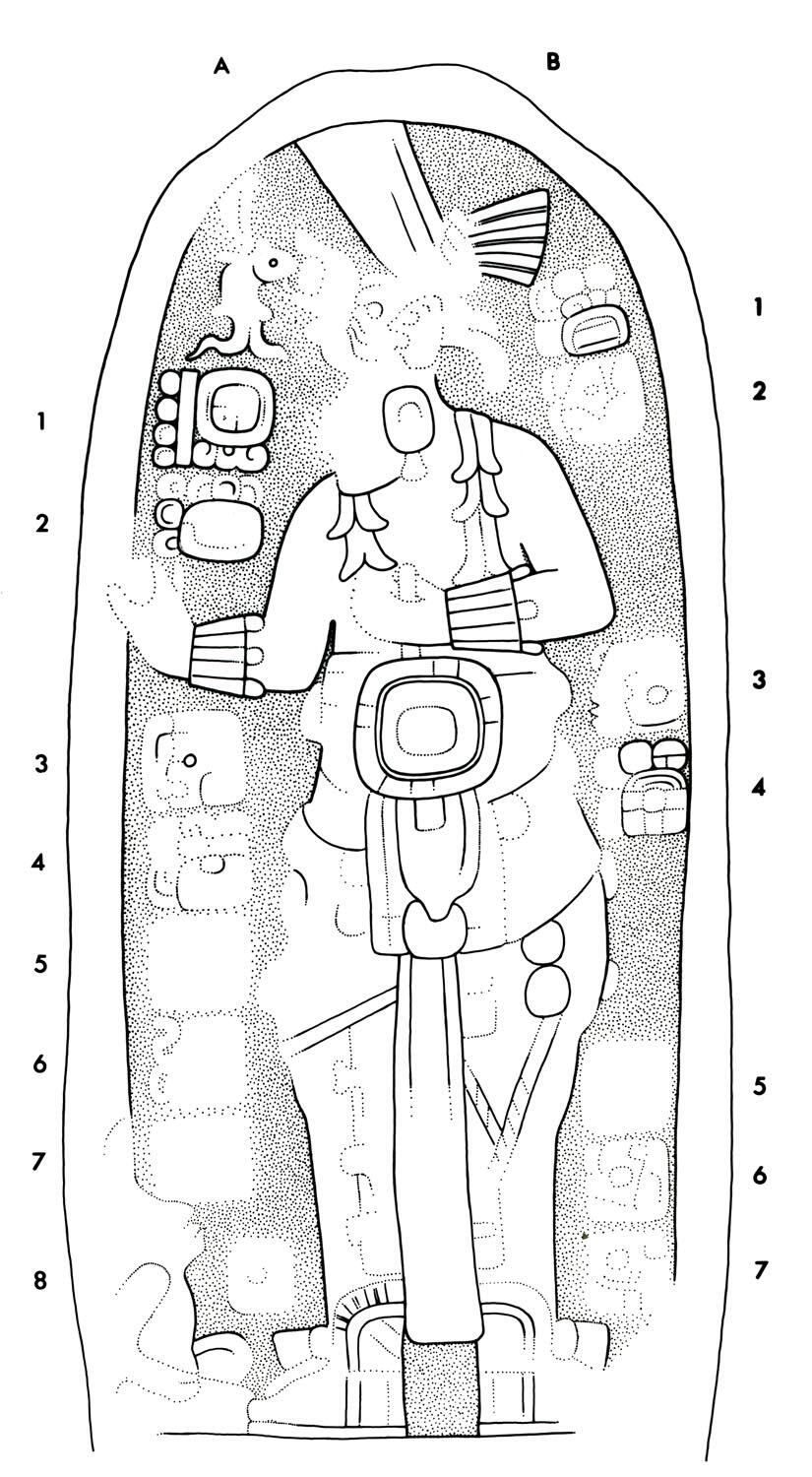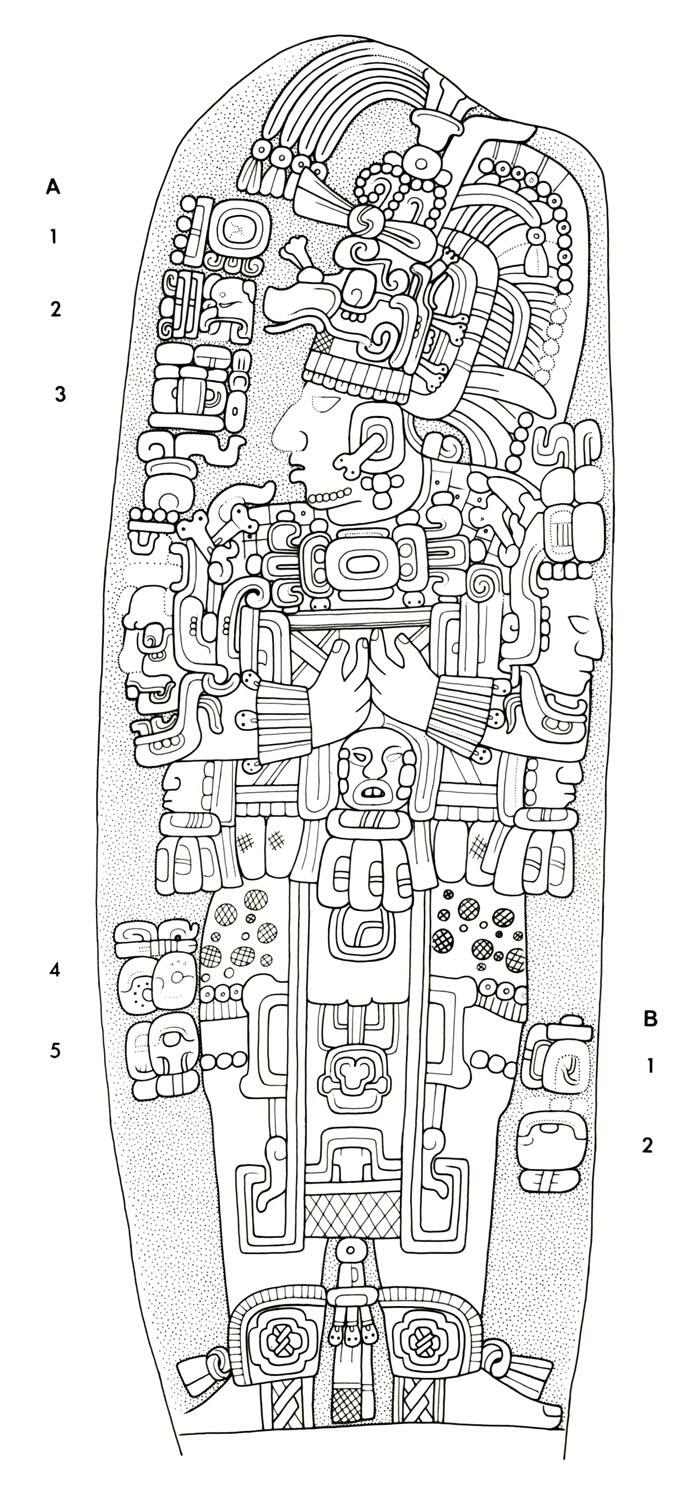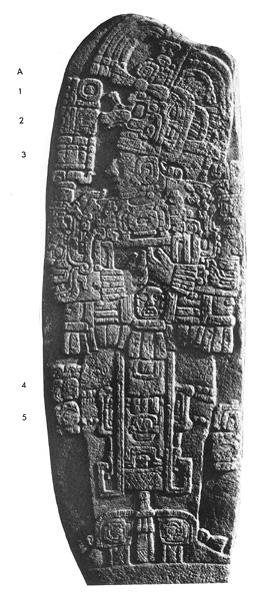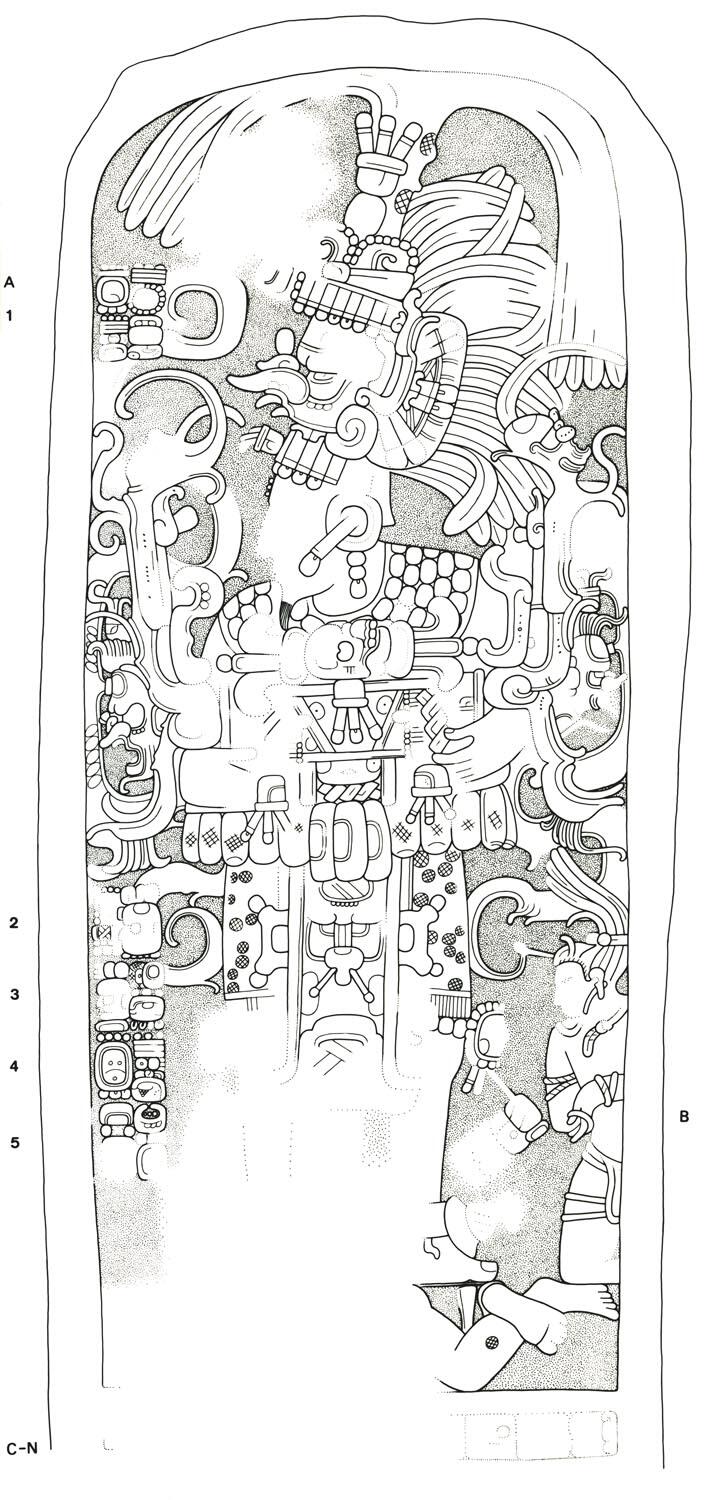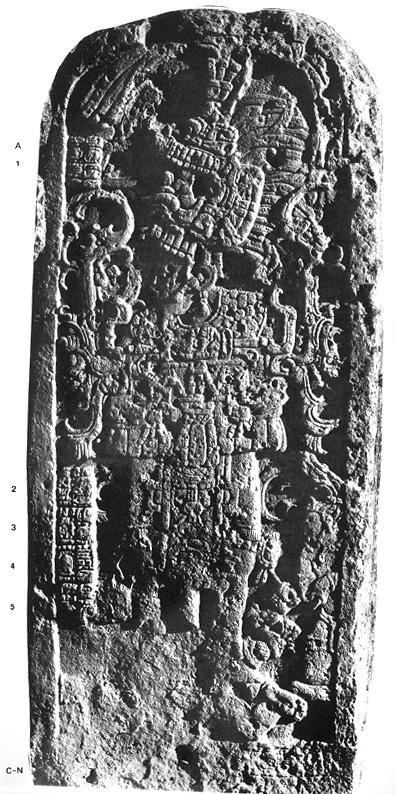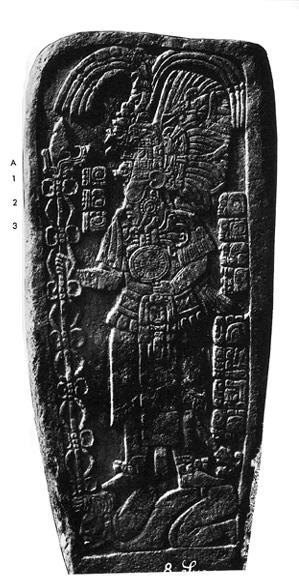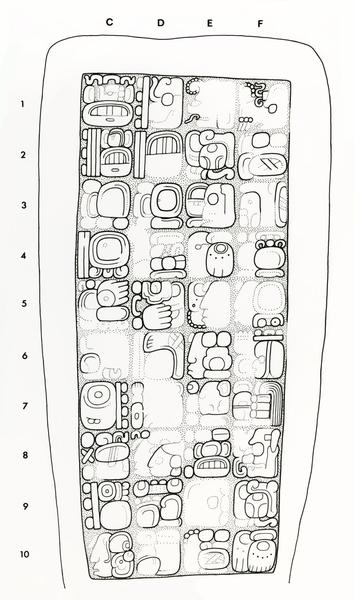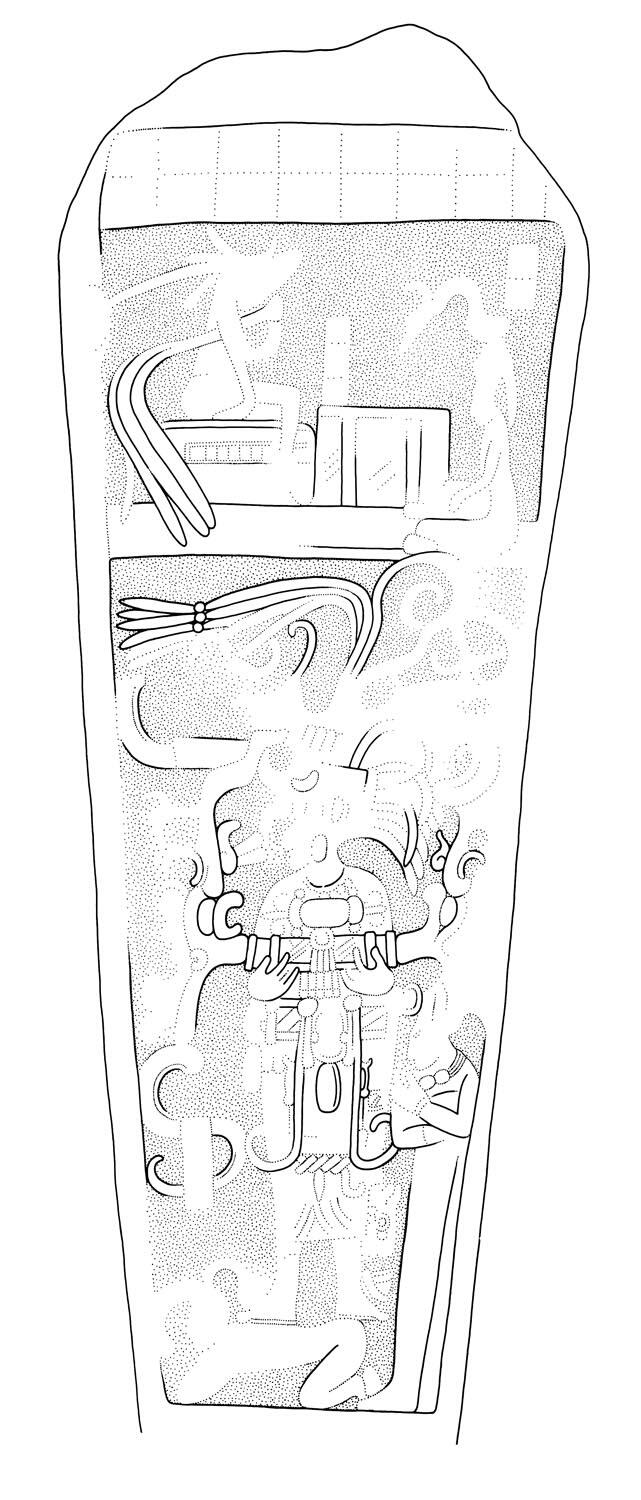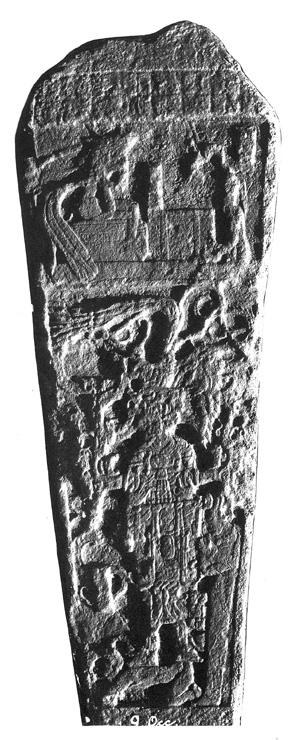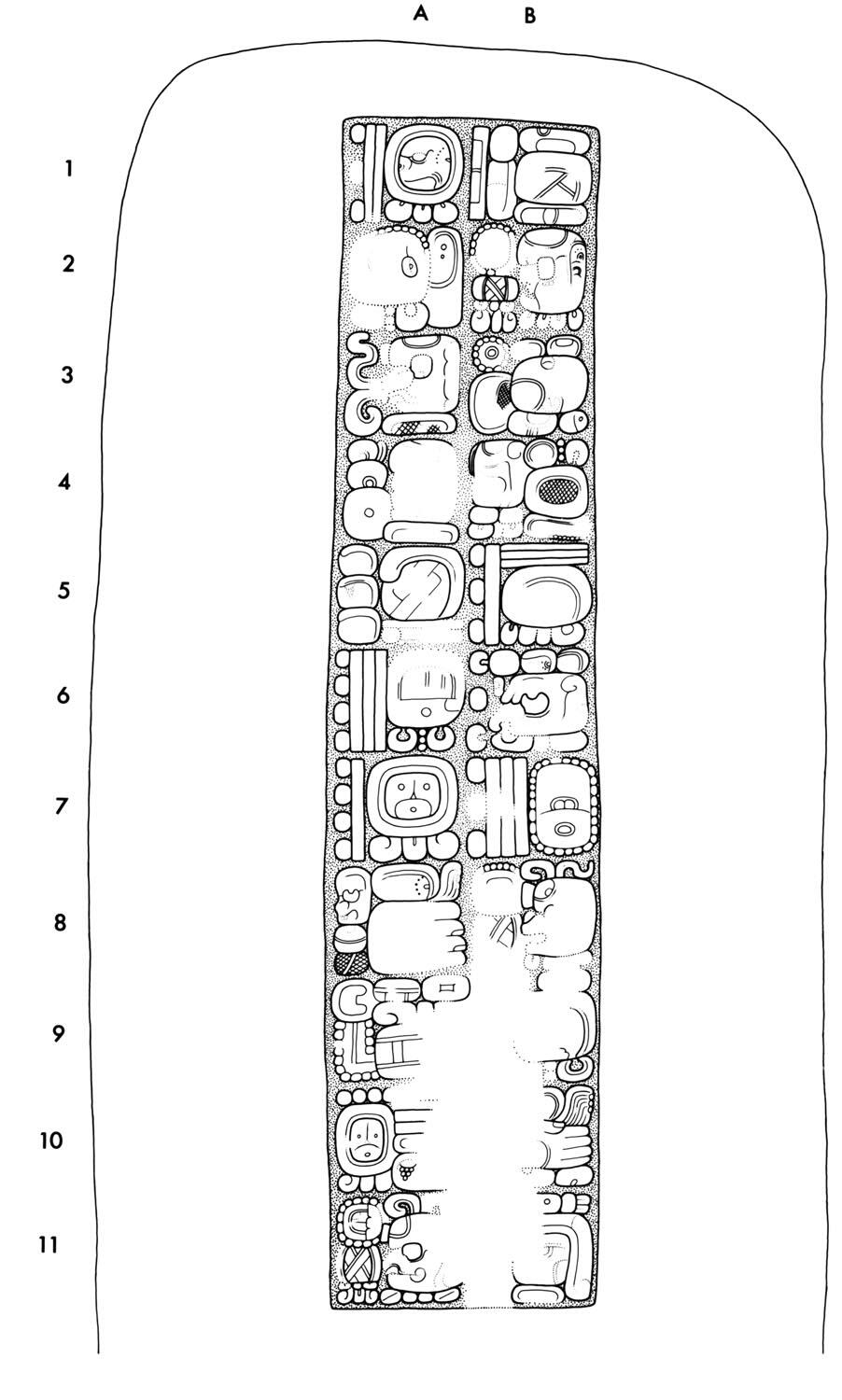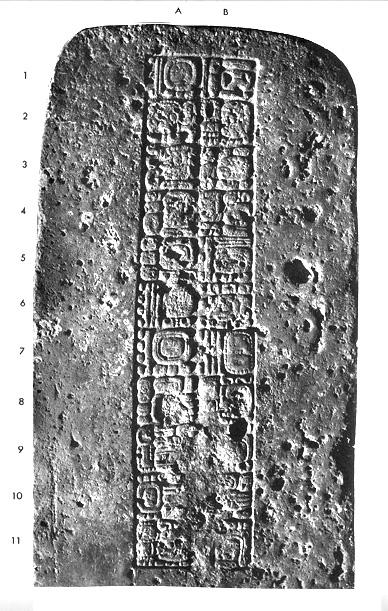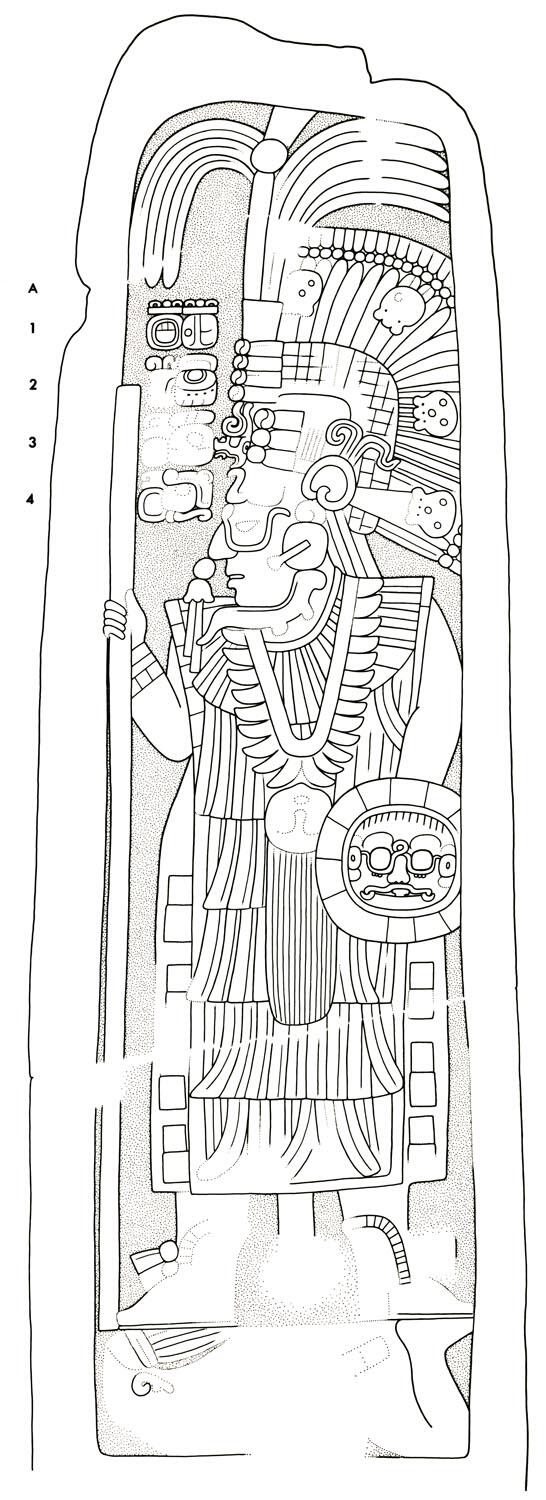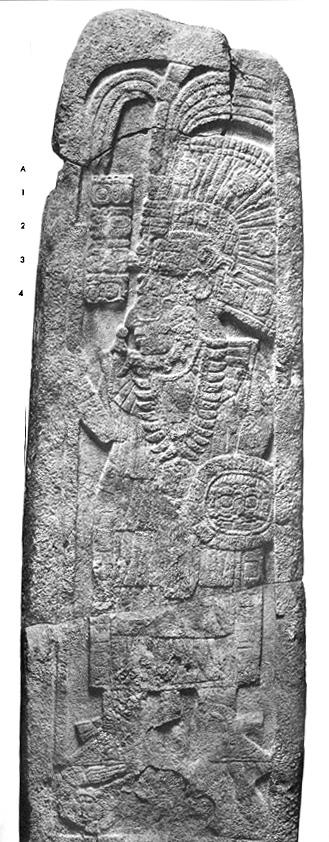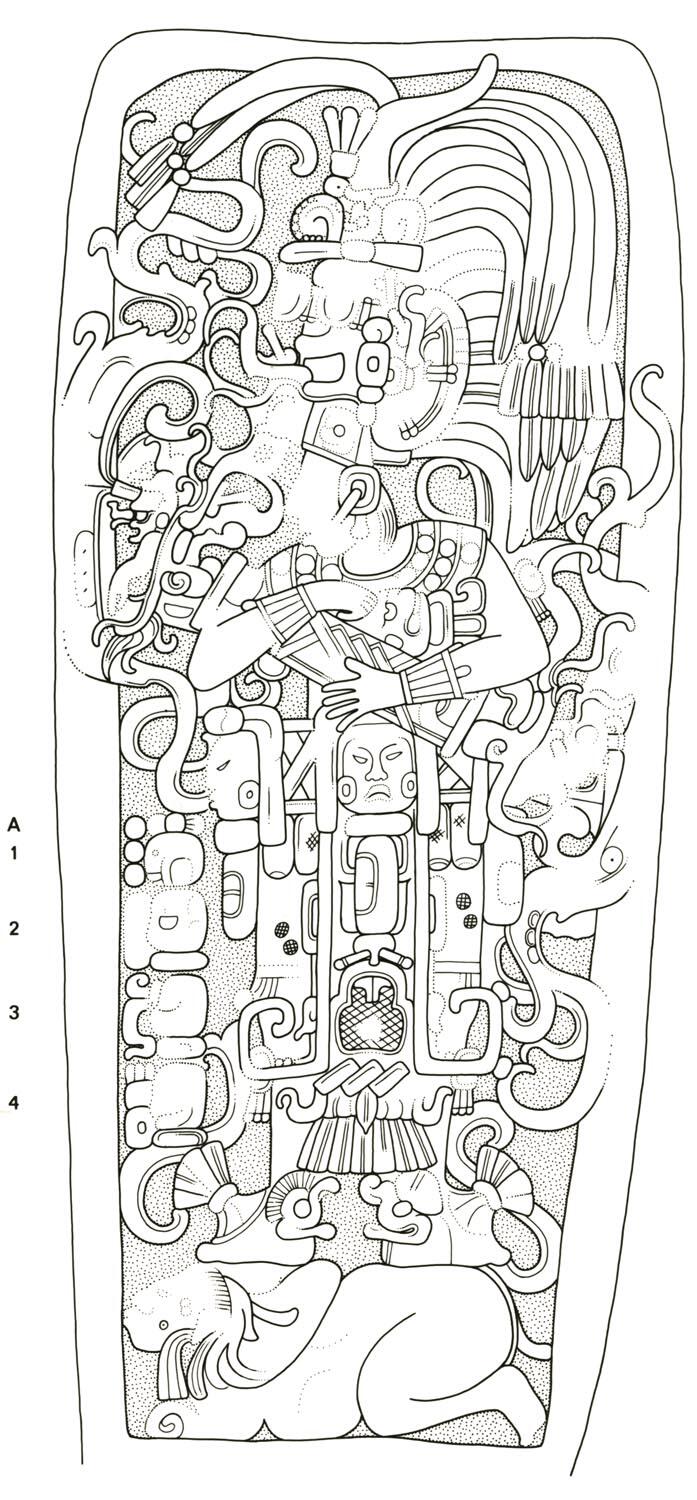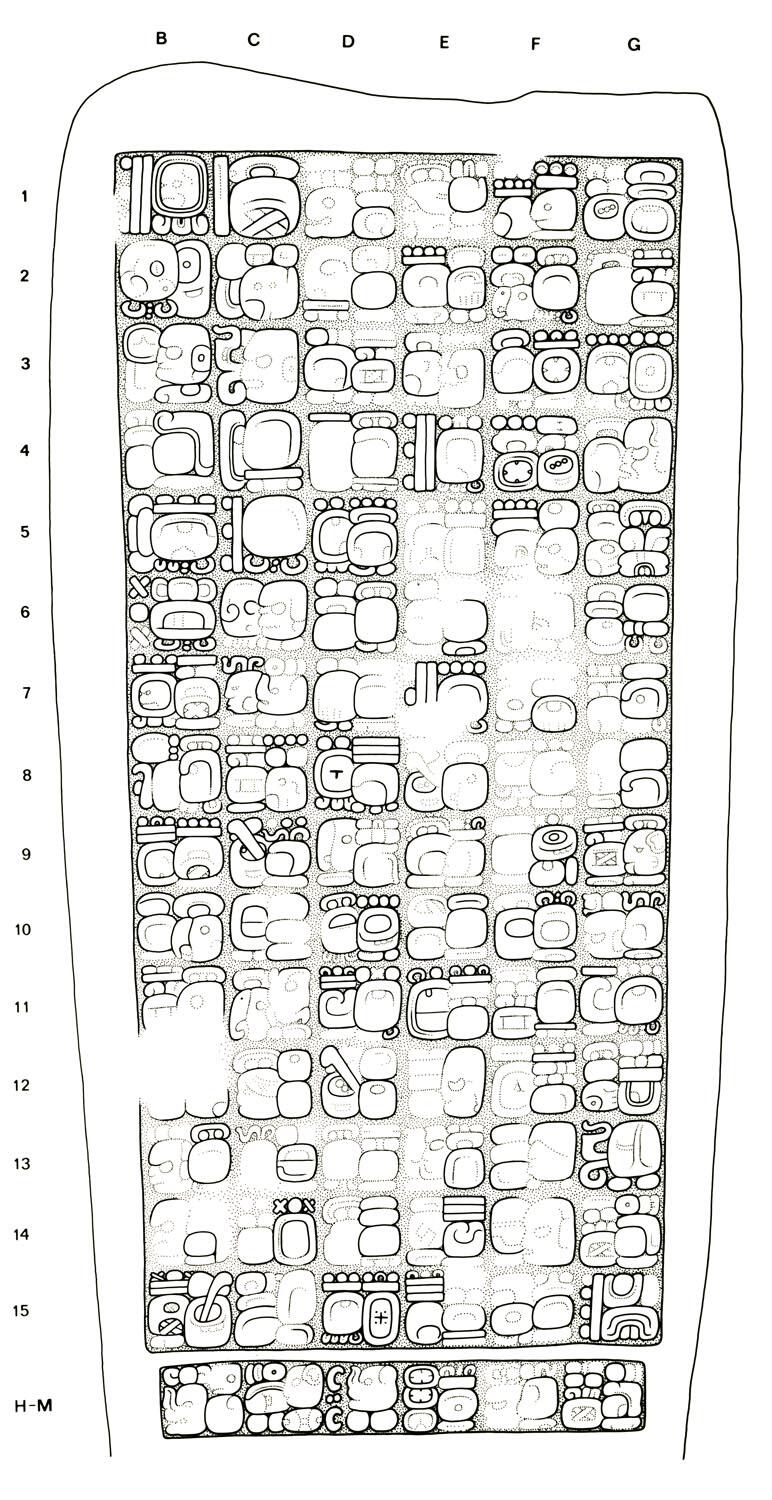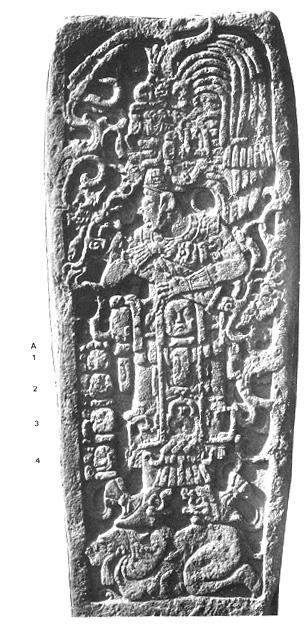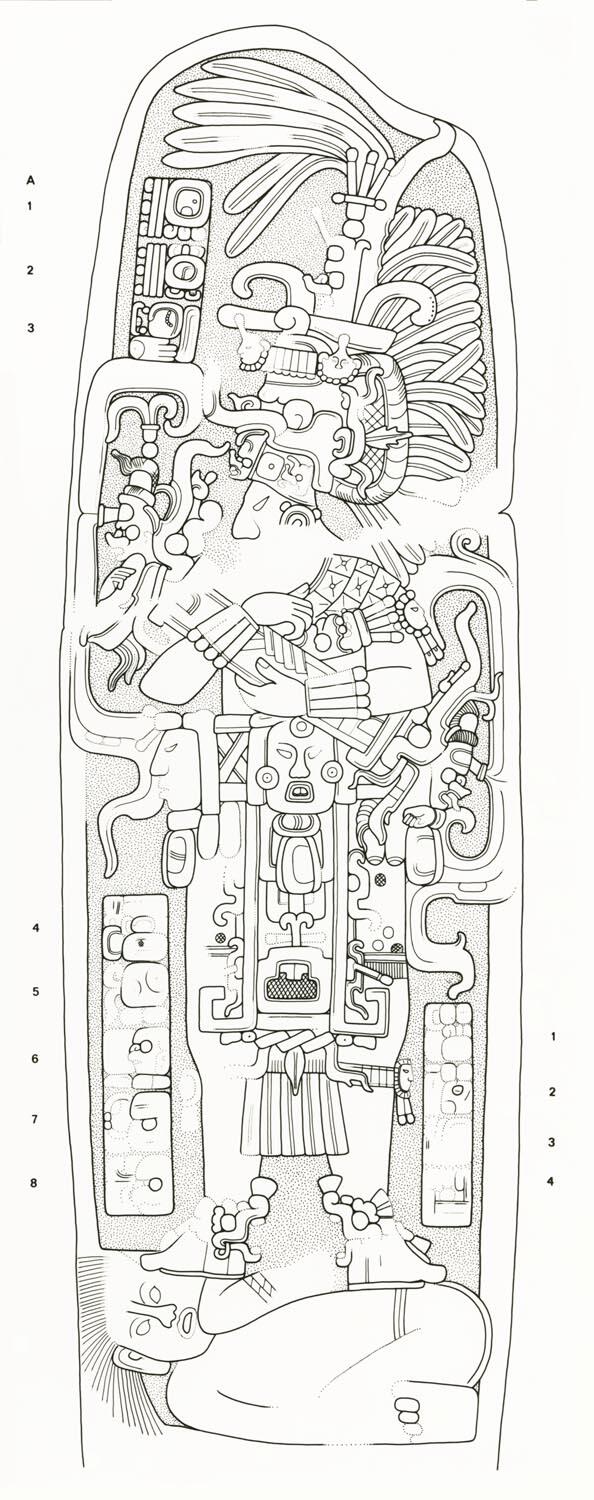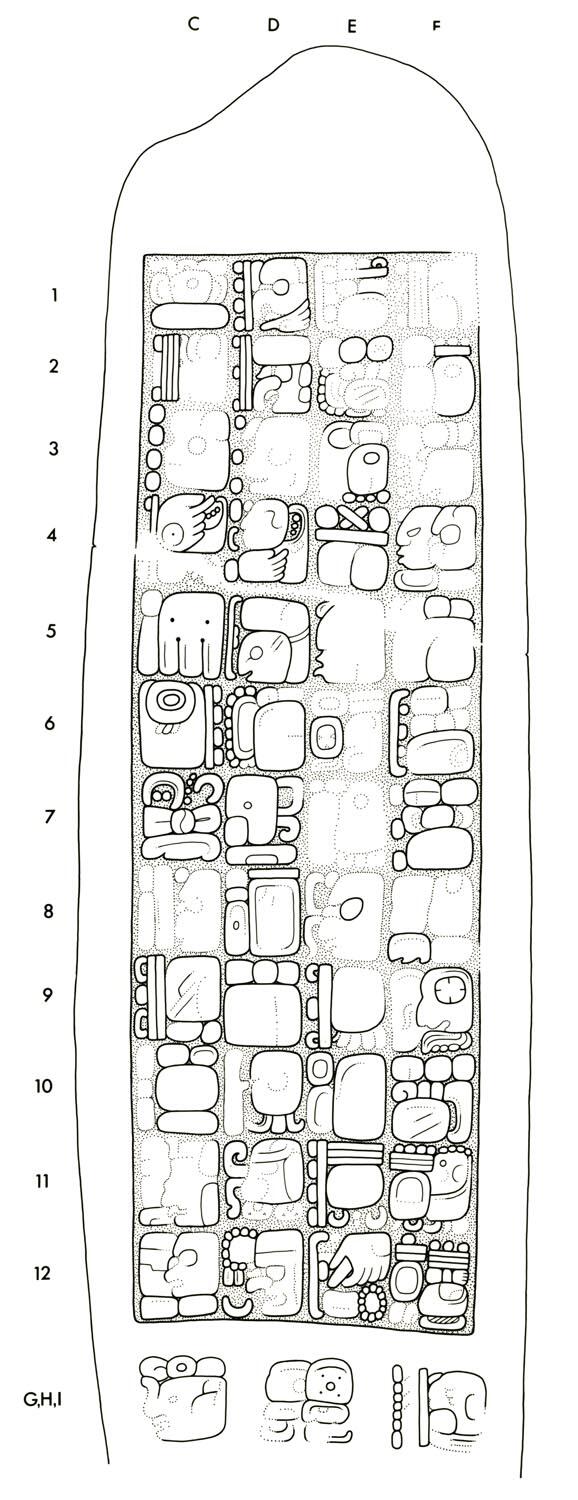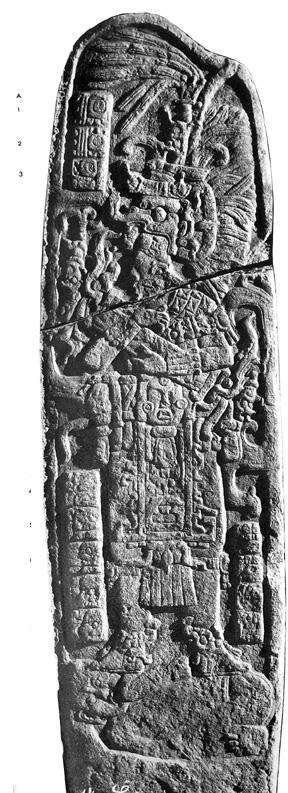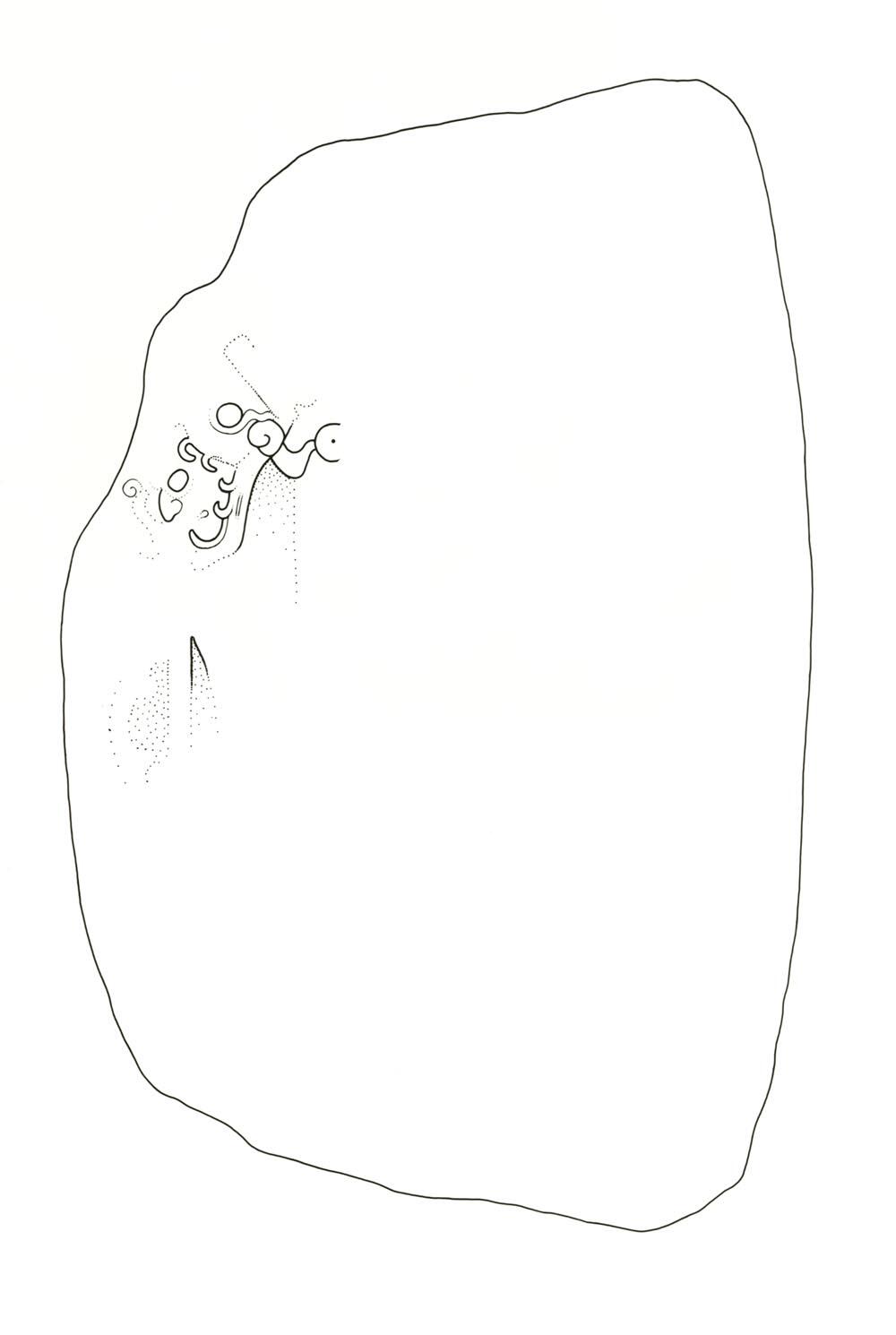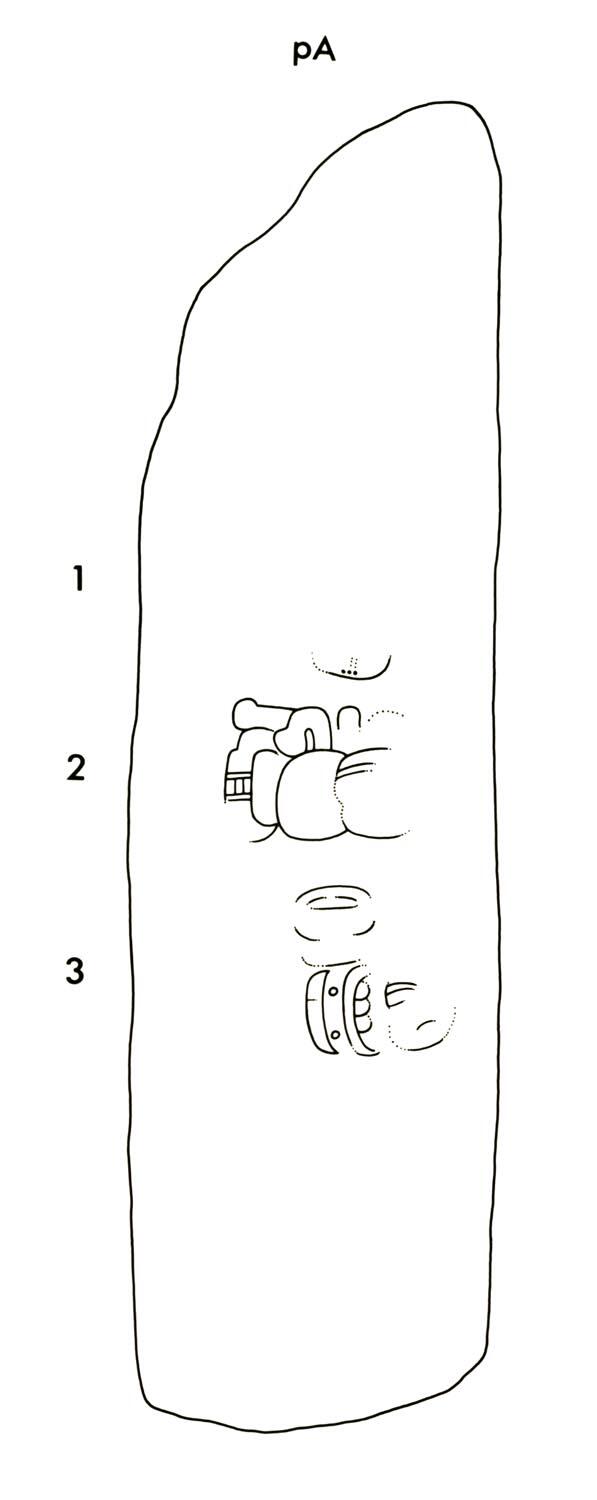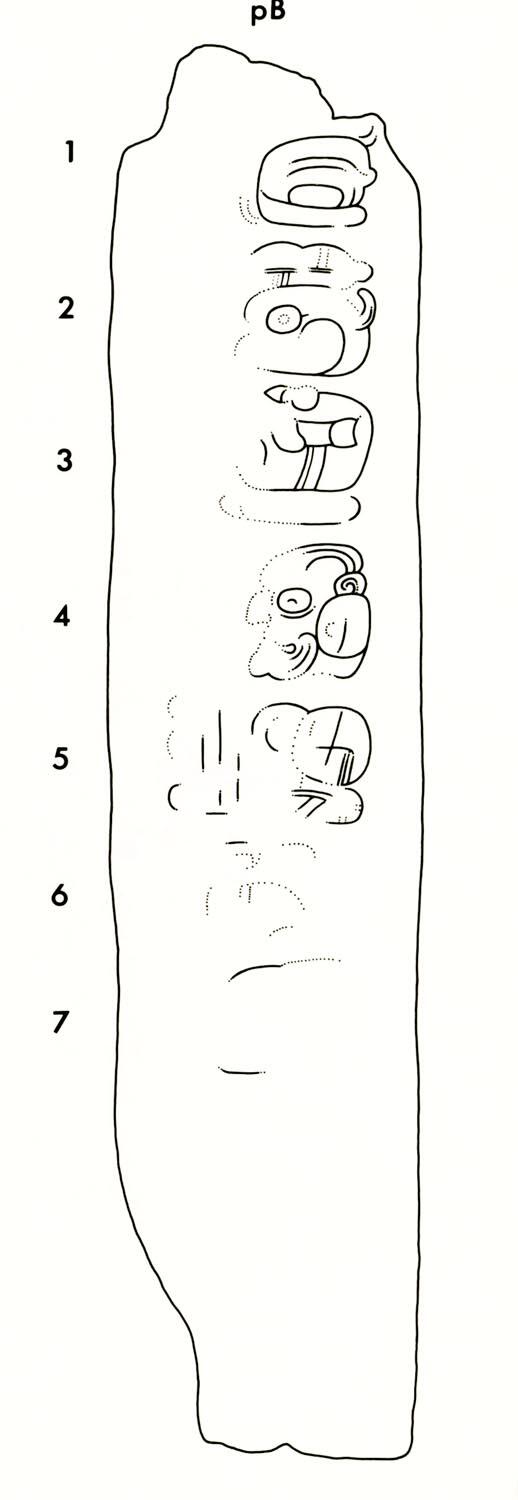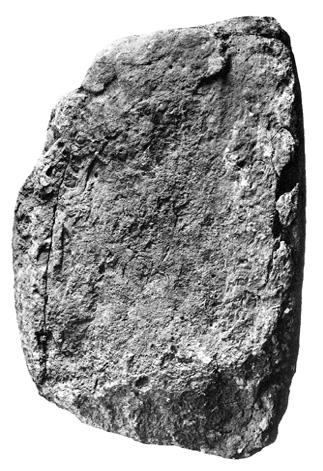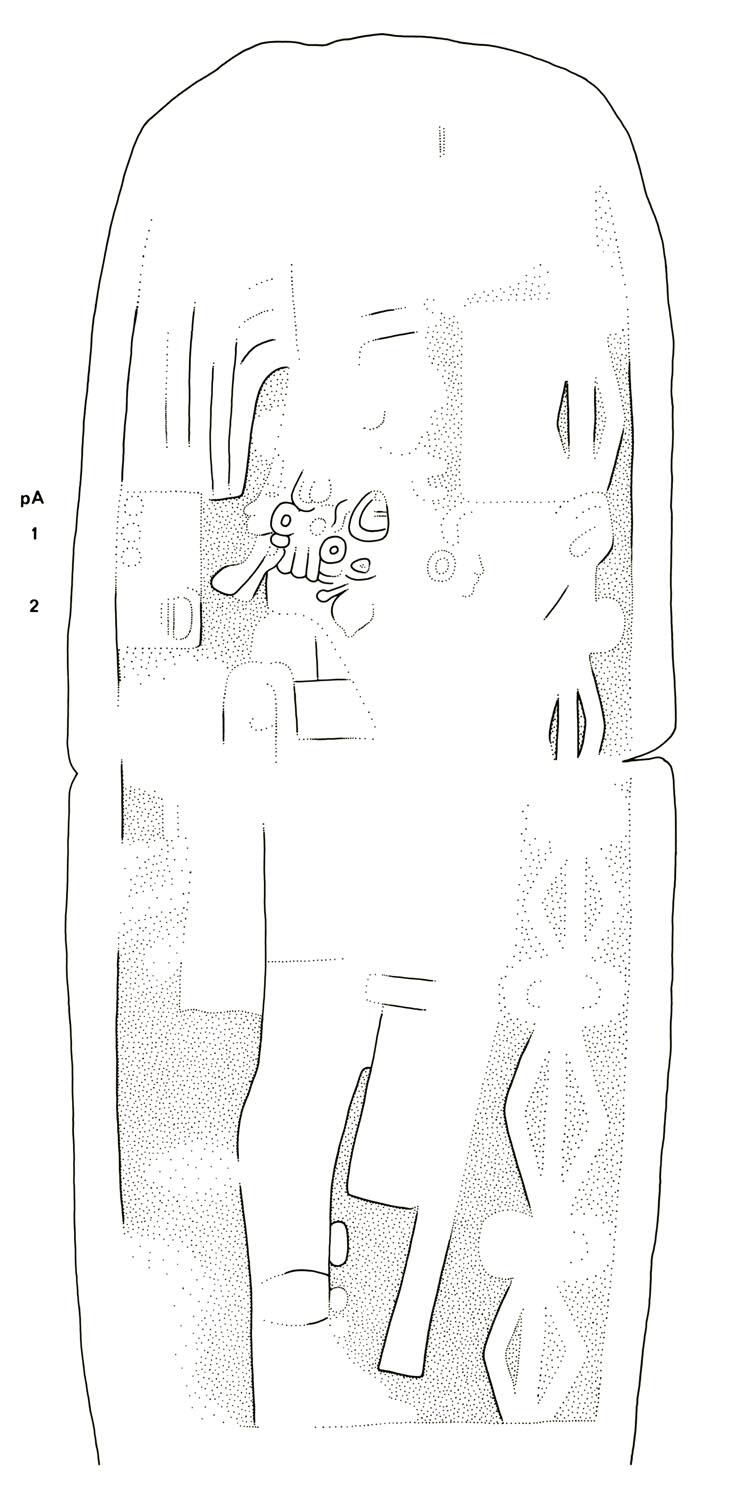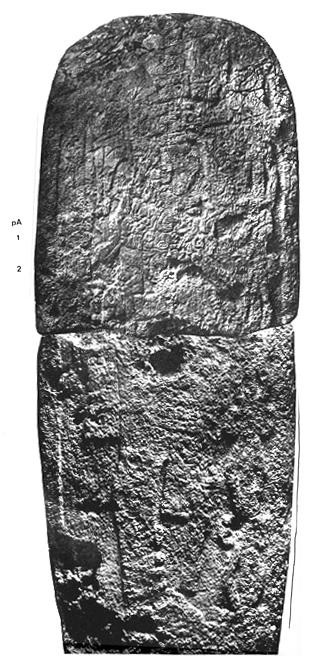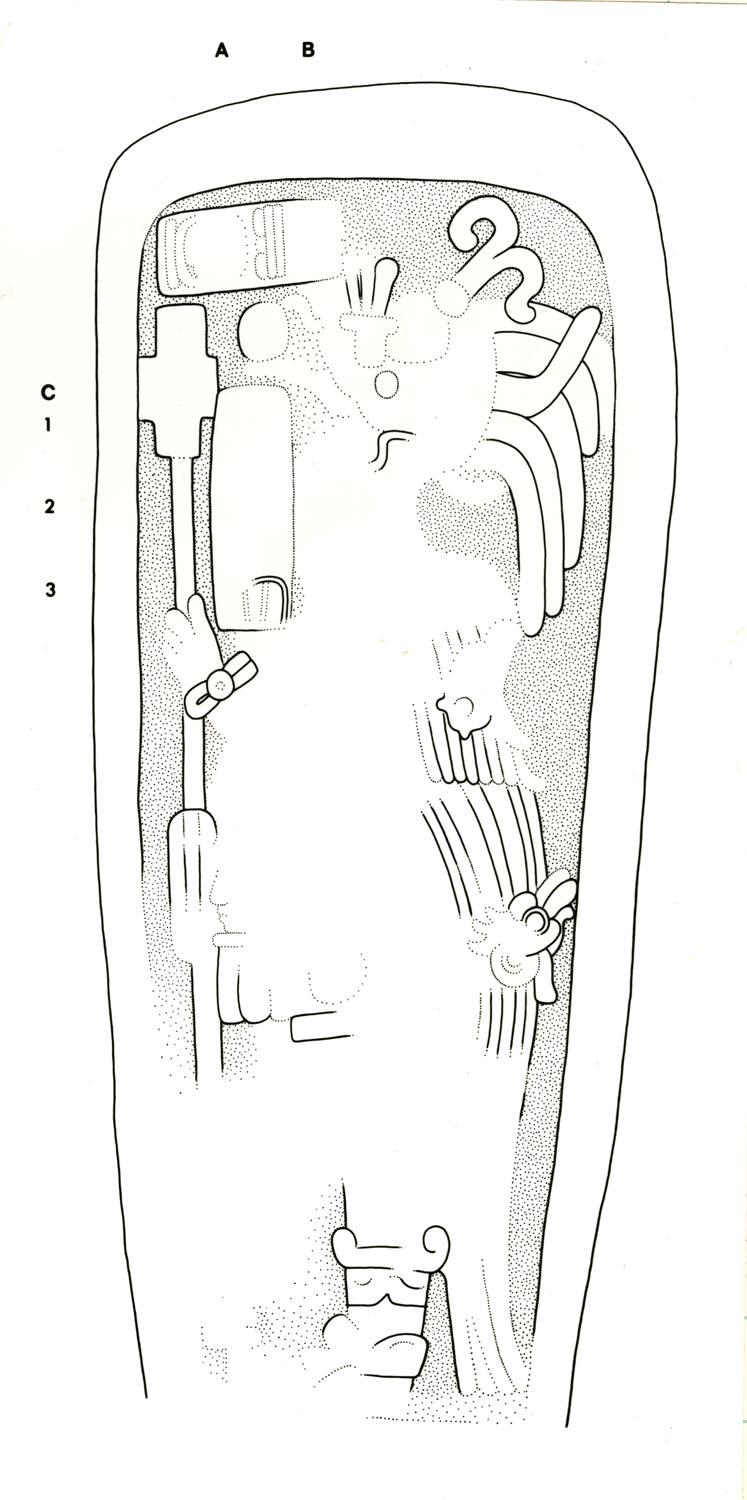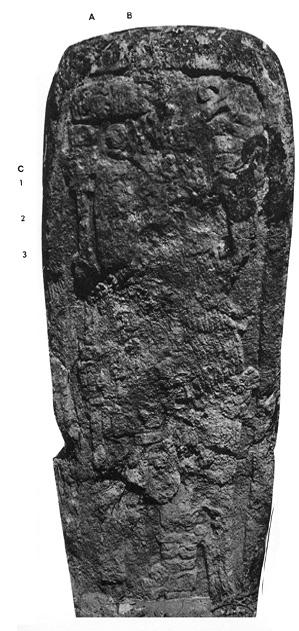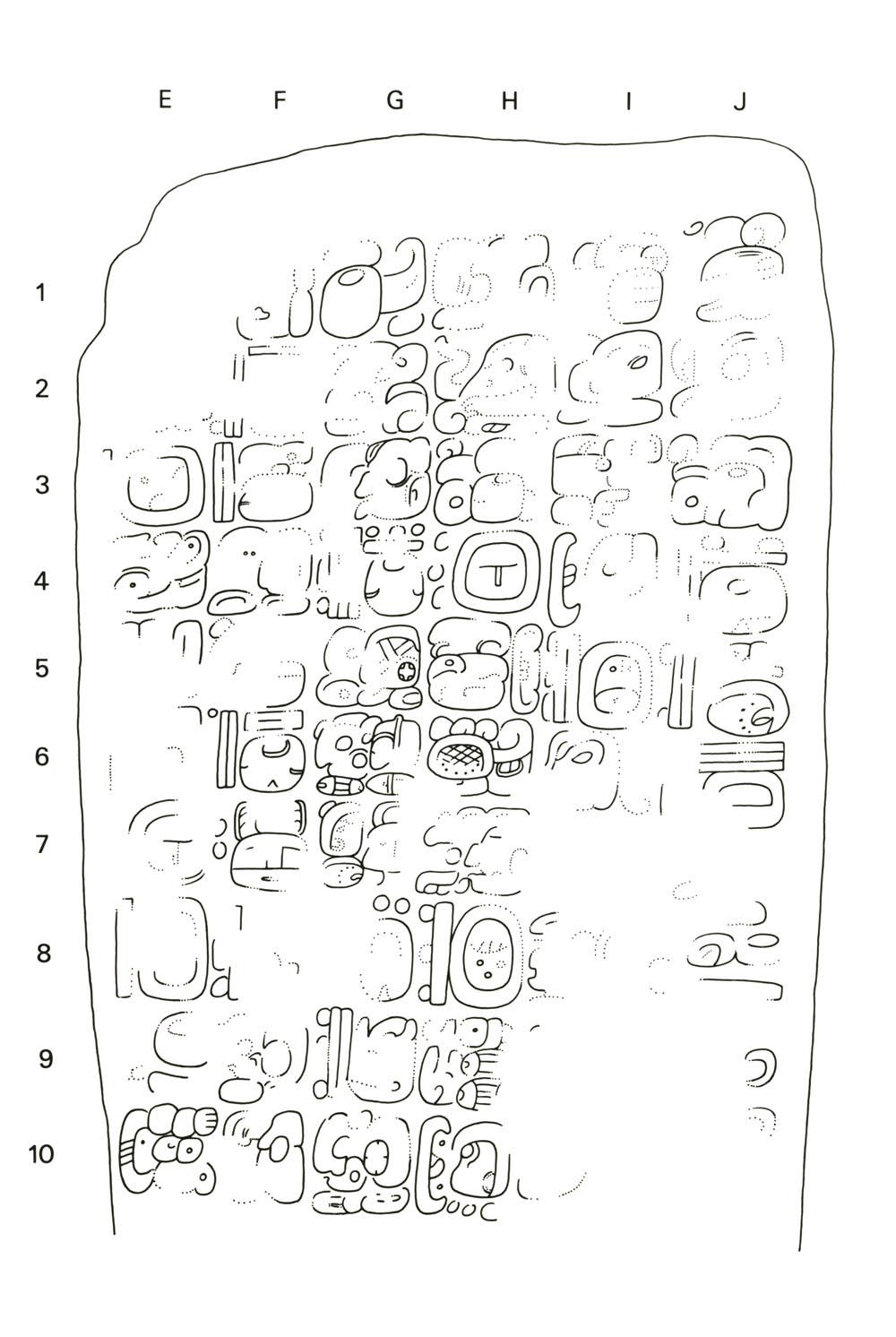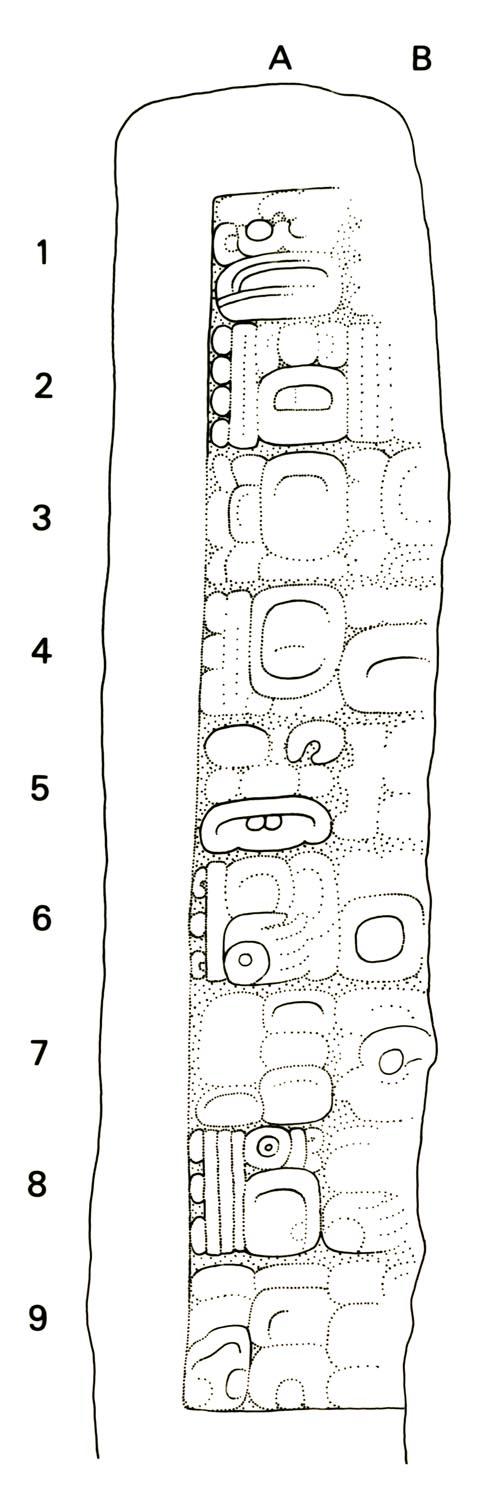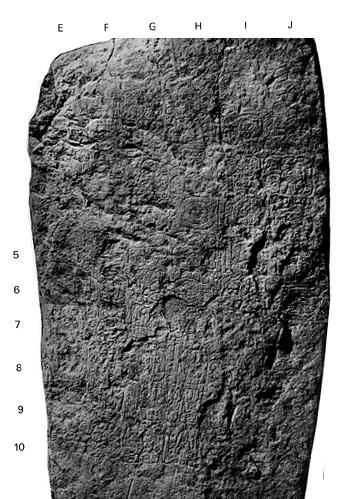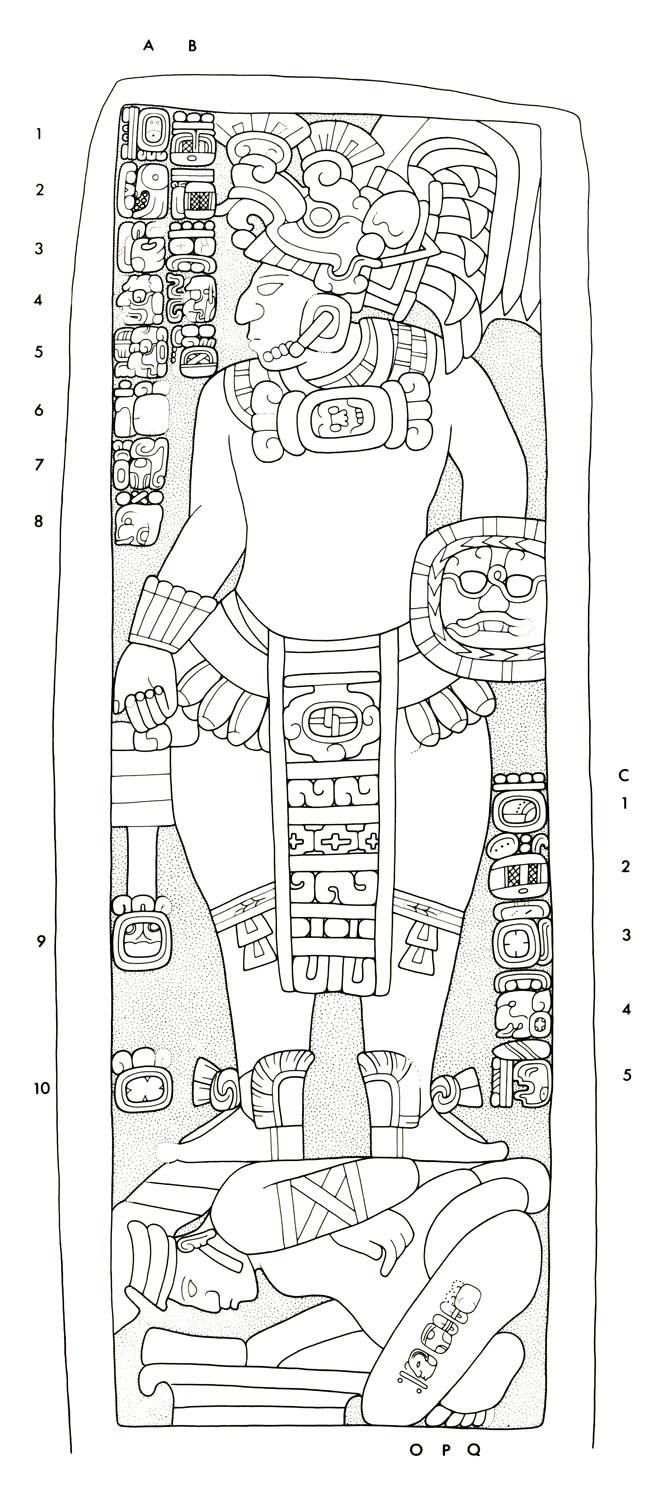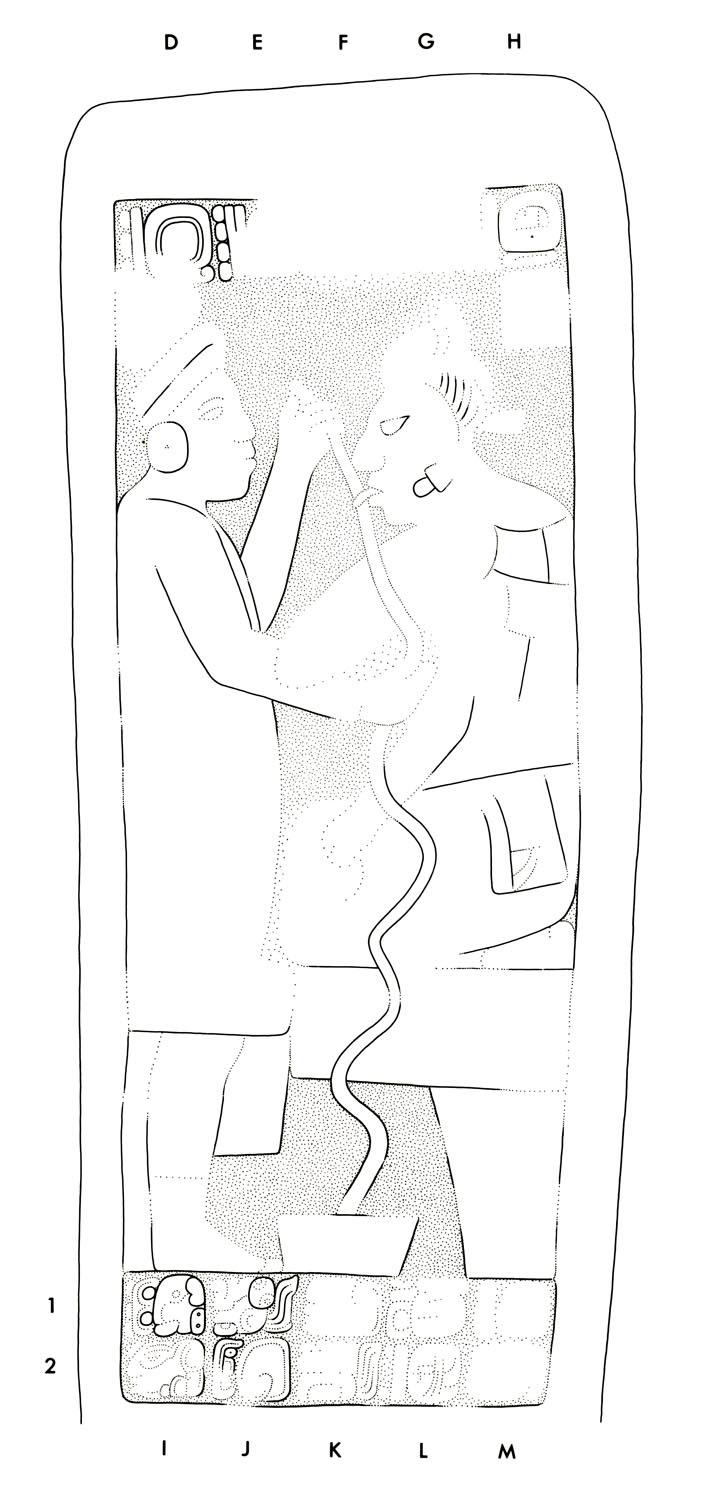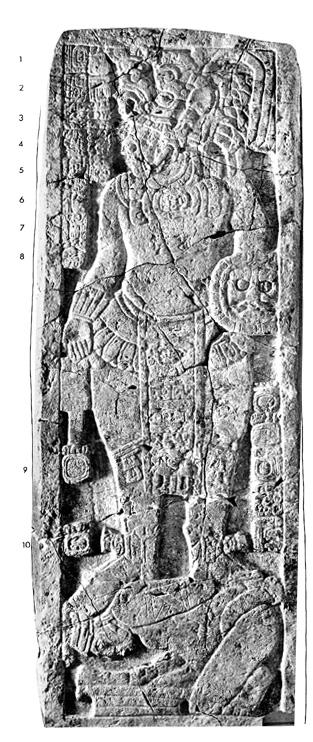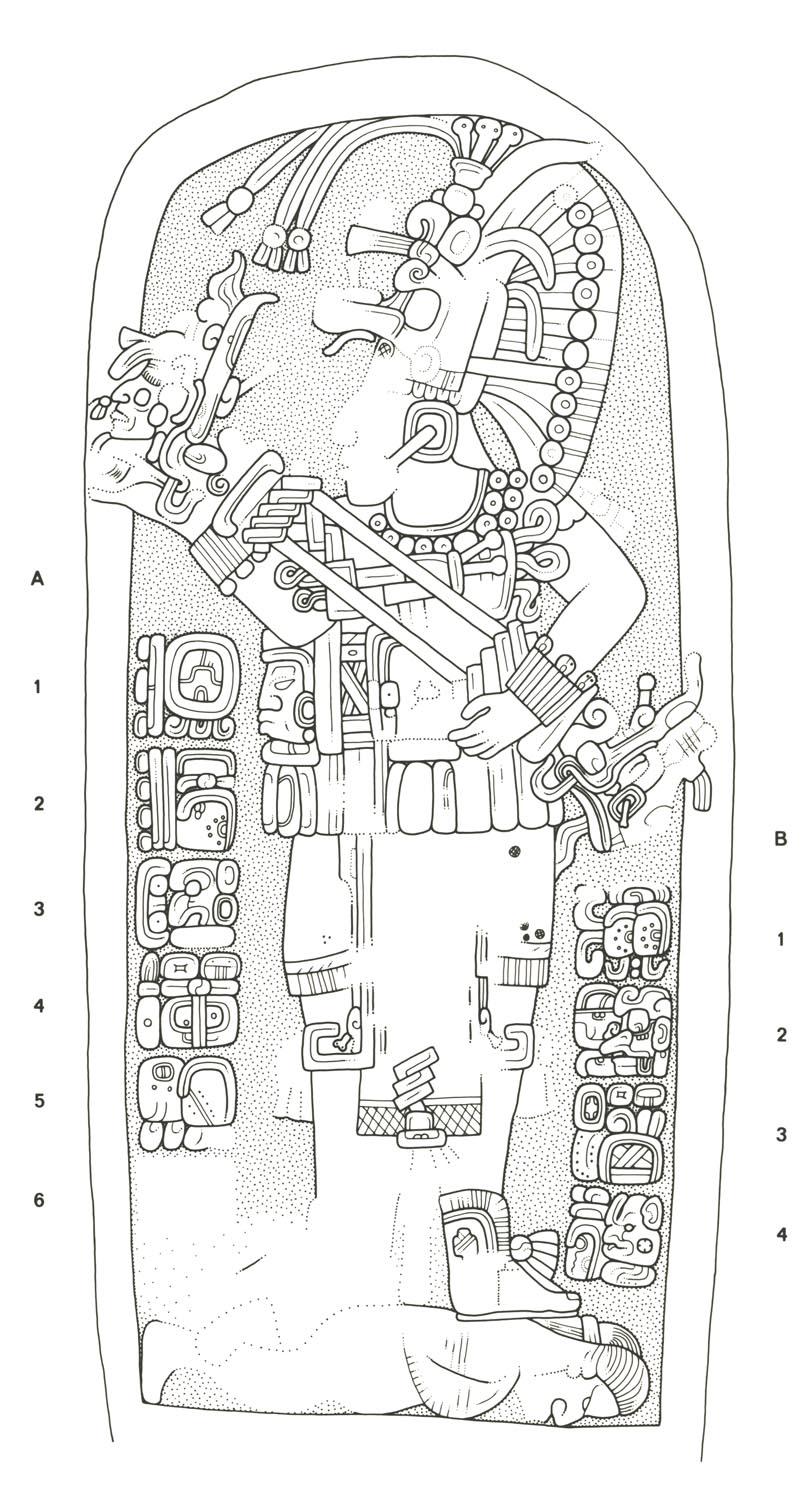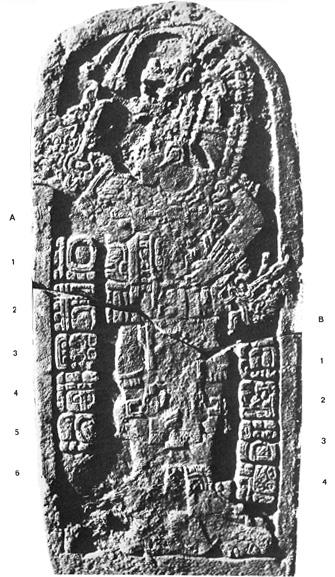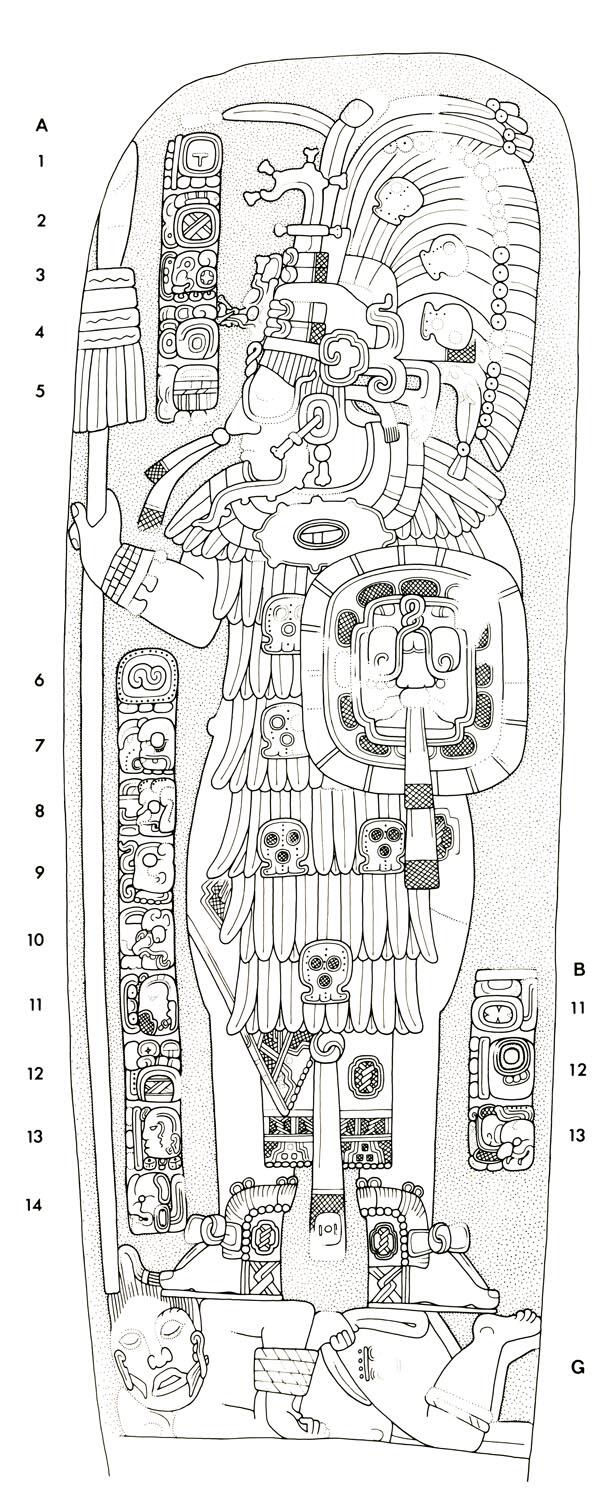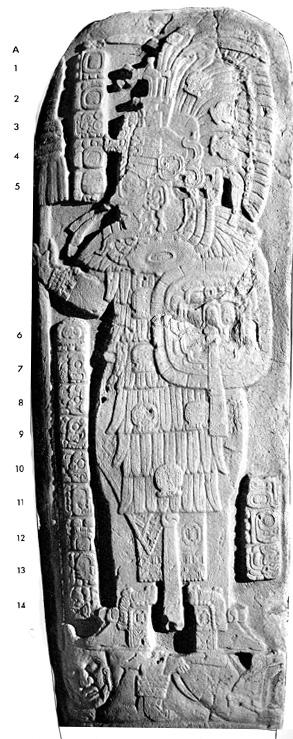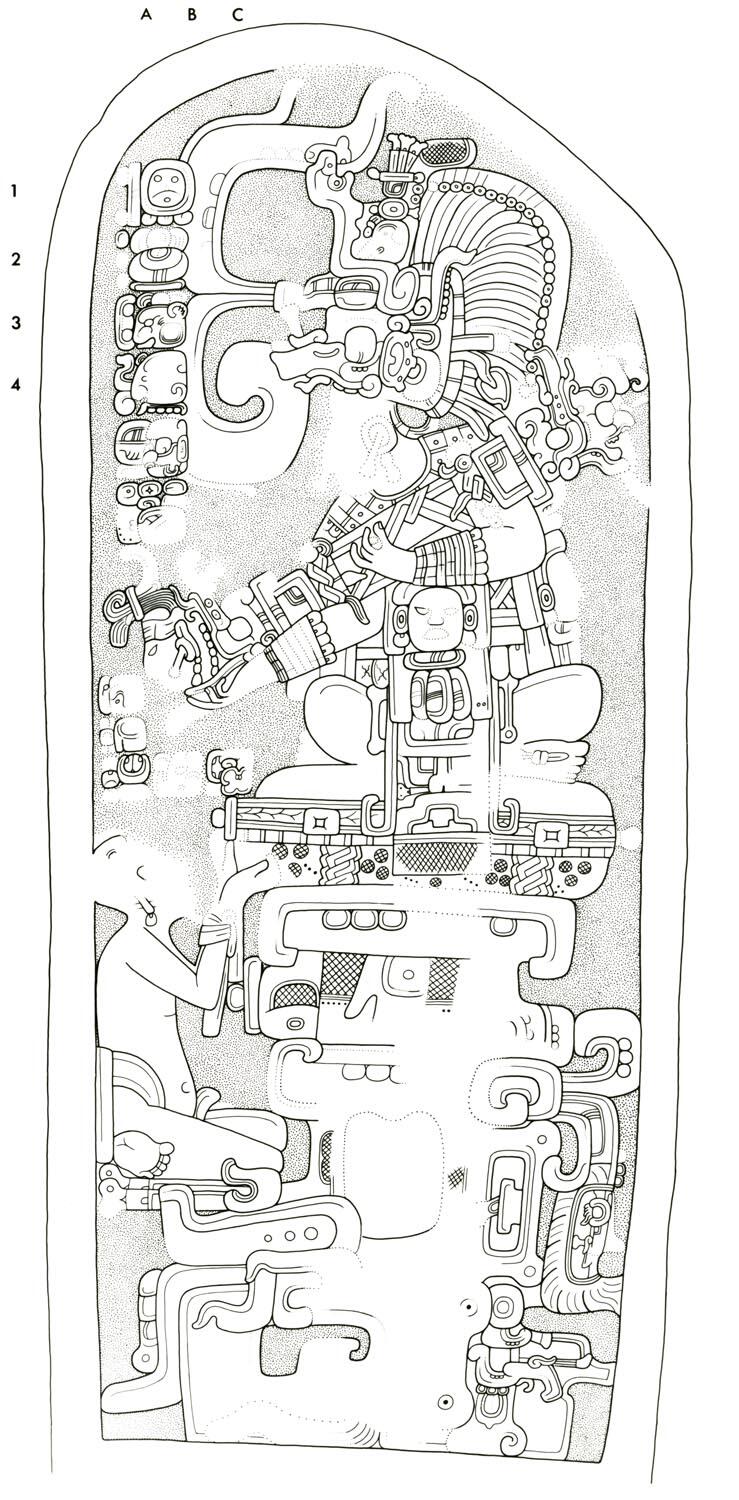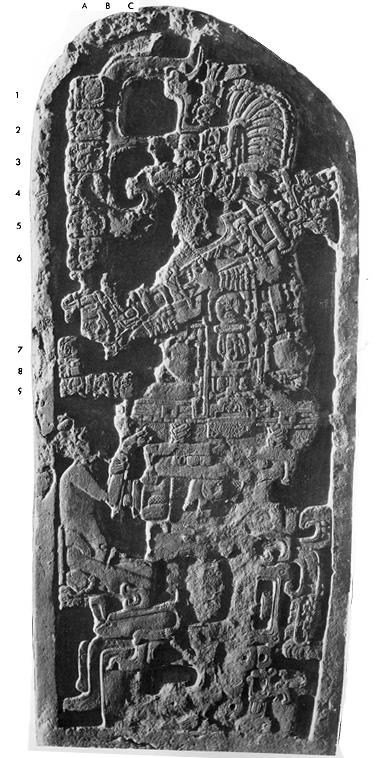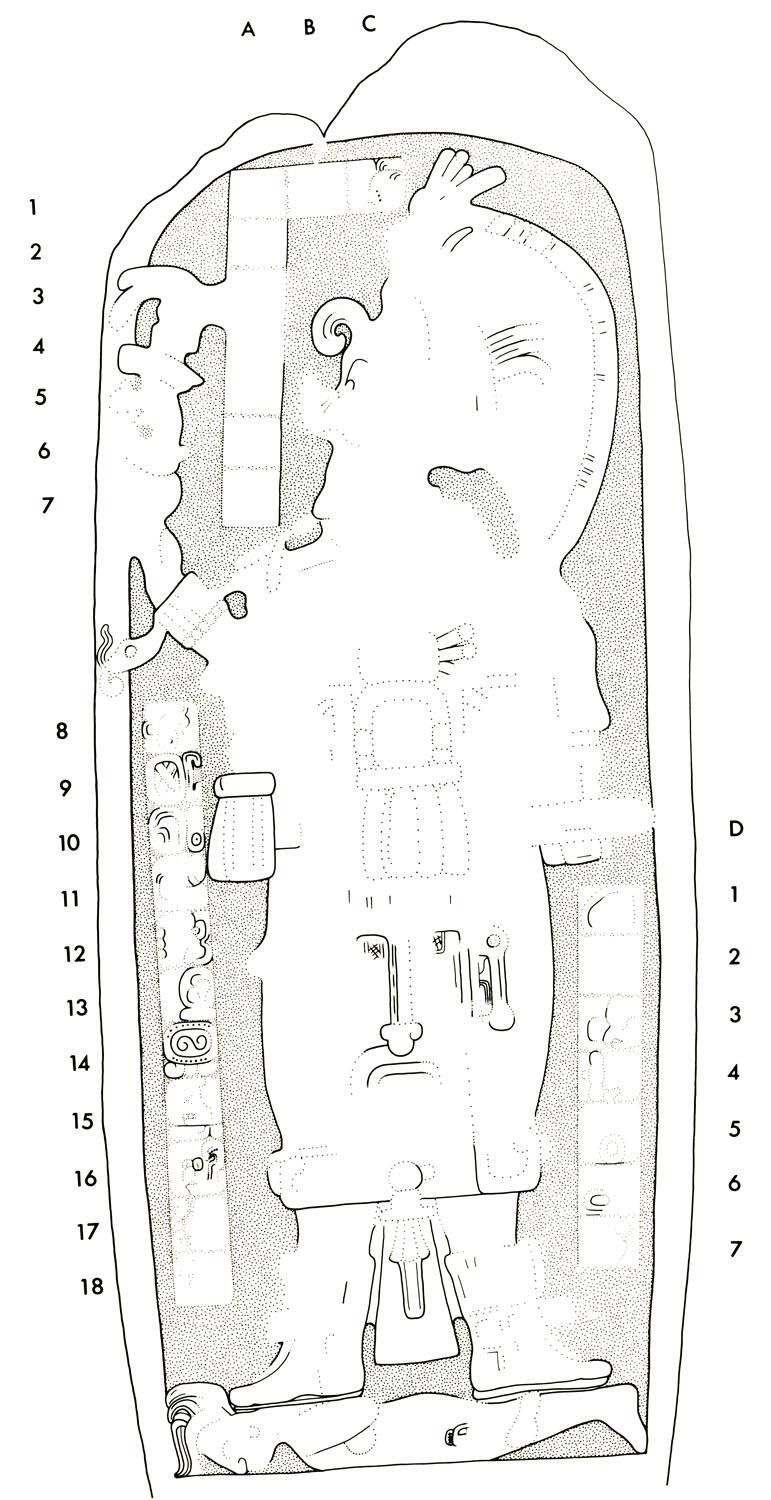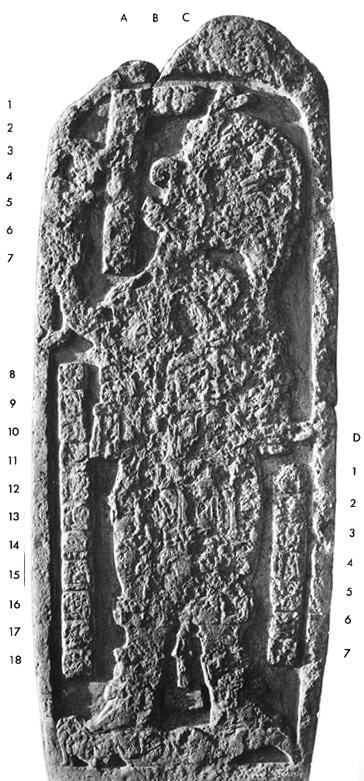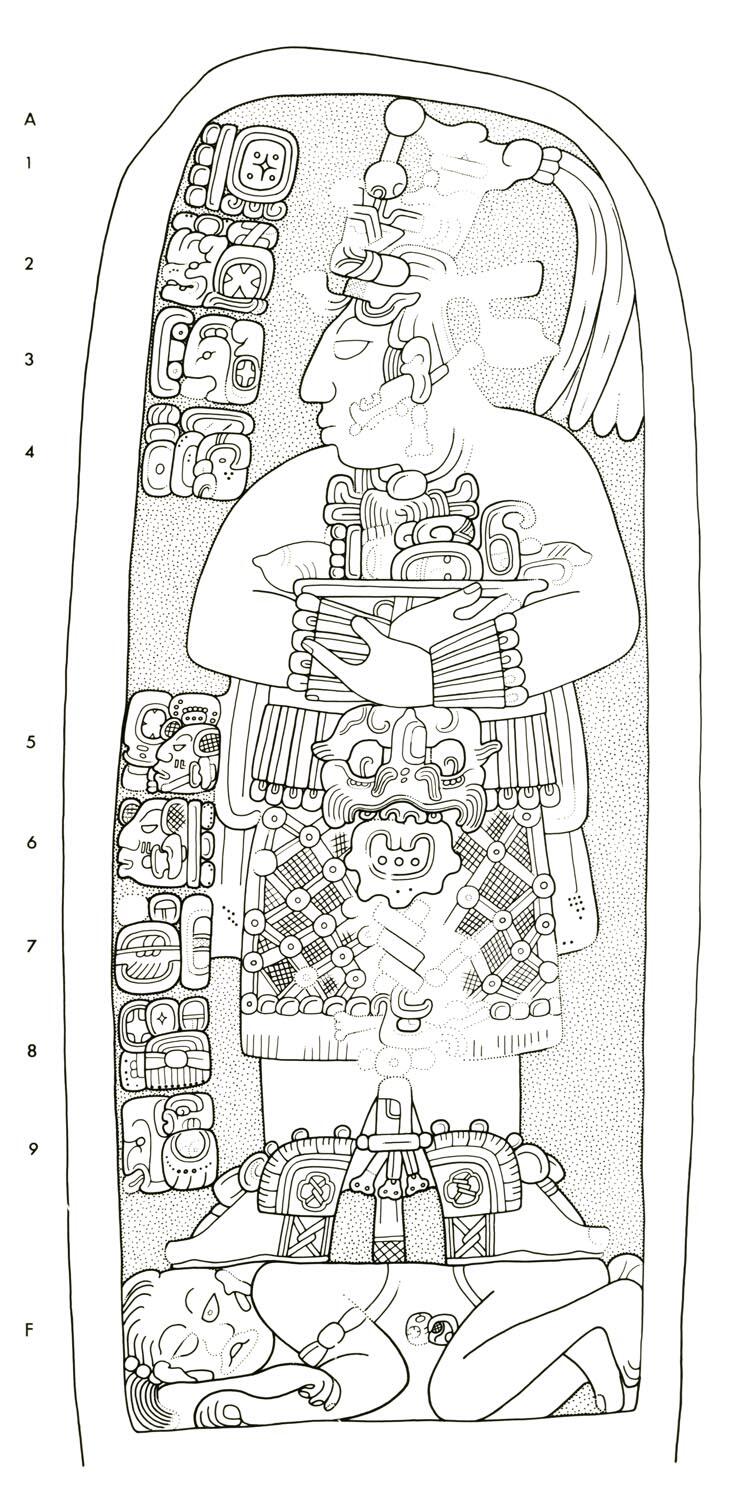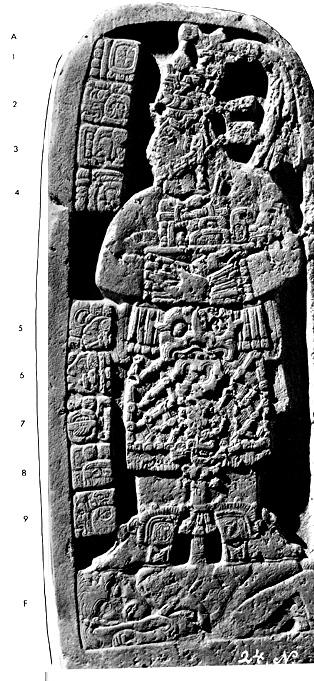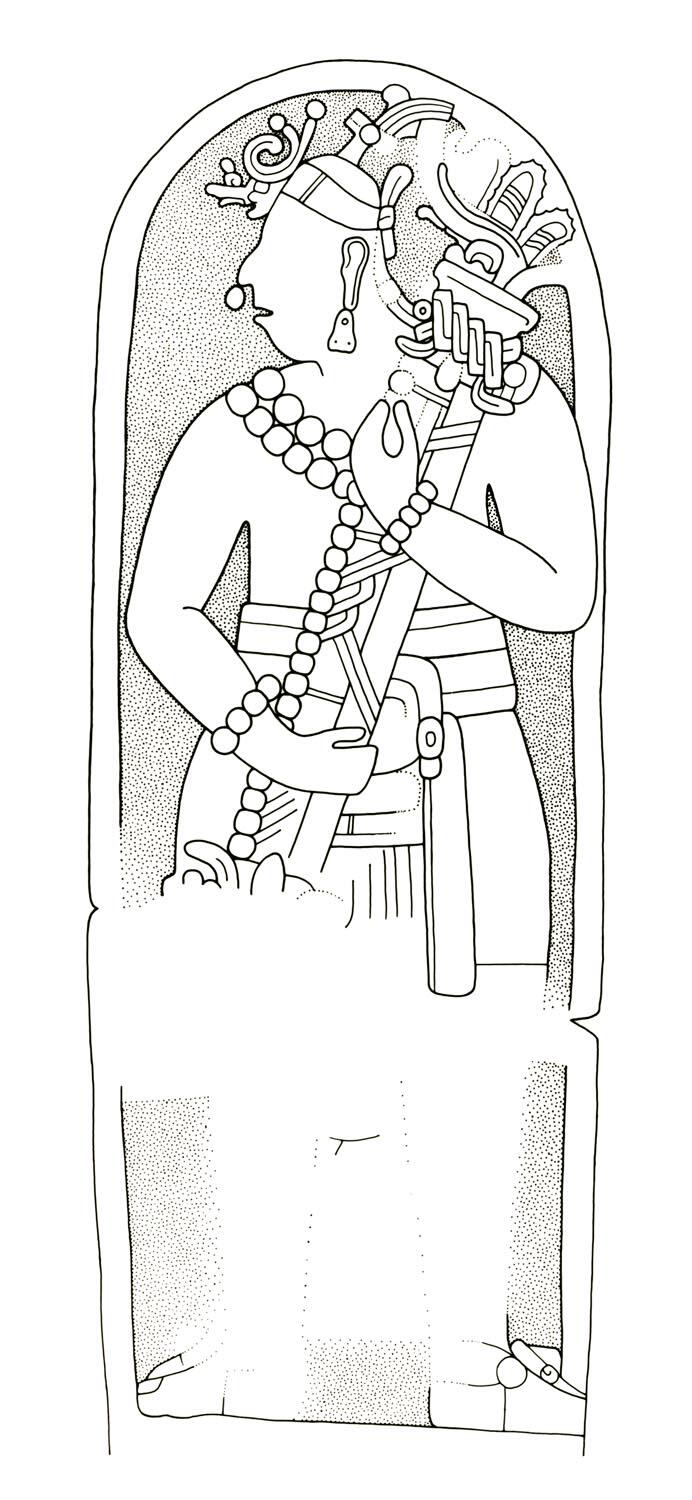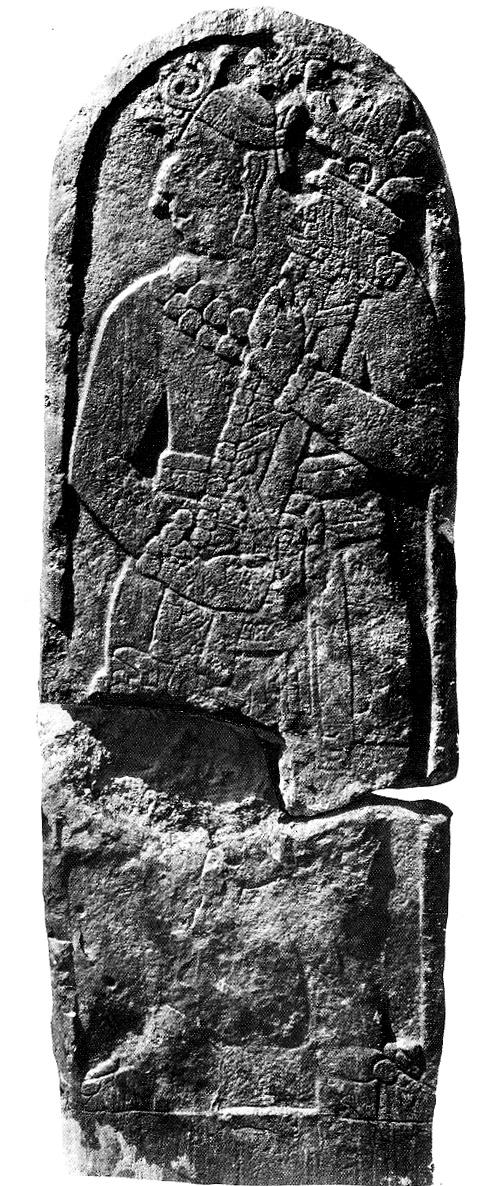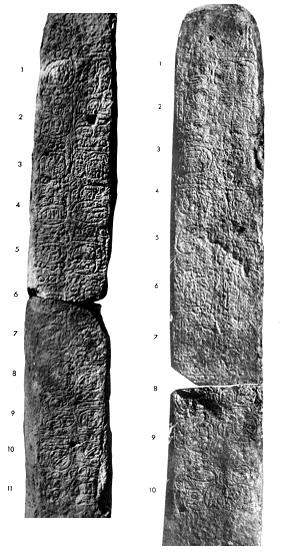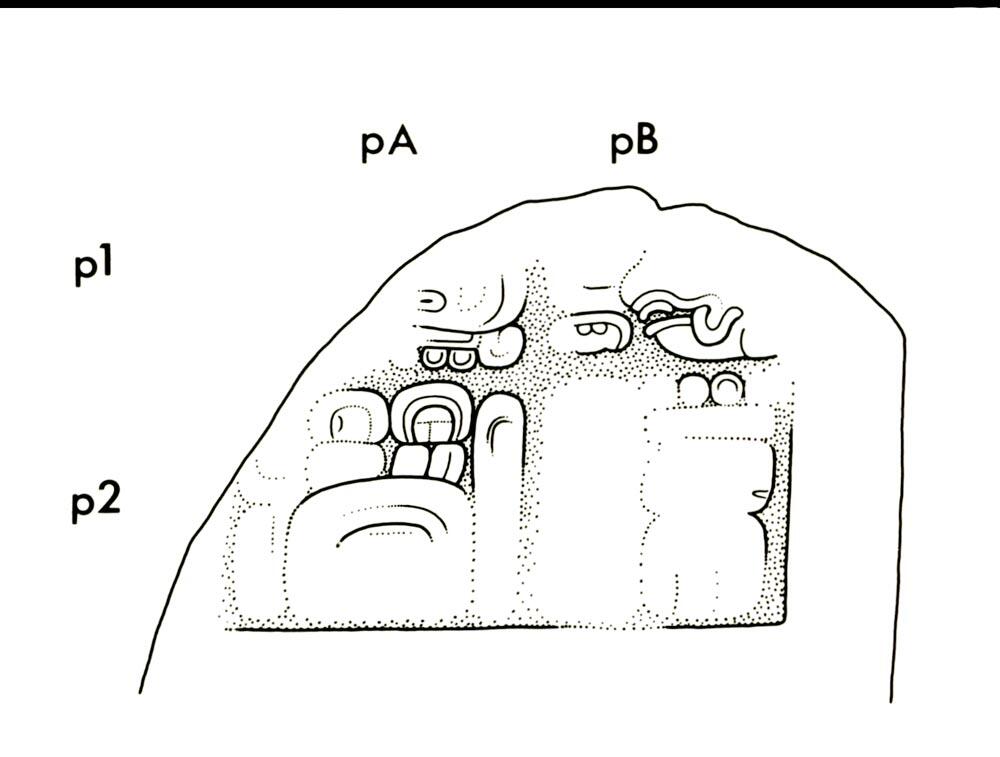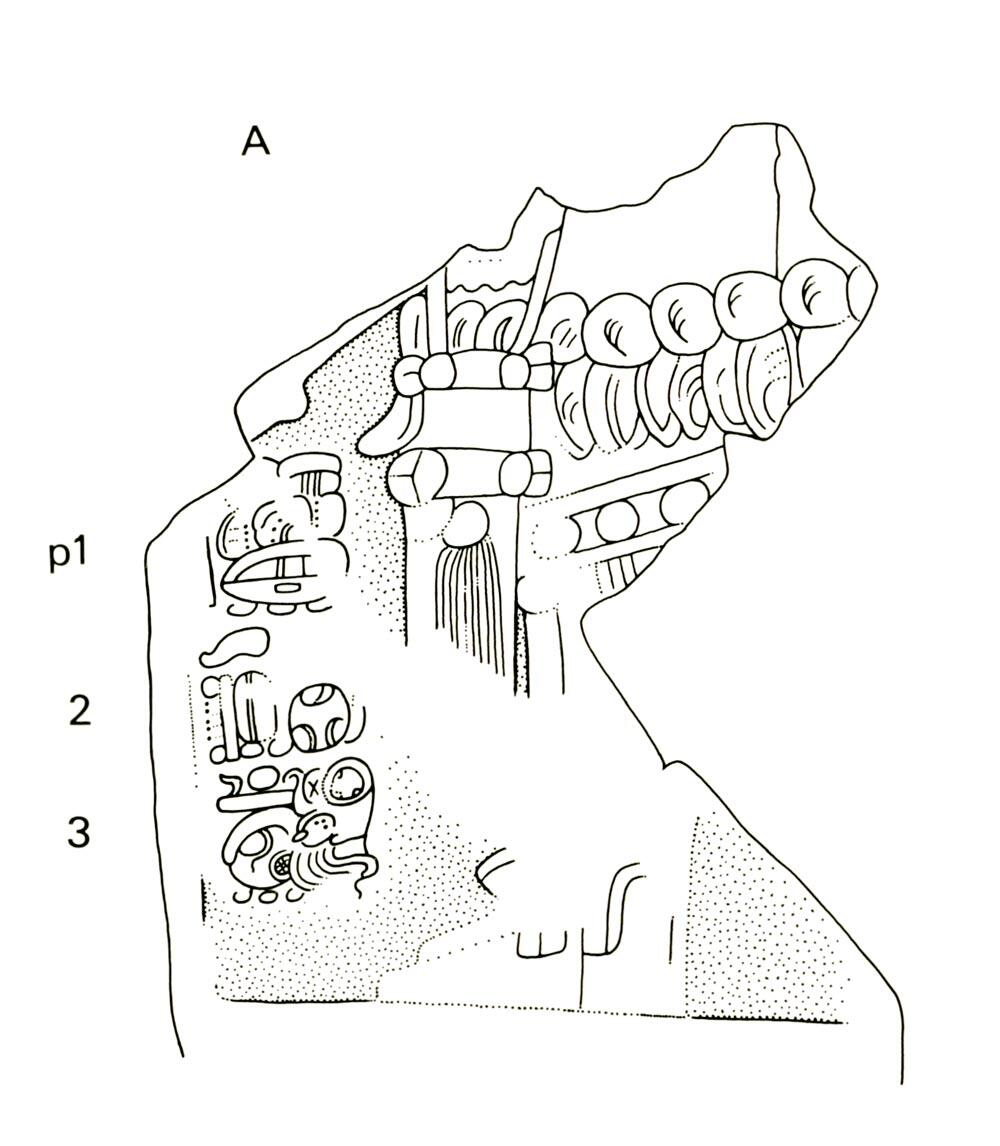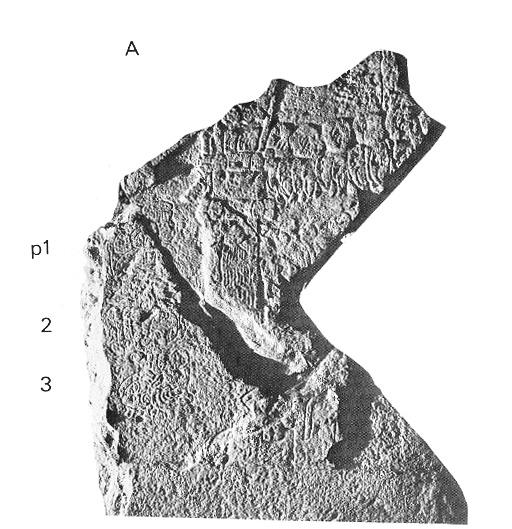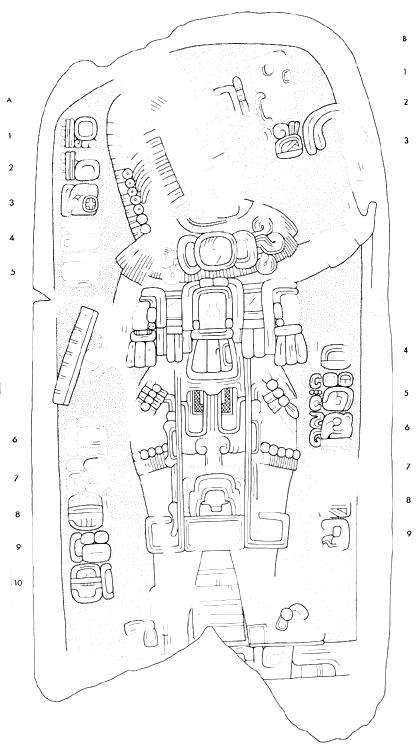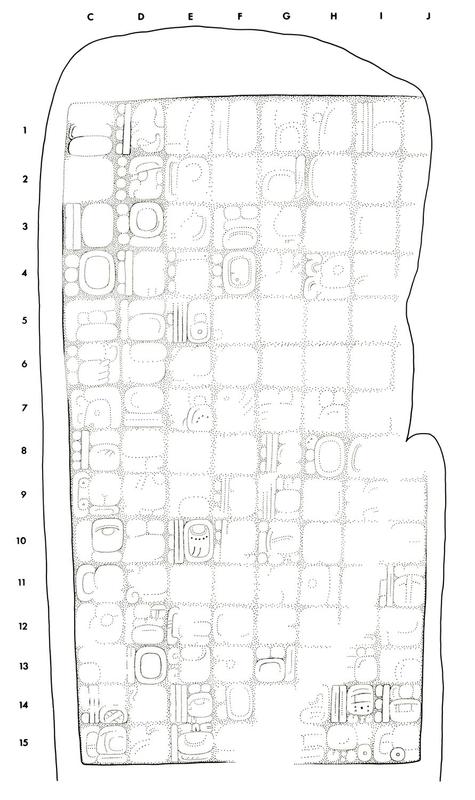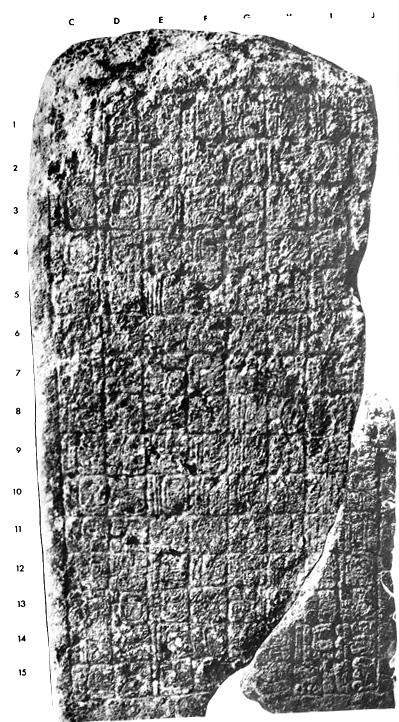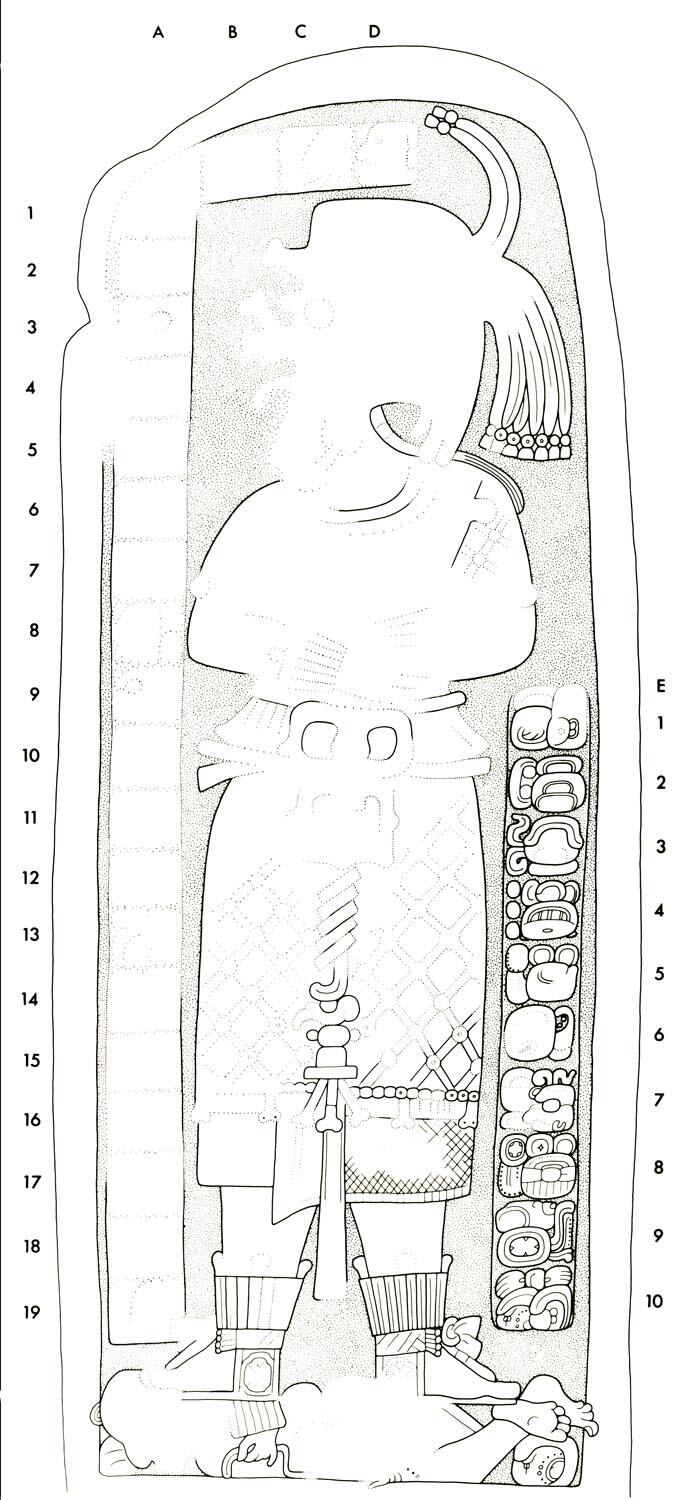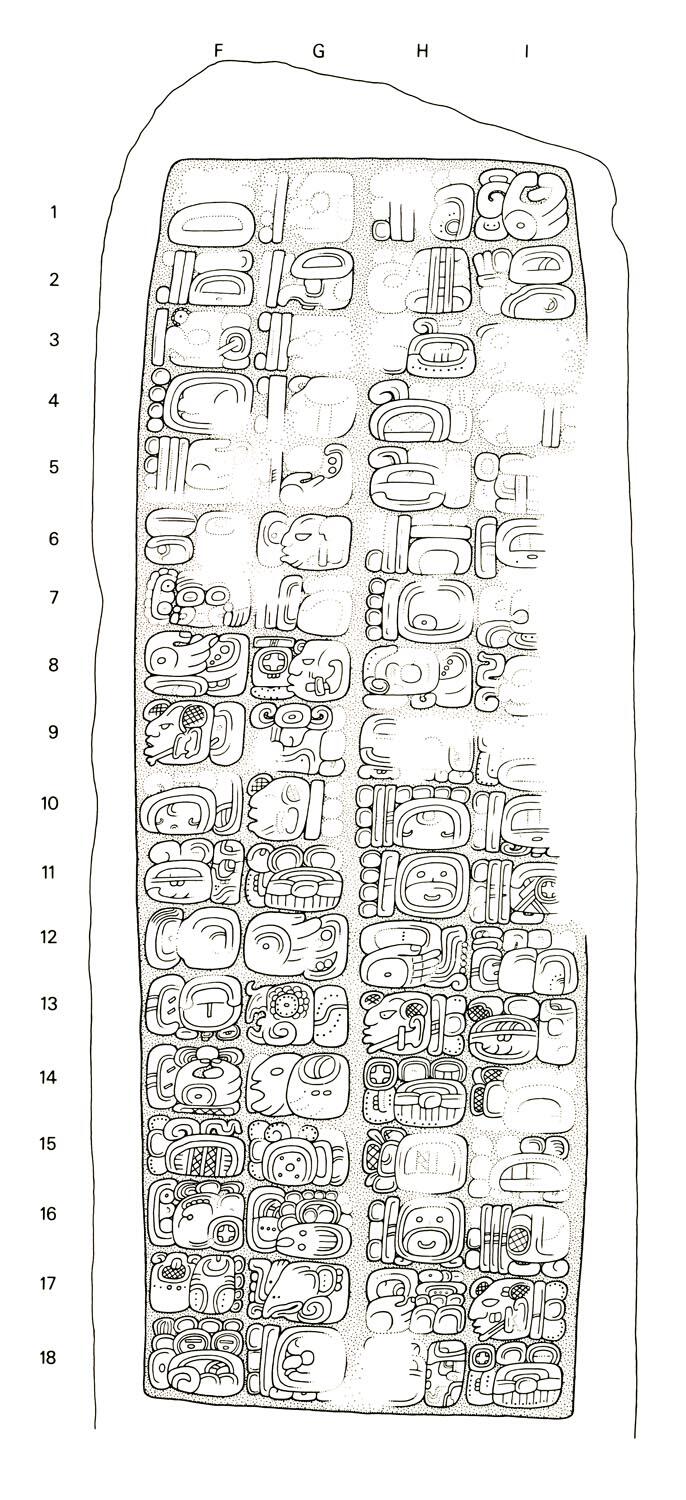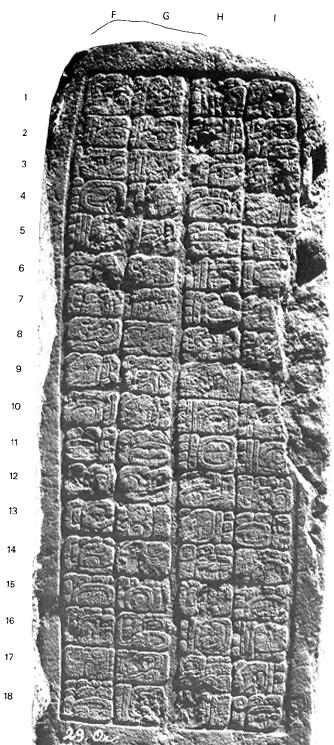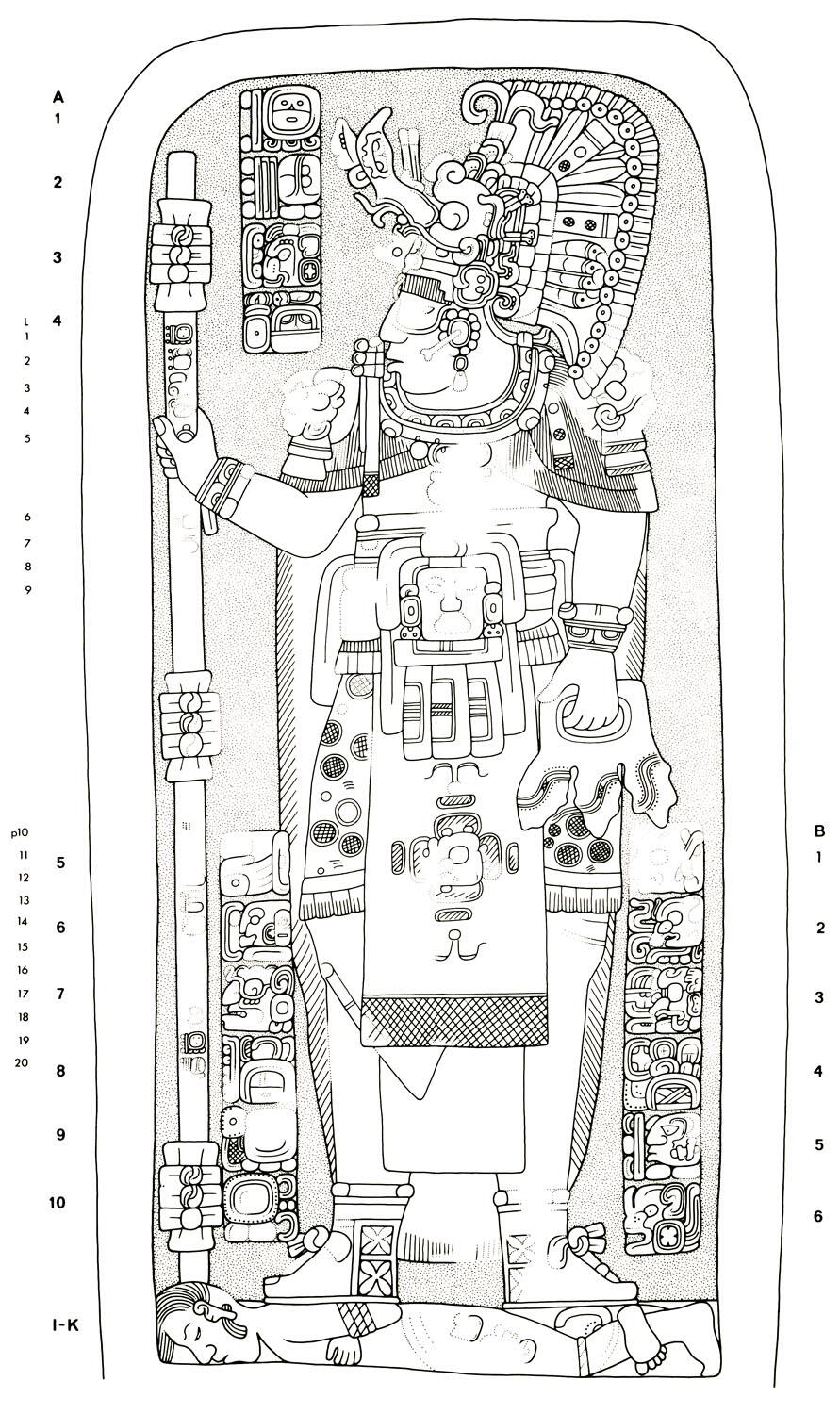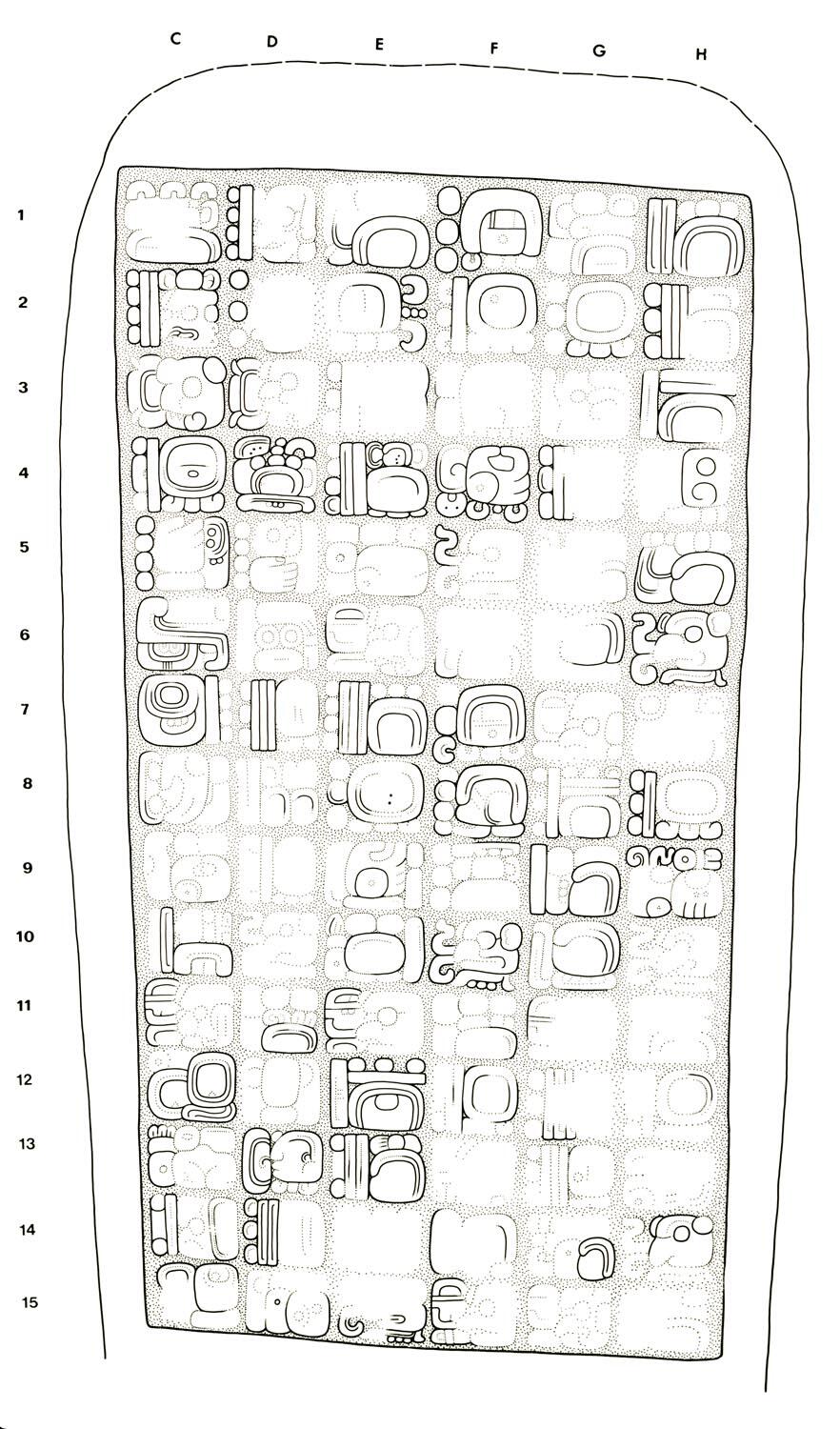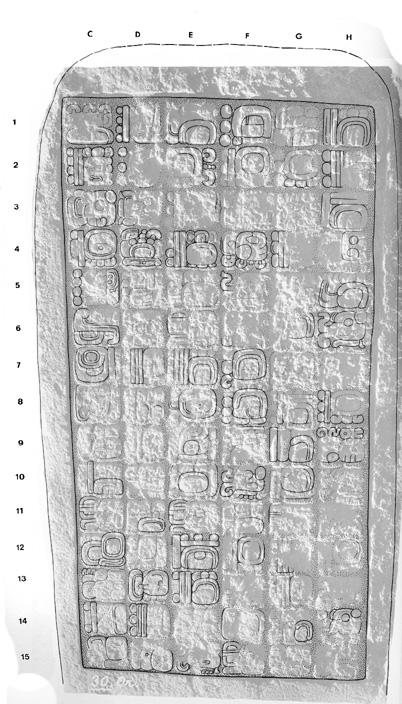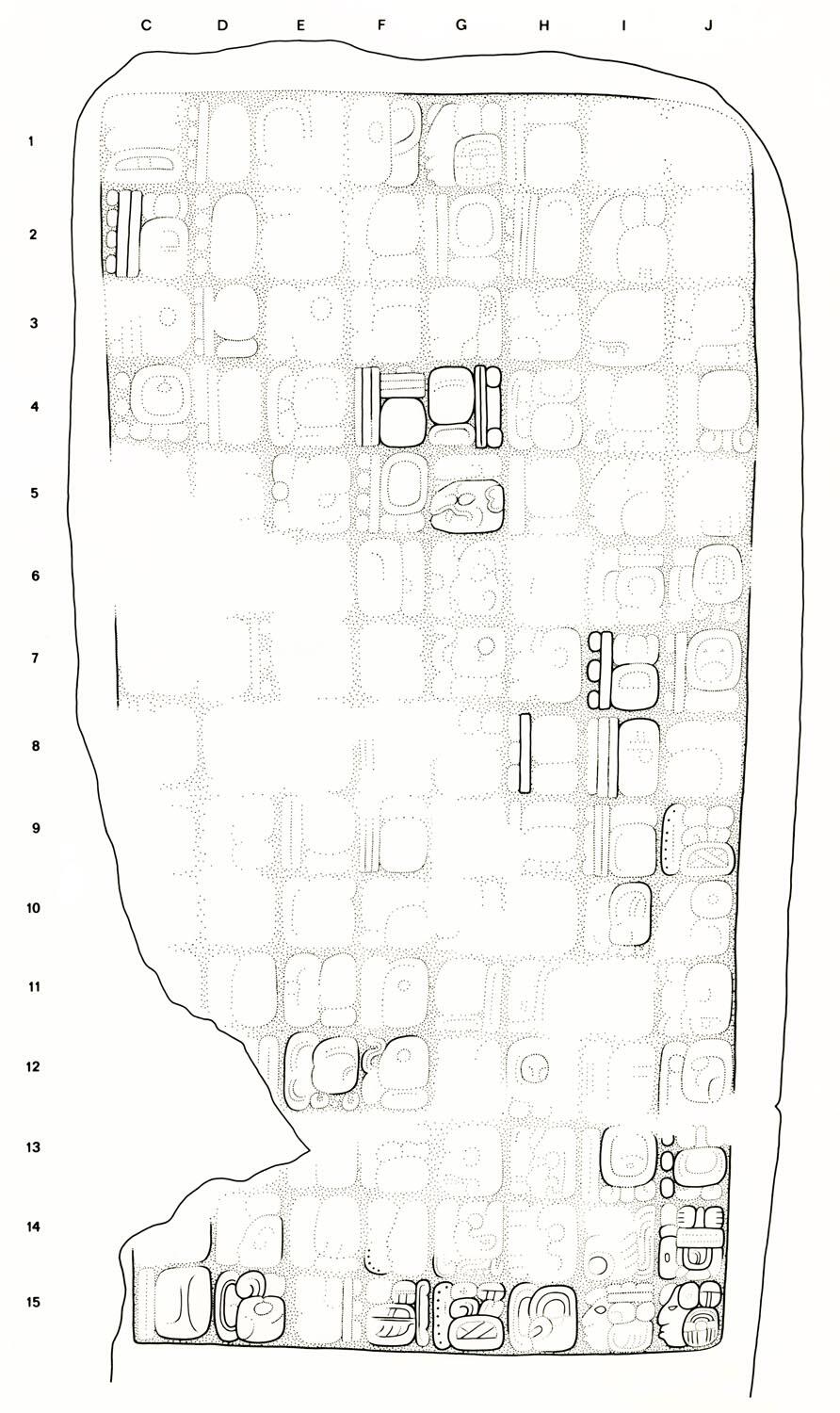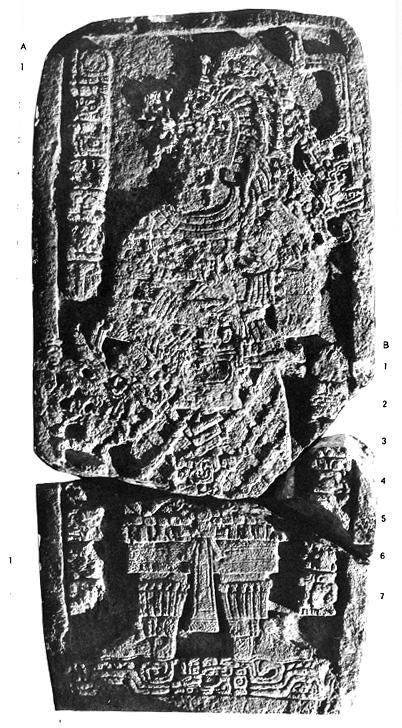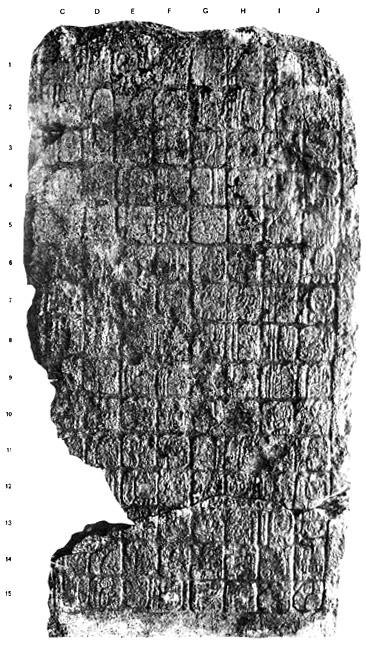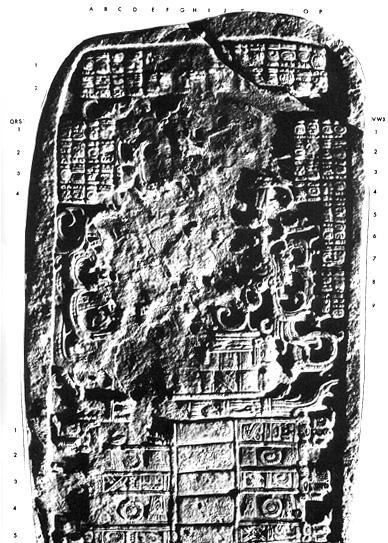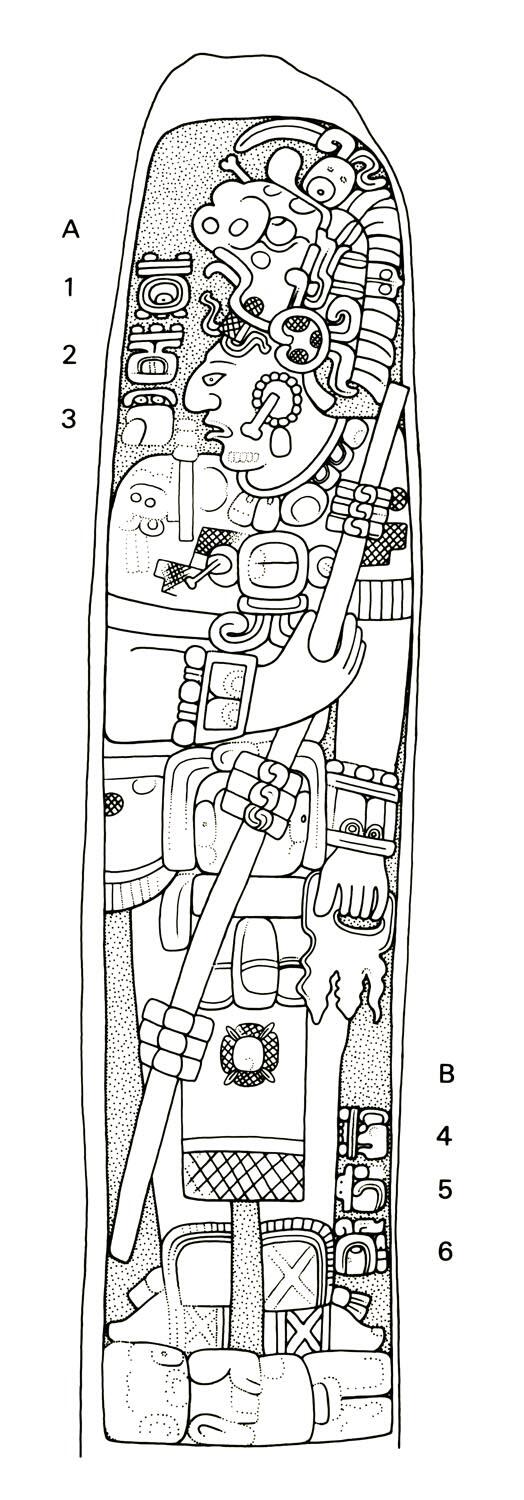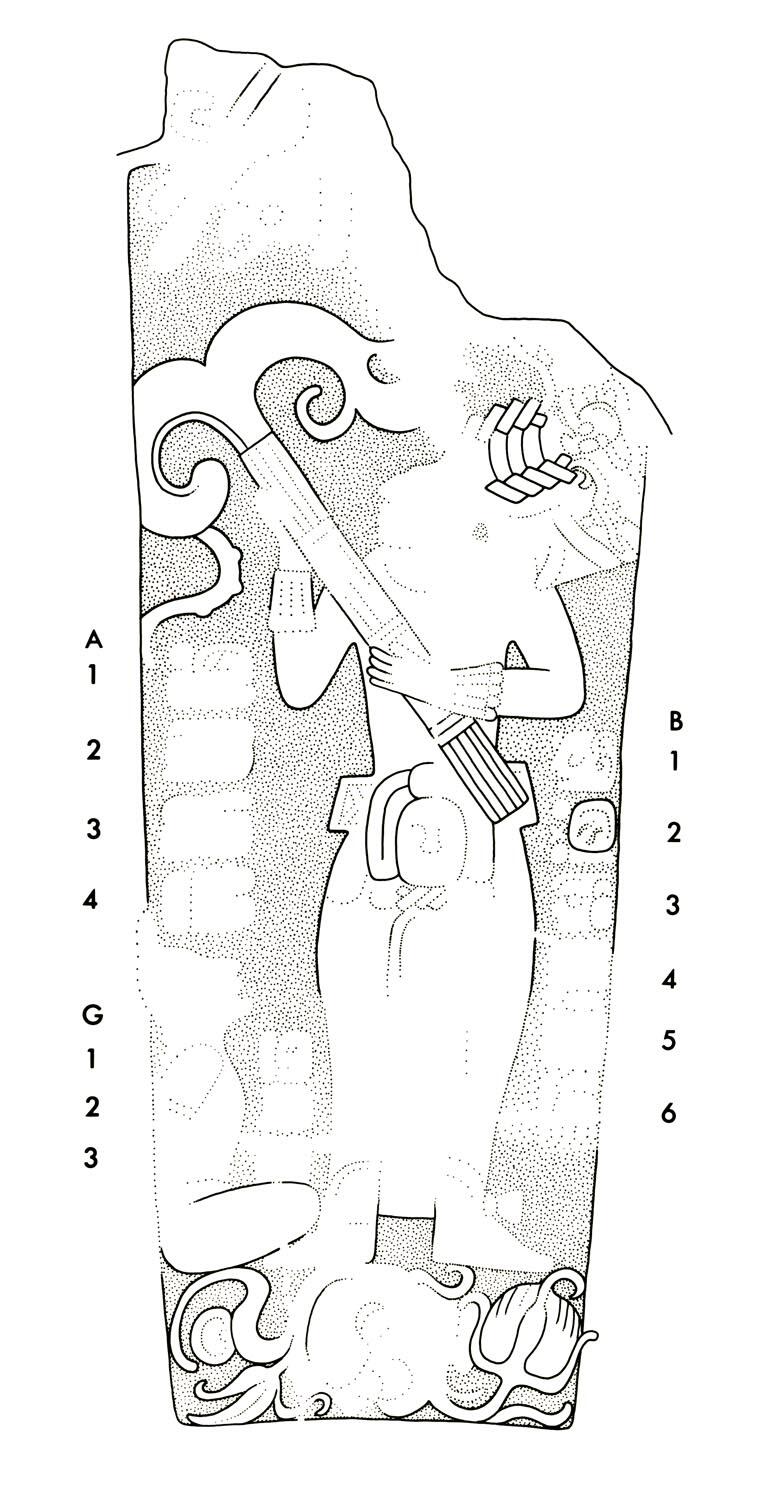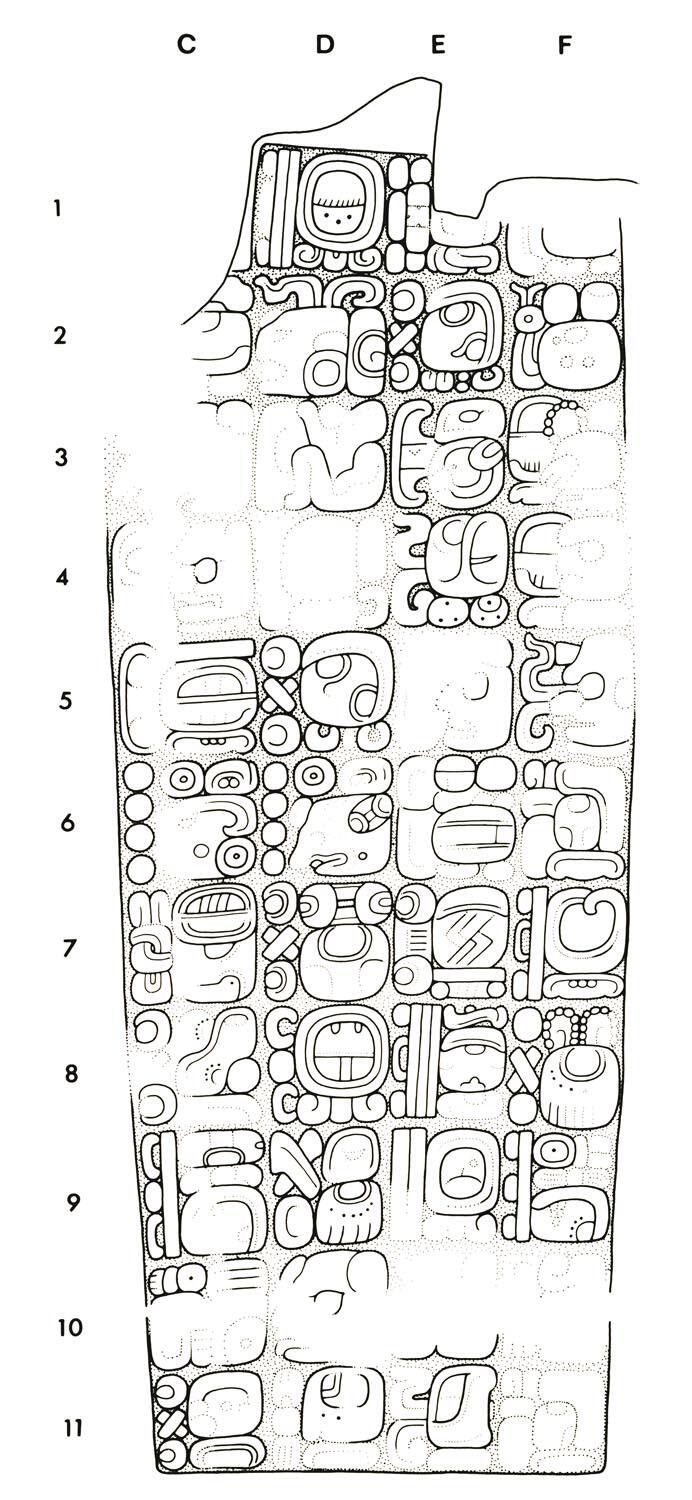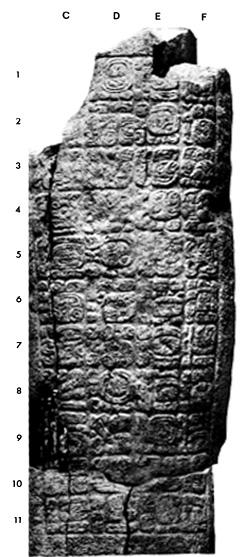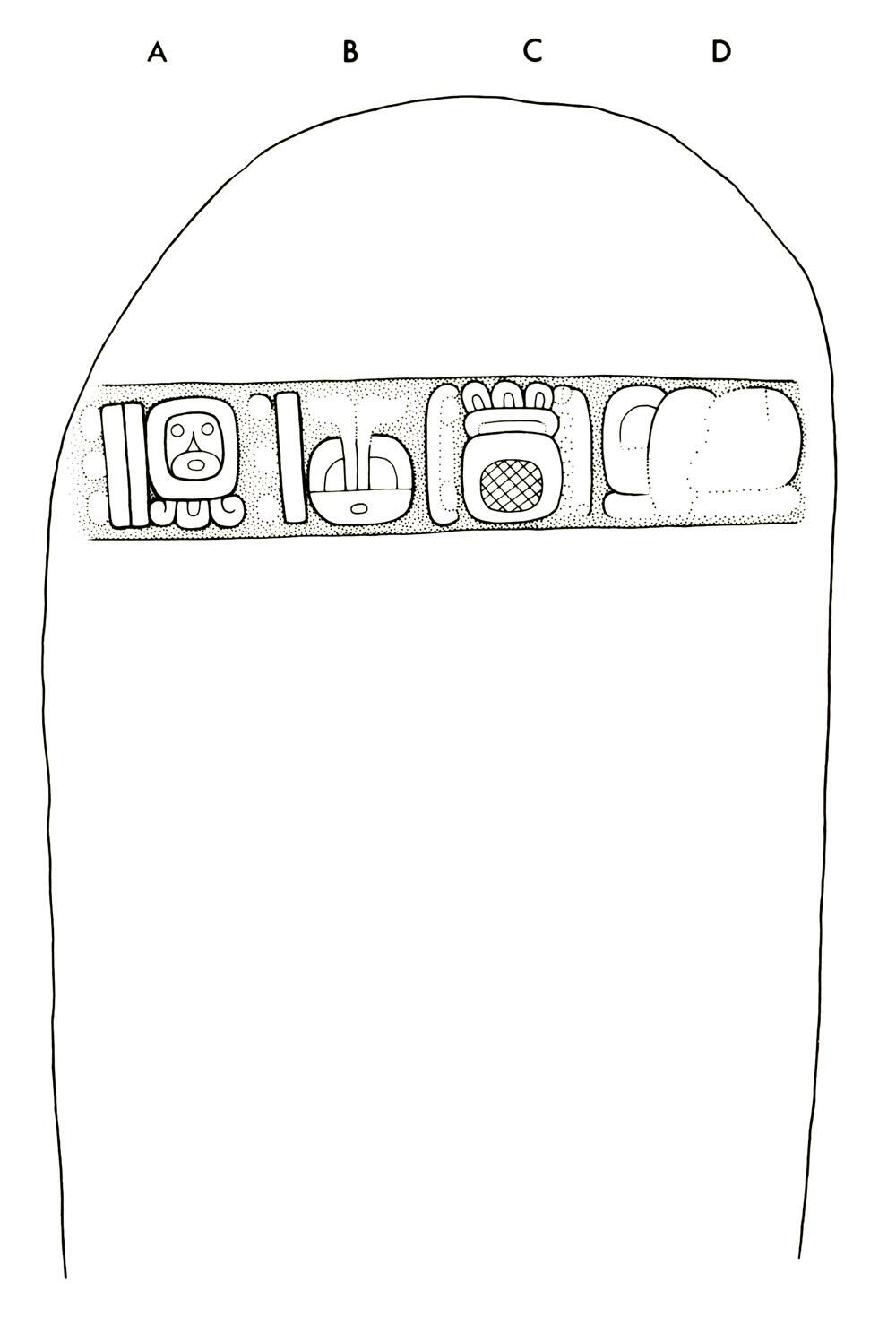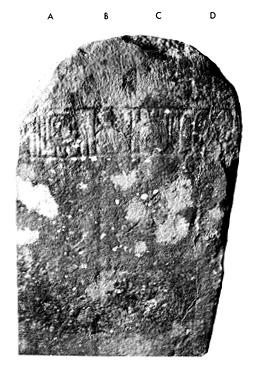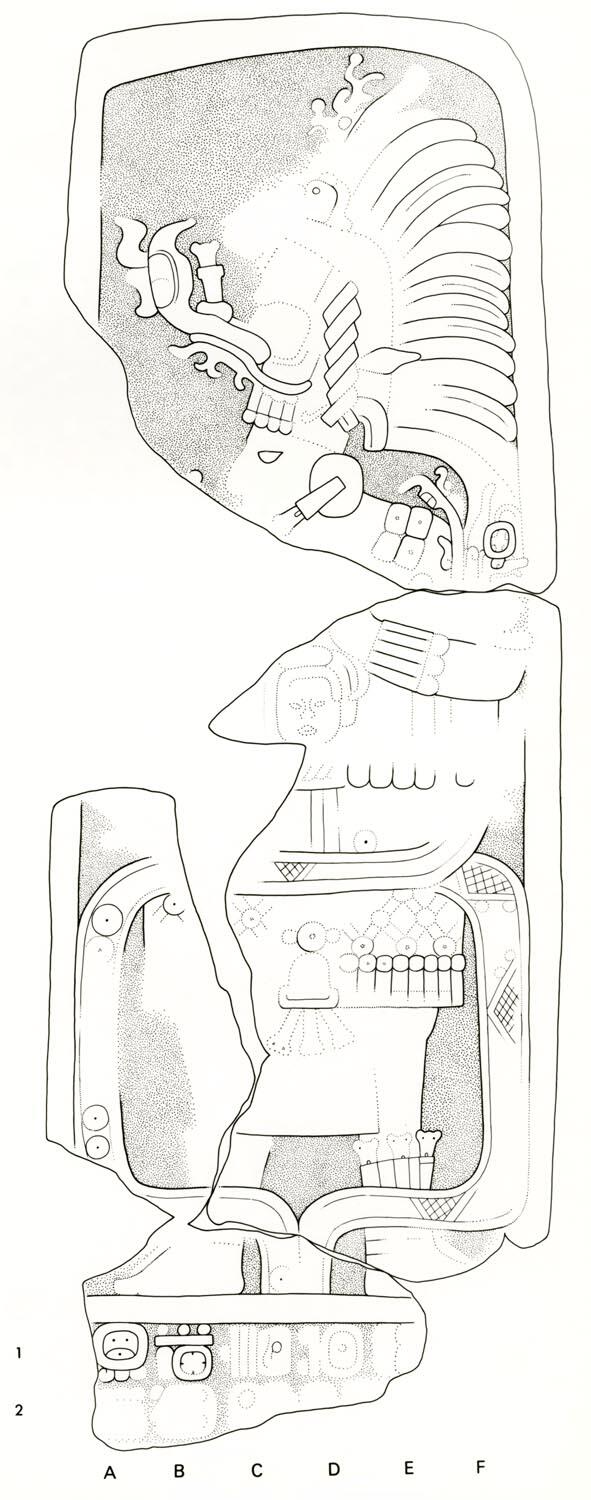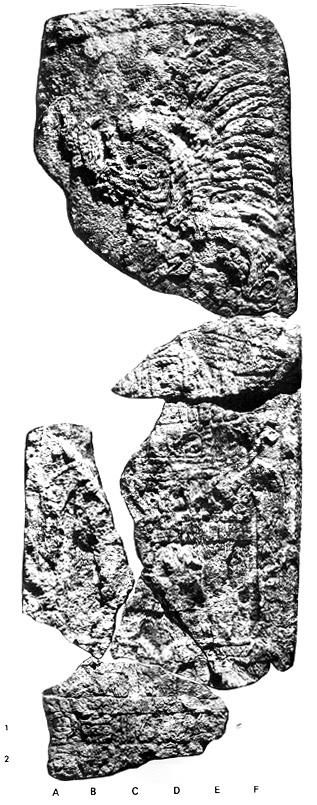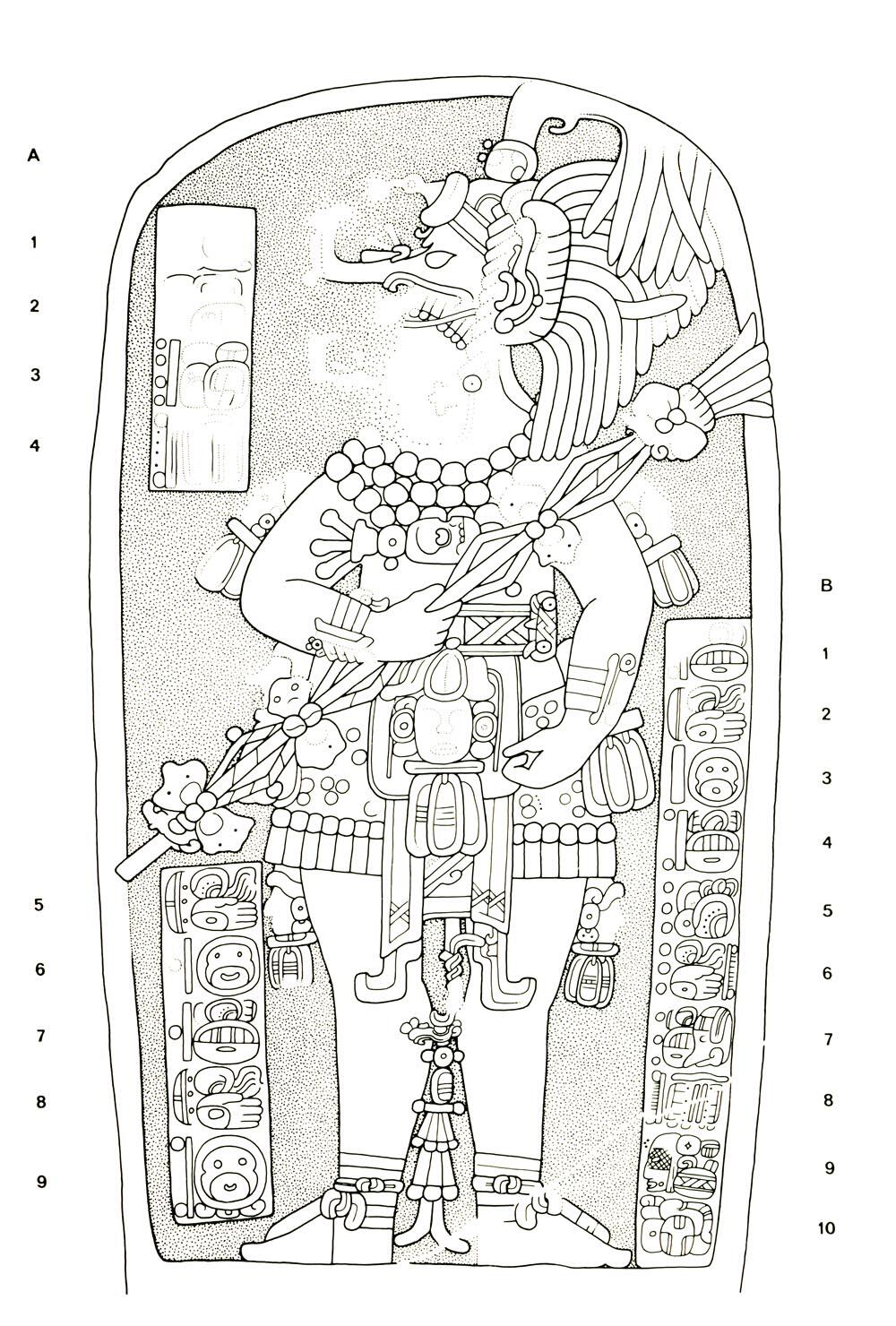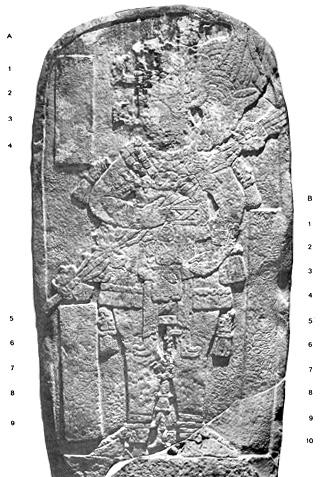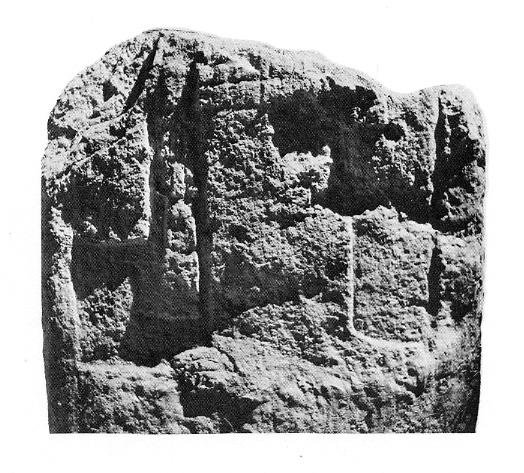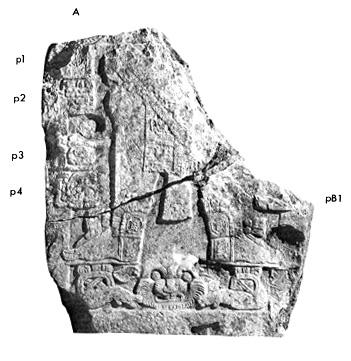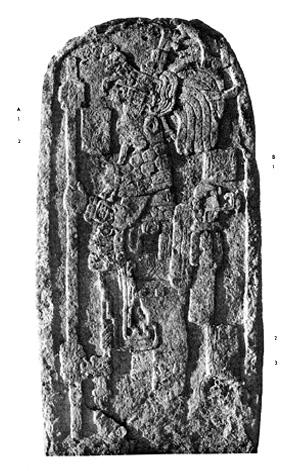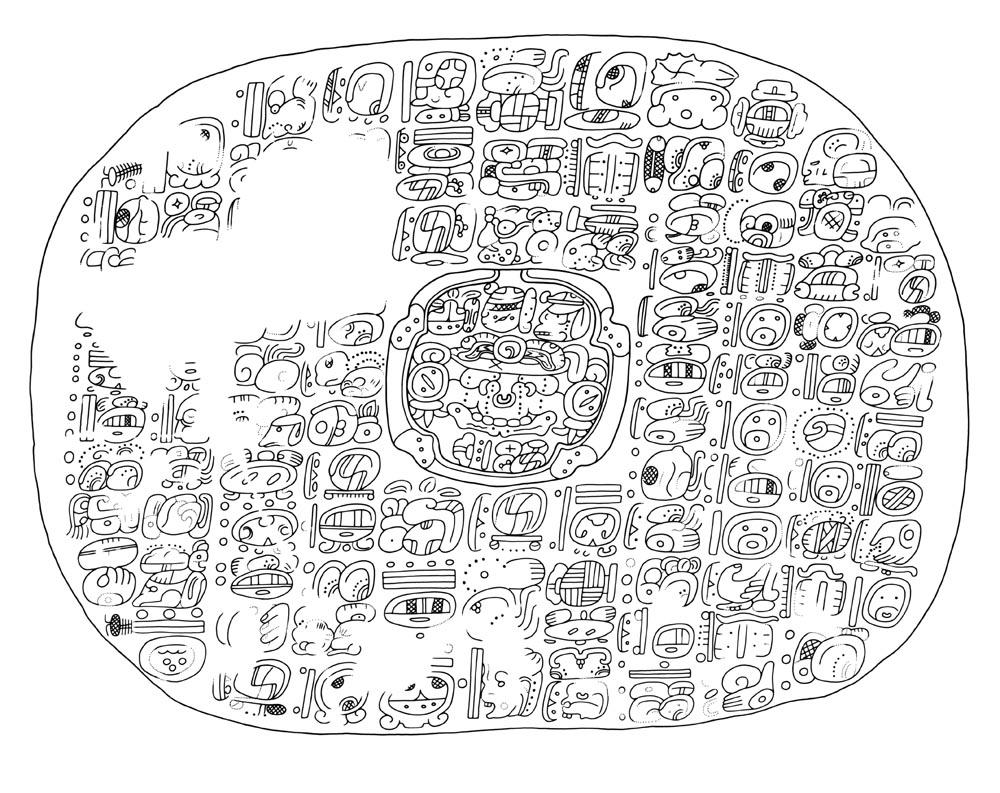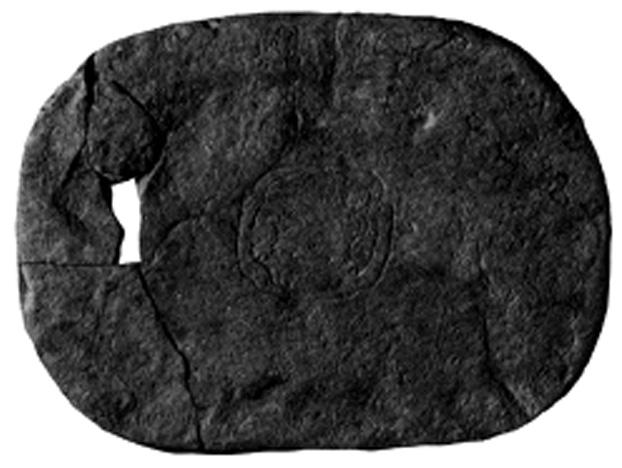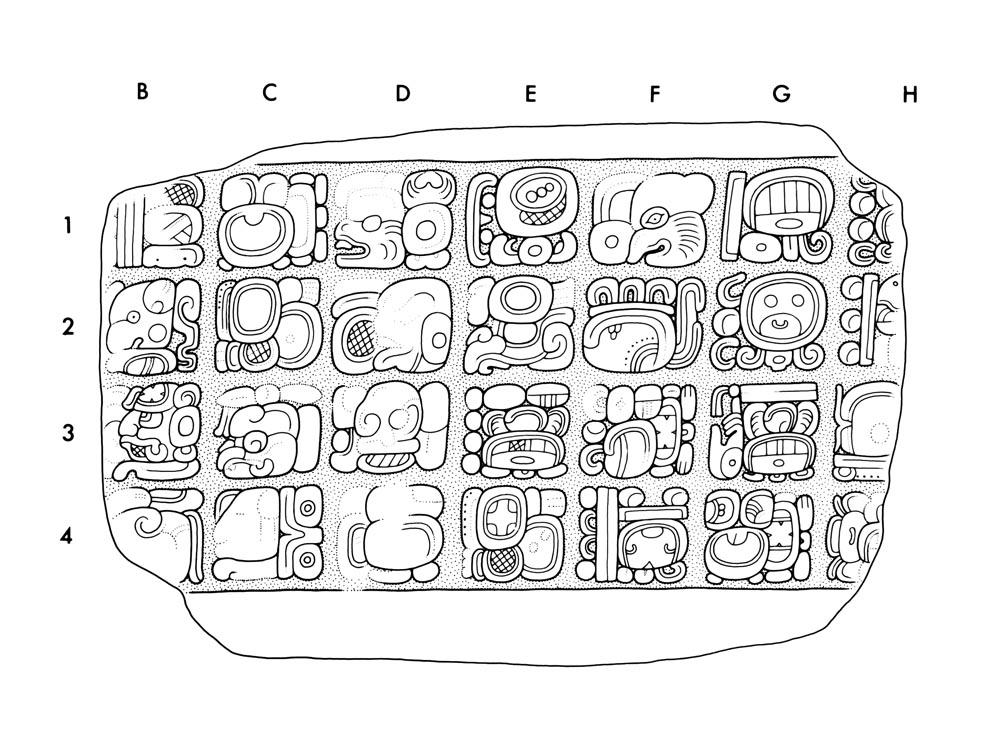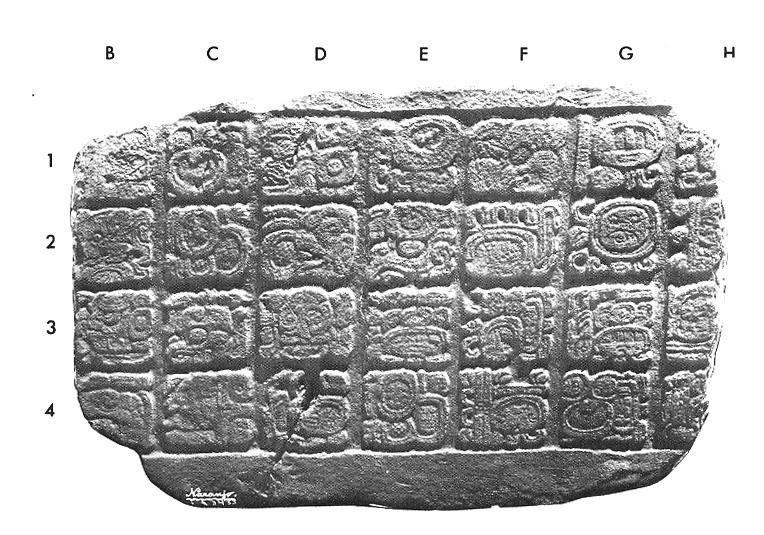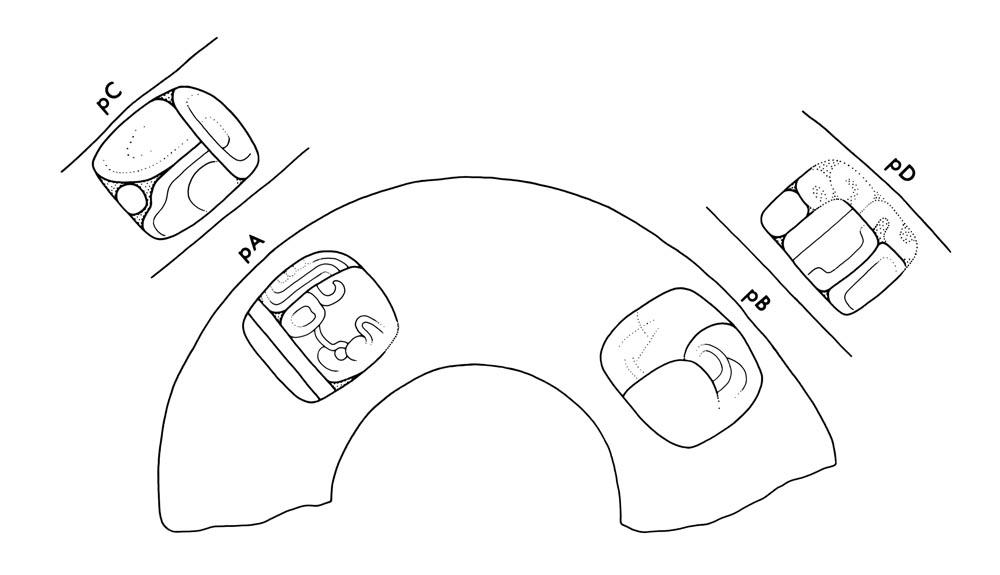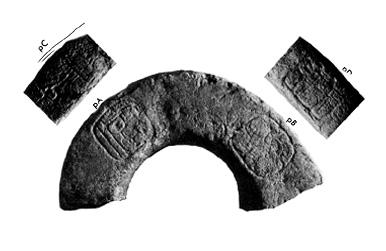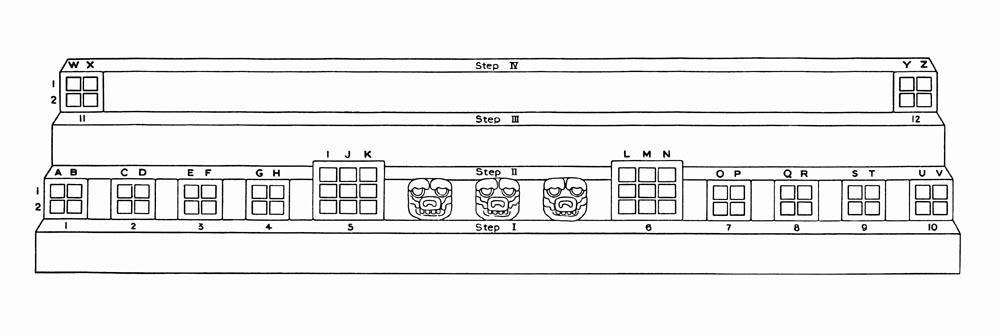Naranjo
Location and Access
The setting of the ruins is a relatively fIat area bordered on three sides by hills and on the fourth by a large bajo. Some of this area is truly flat; but there are a number of hillocks, some of which have been transformed into temple substructures, and there are stretches of very broken terrain, heaped with fractured rock. The range of hills to the north of the site forms part of the great escarpment or arch that runs halfway across Peten, less prominent here than elsewhere. Although Morley places Naranjo in the Holmul Valley, it now appears that land south of the escarpment drains into the Belize River.
The bajo which has formed at the foot of this escarpment is an area of seasonal flooding and supports tangled vegetation and scattered larger trees; at the eastern extremity, however, close to the ruins, the swamp is perennial and covered with reeds. On the 1:125,000 map reproduced on this page, and on the 1:2,000 site plan, the bajo is indicated by a horizontal hatching of broken lines and the swamp by a wrinkle pattern. The darker area within the swamp on this plan represents a curious feature: a sharply defined, straight swath about 15 meters wide and perhaps 250 meters long in which only low reeds and grasses grow. This may be an area that was dredged by the ancient Maya as a measure to improve their water supply. Another aguada, a much smaller one which usually dries up before the end of March, is marked on the plan north of Structure B-13. A never-failing source of excellent water is the little spring at Manantial, two kilometers from the ruins along the track to Melchor de Mencos.
In the late 1950s a logging road was driven through the forest from Fallabon (soon to be renamed Ciudad Melchor de Mencos) to the ruins of Naranjo and beyond. With some labor this road can usually be made passable for vehicles with four-wheel drive in the dry season. The ruins are 18 km from Melchor de Mencos by this route.
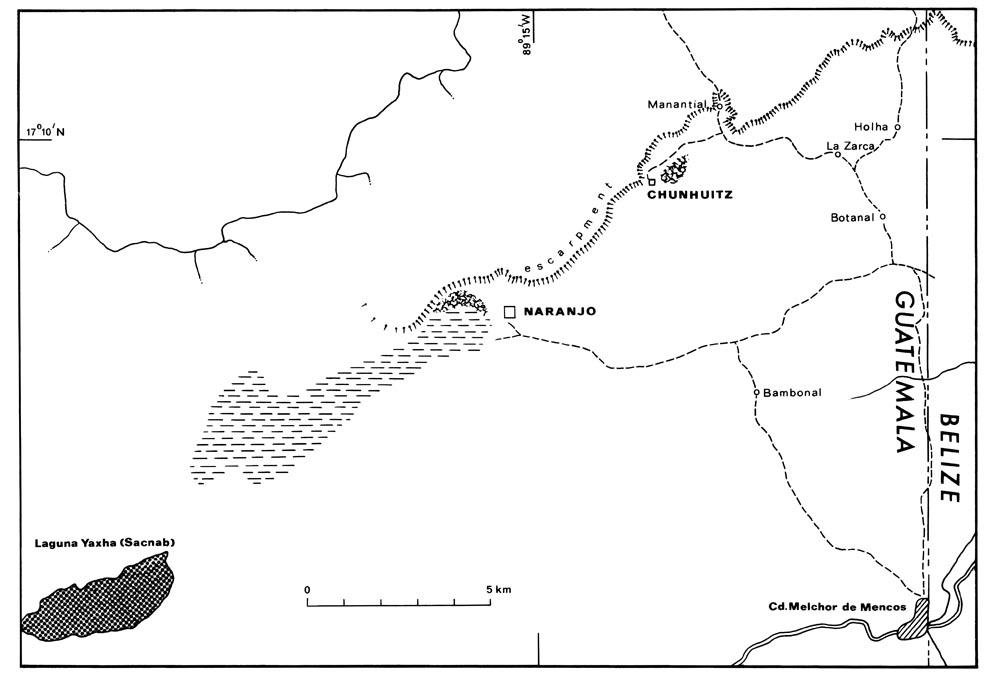
Principal Investigations at the Site
Naranjo was discovered by Teobert Maler in 1905 (Maler 1908, pp. 80-122).
In the course of nearly three months, during which time he lived in a small cave north of Structure A-17, Maler discovered 32 carved stelae, most of which he photographed, and the Hieroglyphic Stairway.
In the succeeding years Sylvanus G. Morley visited the site three times, accompanied during one season by Oliver G. Ricketson. The fruit of these visits was incorporated into his Inscriptions of Peten (Morley 1937-38, vol. 2, pp.21-165).
In 1962, at the request of Tatiana Proskouriakoff, Richard E. W. Adams went to Naranjo in order to take latex molds of certain inscriptions. He was badly hampered by the many trees that the hurricane of the previous year had thrown down and was not able to complete his assignment; nevertheless some of his molds have proved valuable, especially those of monuments damaged only a few years later.
As Morley has recounted (ibid., pp. 57, 58), Naranjo began to lose its sculpture at an early date. But the hieroglyphic step that he says had been taken out to Belize only a short time before his visit in 1914 would appear to have been removed from Naranjo by Maler nine years earlier. In a letter to C. P. Bowditch from Tenosique, Maler writes on September 8, 1905: "I brought from El Naranjo a stone of the famous scriptural staircase (after splitting away from the back as much as possible) safely to El Benque Viejo, where I left it in the house of a friendly turco. The stone is showing 4 great glyphs, finely carved and as good as new. I shall send from Merida a photo of this stone to Boston, then you can resolve if it would be important enough to be sent to the United States (still more worked down on the back, because stone is yet too heavy)." This is almost certainly the step now in the Museum of the American Indian, New York City.
In 1920 all but one of the remaining blocks of the Hieroglyphic Stairway were clumsily broken up and taken to Belize (Joyce 1925, p. 297). They have since been reassembled, but there are losses. Serious plundering, however, did not begin until 1964, and in the following years various gangs seem to have raided the site at different times, to judge by the range of techniques employed. Some of the monuments, or parts of them, soon came to light in public and private collections; others have yet to reappear (1974). A tragic amount of sculpture was destroyed forever by looters completely devoid of expertise trying to "thin" stelae for easy removal.
Notes on the Ruins
For a general description of the ruins the reader is referred to Maler and Morley. Of the features discovered since their time, the most important is Group D. This is a small plaza constructed on a hilltop north of Group B, edged with low mounds and dominated by a mound 9.5 meters high (Structure D-1). The elevation of the plaza floor is 38 meters above that of Group A. A causeway bordered with low walls leads up to a gap between two mounds on the edge facing the "temple" mound, D-1. Three carved stelae were standing at the foot of this mound, the upper portions of numbers 39 and 40 either destroyed, missing, or buried in debris.
Another small plaza was found south of Group A, also located on relatively high ground, in which lie a number of altars and two, or possibly three, stelae. For lack of any sign of carved surfaces these have been designated B5 and B6. Another stela, C6, badly weathered but apparently plain, was found on a low westward extension of Structure C-6.
The two ball courts, B-32 and -33, and B-9 and -10, have hitherto escaped notice. A somewhat puzzling edifice, Structure C-4, deserves mention: it consists of a tall pylon, almost square in plan, with vertical sides rising from a conventional pyramidal base. Any facing that it may have had is fallen away, but these sheer walls still rise to a height of more than five meters without any vestige of stairway or aperature that could be distinguised in the course of a hurried inspection. Maler would certainly have called the structure a Sepulchral Pyramid.
A Note on the Plan of the Site
All structures drafted in solid line were surveyed with compass and tape.
The tops of several large mounds were never investigated, and these have been outlined in dotted lines. This applies to the whole of Acropolis B (Structures B-14 to B-17). Uncarved altars and stelae not recorded in this survey have not been marked on the plan; accordingly, it must be used in conjunction with Ricketson's plan (Morley 1937-38, vol. 5, pI. 195).
Register of Inscriptions at Naranjo
Stelae 1 to 41
Lintel 1
Hieroglyphic Stairway, Inscriptions I to XIII
References Cited
Joyce, Thomas A.
1925 "The Hieroglyphic Stairway at Naranjo, Guatemala," Congres International des Americanistes, Compte-rendu de la XXIe session, Goteborg 1924, part 2, pp. 297-304. Gothenburg.
Maler, Teobert
1908 Explorations in the Department of Peten, Guatemala, and Adjacent Region. Memoirs of the Peabody Museum, Harvard University, vol. 4, no. 2. Cambridge, Massachusetts.
Morley, Sylvanus G.
1937-38 The Inscriptions of Peten. Carnegie Institution of Washington, Publication 437, 5 vols. Washington, D.C.
Site Volume Reference
|
SITE
|
VOL/Part
|
Monument
|
Side
|
Page
|
Pub.year
|
Notes
|
Peabody Number
|
|
NARANJO
|
2.1
|
Map
|
|
5
|
1975
|
|
|
|
NARANJO
|
2.1
|
Map of Ruins
|
|
6
|
1975
|
|
|
|
NARANJO
|
2.1
|
Stela 1
|
Front
|
11
|
1975
|
|
2004.15.6.2.1
|
|
NARANJO
|
2.1
|
Stela 1
|
Left
|
12
|
1975
|
|
2004.15.6.2.2
|
|
NARANJO
|
2.1
|
Stela 1
|
Right
|
12
|
1975
|
|
2004.15.6.2.3
|
|
NARANJO
|
2.1
|
Stela 2
|
Front
|
13
|
1975
|
|
2004.15.6.2.4
|
|
NARANJO
|
2.1
|
Stela 2
|
Left
|
14
|
1975
|
|
2004.15.6.2.5
|
|
NARANJO
|
2.1
|
Stela 2
|
Right
|
15
|
1975
|
|
2004.15.6.2.6
|
|
NARANJO
|
2.1
|
Stela 3
|
Front
|
17
|
1975
|
|
2004.15.6.2.7
|
|
NARANJO
|
2.1
|
Stela 3
|
Right
|
18
|
1975
|
|
2004.15.6.2.8
|
|
NARANJO
|
2.1
|
Stela 3
|
Left
|
18
|
1975
|
|
2004.15.6.2.9
|
|
NARANJO
|
2.1
|
Stela 4
|
Front
|
19
|
1975
|
|
2004.15.6.2.10
|
|
NARANJO
|
2.1
|
Stela 5
|
Front
|
21
|
1975
|
|
2004.15.6.2.11
|
|
NARANJO
|
2.1
|
Stela 6
|
Front
|
23
|
1975
|
|
2004.15.6.2.12
|
|
NARANJO
|
2.1
|
Stela 6
|
Back
|
24
|
1975
|
|
2004.15.6.2.13
|
|
NARANJO
|
2.1
|
Stela 7
|
Front
|
25
|
1975
|
|
2004.15.6.2.14
|
|
NARANJO
|
2.1
|
Stela 8
|
Front
|
27
|
1975
|
|
2004.15.6.2.15
|
|
NARANJO
|
2.1
|
Stela 8
|
Back
|
28
|
1975
|
|
2004.15.6.2.16
|
|
NARANJO
|
2.1
|
Stela 9
|
Front
|
29
|
1975
|
|
2004.15.6.2.17
|
|
NARANJO
|
2.1
|
Stela 10
|
Front
|
31
|
1975
|
|
2004.15.6.2.18
|
|
NARANJO
|
2.1
|
Stela 11
|
Front
|
33
|
1975
|
|
2004.15.6.2.19
|
|
NARANJO
|
2.1
|
Stela 12
|
Front
|
35
|
1975
|
|
2004.15.6.2.20
|
|
NARANJO
|
2.1
|
Stela 12
|
Back
|
36
|
1975
|
|
2004.15.6.2.21
|
|
NARANJO
|
2.1
|
Stela 13
|
Front
|
37
|
1975
|
|
2004.15.6.2.22
|
|
NARANJO
|
2.1
|
Stela 13
|
Back
|
38
|
1975
|
|
2004.15.6.2.23
|
|
NARANJO
|
2.1
|
Stela 14
|
Front
|
39
|
1975
|
|
2004.15.6.2.24
|
|
NARANJO
|
2.1
|
Stela 14
|
Back
|
40
|
1975
|
|
2004.15.6.2.25
|
|
NARANJO
|
2.1
|
Stela 15
|
Front
|
41
|
1975
|
|
2004.15.6.2.26
|
|
NARANJO
|
2.1
|
Stela 15
|
Left
|
42
|
1975
|
|
2004.15.6.2.27
|
|
NARANJO
|
2.1
|
Stela 15
|
Right
|
42
|
1975
|
|
2004.15.6.2.28
|
|
NARANJO
|
2.1
|
Stela 16
|
Front
|
43
|
1975
|
|
2004.15.6.2.29
|
|
NARANJO
|
2.1
|
Stela 17
|
Front
|
45
|
1975
|
|
2004.15.6.2.30
|
|
NARANJO
|
2.1
|
Stela 18
|
Back
|
47
|
1975
|
|
2004.15.6.2.31
|
|
NARANJO
|
2.1
|
Stela 18
|
Left
|
48
|
1975
|
|
2004.15.6.2.32
|
|
NARANJO
|
2.1
|
Stela 18
|
Right
|
48
|
1975
|
|
2004.15.6.2.33
|
|
NARANJO
|
2.1
|
Stela 19
|
Front
|
49
|
1975
|
|
2004.15.6.2.34
|
|
NARANJO
|
2.1
|
Stela 19
|
Back
|
50
|
1975
|
|
2004.15.6.2.35
|
|
NARANJO
|
2.1
|
Stela 20
|
Front
|
51
|
1975
|
|
2004.15.6.2.36
|
|
NARANJO
|
2.1
|
Stela 21
|
Front
|
53
|
1975
|
|
2004.15.6.2.37
|
|
NARANJO
|
2.1
|
Stela 21
|
Back
|
54
|
1975
|
|
2004.15.6.2.38
|
|
NARANJO
|
2.1
|
Stela 22
|
Front
|
55
|
1975
|
|
2004.15.6.2.39
|
|
NARANJO
|
2.1
|
Stela 22
|
Left
|
56
|
1975
|
|
2004.15.6.2.40
|
|
NARANJO
|
2.1
|
Stela 22
|
Right
|
56
|
1975
|
|
2004.15.6.2.41
|
|
NARANJO
|
2.1
|
Stela 23
|
Front
|
59
|
1975
|
|
2004.15.6.2.42
|
|
NARANJO
|
2.1
|
Stela 23
|
Left
|
60
|
1975
|
|
2004.15.6.2.43
|
|
NARANJO
|
2.1
|
Stela 23
|
Right
|
60
|
1975
|
|
2004.15.6.2.44
|
|
NARANJO
|
2.1
|
Stela 24
|
Front
|
63
|
1975
|
|
2004.15.6.2.45
|
|
NARANJO
|
2.1
|
Stela 24
|
Left
|
64
|
1975
|
|
2004.15.6.2.46
|
| NARANJO | 2.1 | Stela 24 | Right | 64 | 1975 | 2004.15.6.2.47 | |
|
NARANJO
|
2.2
|
Stela 25
|
front
|
69
|
1978
|
|
2004.15.6.3.1
|
|
NARANJO
|
2.2
|
Stela 25
|
left
|
70
|
1978
|
|
2004.15.6.3.2
|
|
NARANJO
|
2.2
|
Stela 25
|
right
|
70
|
1978
|
|
2004.15.6.3.3
|
|
NARANJO
|
2.2
|
Stela 26
|
front
|
71
|
1978
|
|
2004.15.6.3.4
|
|
NARANJO
|
2.2
|
Stela 27
|
front
|
73
|
1978
|
|
2004.15.6.3.5
|
|
NARANJO
|
2.2
|
Stela 28
|
front
|
75
|
1978
|
|
2004.15.6.3.6
|
|
NARANJO
|
2.2
|
Stela 28
|
back
|
76
|
1978
|
|
2004.15.6.3.7
|
|
NARANJO
|
2.2
|
Stela 29
|
front
|
77
|
1978
|
|
2004.15.6.3.8
|
|
NARANJO
|
2.2
|
Stela 29
|
back
|
78
|
1978
|
|
2004.15.6.3.9
|
|
NARANJO
|
2.2
|
Stela 30
|
front
|
79
|
1978
|
missing
|
|
|
NARANJO
|
2.2
|
Stela 30
|
back
|
80
|
1978
|
|
2004.15.6.3.11
|
|
NARANJO
|
2.2
|
Stela 31
|
front
|
83
|
1978
|
|
2004.15.6.3.12
|
|
NARANJO
|
2.2
|
Stela 31
|
back
|
84
|
1978
|
|
2004.15.6.3.13
|
|
NARANJO
|
2.2
|
Stela 32
|
front
|
86
|
1978
|
|
2004.15.6.3.14
|
|
NARANJO
|
2.2
|
Stela 33
|
front
|
87
|
1978
|
|
2004.15.6.3.15
|
|
NARANJO
|
2.2
|
Stela 35
|
front
|
91
|
1978
|
|
2004.15.6.3.16
|
|
NARANJO
|
2.2
|
Stela 35
|
back
|
92
|
1978
|
|
2004.15.6.3.17
|
|
NARANJO
|
2.2
|
Stela 36
|
front
|
93
|
1978
|
|
2004.15.6.3.18
|
|
NARANJO
|
2.2
|
Stela 37
|
front
|
95
|
1978
|
|
2004.15.6.3.19
|
|
NARANJO
|
2.2
|
Stela 38
|
front
|
97
|
1978
|
|
2004.15.6.3.20
|
|
NARANJO
|
2.2
|
Stela 40
|
front
|
101
|
1978
|
|
2004.15.6.3.21
|
|
NARANJO
|
2.2
|
Altar 1
|
front
|
103
|
1978
|
|
2004.15.6.3.22
|
|
NARANJO
|
2.2
|
Altar 1
|
|
104
|
1978
|
missing
|
|
|
NARANJO
|
2.2
|
Lintel 1
|
front
|
105
|
1978
|
|
2004.15.6.3.24
|
|
NARANJO
|
2.2
|
Hieroglyphic Stair
|
step I
|
107
|
1978
|
step I thru VI
|
2004.15.6.3.25
|
|
NARANJO
|
2.2
|
Hieroglyphic Stair
|
step II
|
108
|
1978
|
are on the
|
2004.15.6.3.26
|
|
NARANJO
|
2.2
|
Hieroglyphic Stair
|
step III
|
108
|
1978
|
same board
|
2004.15.6.3.27
|
|
NARANJO
|
2.2
|
Hieroglyphic Stair
|
step IV
|
108
|
1978
|
|
2004.15.6.3.28
|
|
NARANJO
|
2.2
|
Hieroglyphic Stair
|
step V
|
108
|
1978
|
|
2004.15.6.3.29
|
|
NARANJO
|
2.2
|
Hieroglyphic Stair
|
step VI
|
109
|
1978
|
|
2004.15.6.3.30
|
|
NARANJO
|
2.2
|
Hieroglyphic Stair
|
step VII
|
109
|
1978
|
step VII thru XII
|
2004.15.6.3.31
|
|
NARANJO
|
2.2
|
Hieroglyphic Stair
|
step VIII
|
109
|
1978
|
are on the
|
2004.15.6.3.32
|
|
NARANJO
|
2.2
|
Hieroglyphic Stair
|
step IX
|
109
|
1978
|
same board
|
2004.15.6.3.33
|
|
NARANJO
|
2.2
|
Hieroglyphic Stair
|
step X
|
110
|
1978
|
|
2004.15.6.3.34
|
|
NARANJO
|
2.2
|
Hieroglyphic Stair
|
step XI
|
110
|
1978
|
|
2004.15.6.3.35
|
|
NARANJO
|
2.2
|
Hieroglyphic Stair
|
step XII
|
110
|
1978
|
|
2004.15.6.3.36
|
|
NARANJO
|
2.2
|
Hieroglyphic Stair
|
XIII
|
110
|
1978
|
|
2004.15.6.3.37
|
|
NARANJO
|
2.3
|
Map
|
|
185
|
1980
|
|
|
|
NARANJO
|
2.3
|
Stela 41
|
front
|
185
|
1980
|
|
2004.15.6.4.19
|
|
NARANJO
|
2.3
|
Ball-court Sclpt.1
|
3 Fragments
|
187
|
1980
|
|
2004.15.6.4.20
|
Author Reference
|
SITE (by Vol)
|
VOL/Part
|
Author(s)
|
|
NARANJO
|
2.1
|
Ian Graham and Eric von Euw, Vol 2.1, 1975
|
|
NARANJO
|
2.2
|
Ian Graham, Vol. 2.2, 1978
|
|
NARANJO
|
2.3
|
Ian Graham, Vol. 2.3, 1980
|
Inscriptions at Naranjo
Stela 1
Location
Westernmost of the stelae set in front of Structure A-15. Probably long before Maler's visit it had fallen backwards against the terrace edge. Removed in 1972 to Melchor de Mencos.
Condition
Broken into three pieces and lacking some small fragments. The carved surfaces are considerably eroded.
Material
Limestone.
Shape
Parallel sides, with rounded top. The back surface at the upper left-hand corner may have been irregular at the time of erection
Dimensions
|
HLC
|
2.19 m
|
|
PB
|
unknown
|
|
MW
|
0.97 m
|
|
WBC
|
0.92 m
|
|
MTh
|
0.32 m
|
|
ReI
|
1.5 cm
|
Carved Areas
Front carved in relief; both narrow sides carry an incised text.
Photographs
Graham, 1970.
Drawings
Graham; that of the front based on field drawings corrected by artificial light and photographs taken with varied lighting; the incised glyphs on the sides were inked in by artificial light and photographed. Latex moulds of the sides of the lower part were made.
Remarks
The first three or four glyph blocks of column C may have been left uncarved because of the irregular shape of the shaft.
Stela 2


Location
Between Stelae 1 and 3, in front of Structure A-15, where it was found lying face down by Maler. Removed in 1971 to the Museo Nacional de Antropología y Etnología, Guatemala City.
Condition
Intact until damaged by looters in the mid-1960s, who started to saw the front off from the top but, wearying of this task, proceeded to smash the upper left-hand corner. Most of the broken pieces have been recovered. The front surface is only slightly weathered; the incised writing on the sides has suffered more, especially along strata of softer stone.
Material
Hard limestone.
Shape
Parallel-sided, with rounded top.
Dimensions
|
HLC
|
3.29 m
|
|
PB
|
0.77 m
|
|
MW
|
1.07 m
|
|
WBC
|
1.02 m
|
|
MTh
|
0.46 m
|
|
ReI
|
2.5 cm
|
Carved Areas
Front carved in relief; sides incised; back uncarved.
Photographs
Front: reproduced from Maler's original negative of 1905. Sides: Graham, 1970.
Drawings
Graham. Drawing of the front based on field drawing corrected by artificial light, and detail photographs. The incised glyphs on the sides were inked in by artificial light and then photographed. Details of the damaged area at the top of the left side were taken from a cast made by R. E. W. Adams in 1961.
Stela 3
Location
Easternmost of the stelae in front of Structure A-15. Found lying face down by Maler.
Condition
Somewhat eroded but unbroken at the time of discovery. Largely destroyed by looters in the mid-1960s: the upper two-thirds of the shaft was broken into small fragments, evidently while the thieves were attempting to split off the front surface. Some of the fragments could not be found in 1970.
Material
Limestone.
Shape
Tapers slightly towards the foot. Top edge flattish and canted.
Dimensions
|
HLC
|
1.98 m
|
|
PB
|
0.47 m
|
|
MW
|
1.00 m
|
|
WBC
|
0.87 m
|
|
MTh
|
0.35 m
|
|
ReI
|
2.0 cm
|
Carved Areas
Front carved in relief; both sides carry an incised text.
Photographs
Front: reproduced from Maler's original negative of 1905. Righthand side (remnant): Graham, 1969.
Drawings
Front: von Euw, based solely on Maler's photograph. Sides: Graham, based on photographs by Morley, plastercasts from molds made by R. E. W. Adams in 1961, and field drawings of such parts of the original as could be assembled in 1969.
Stela 4
Location
Behind Stela 2, close against the steps leading up to the terrace in front of Structure A-I5.
Condition
Broken into several pieces, four of which have been found, including the lower portion in situ. The surface has suffered moderate erosion in some areas, severe in others.
Material
Limestone with abundant inclusions, giving it the character of a breccia.
Shape
Parallel sides, with rounded top.
Dimensions
|
HLC
|
1.9 - 2.1 m approx.
|
|
PB
|
0.27 m
|
|
MW
|
0.93 m
|
|
WBC
|
Unknown
|
|
MTh
|
0.50 m
|
|
ReI
|
1.2 cm
|
Carved Areas
Front only.
Photograph
Graham, 1970.
Drawing
Graham, based on field drawing corrected by artificial light.
Remarks
Only the two upper fragments fit together, and these may have been positioned rather too low in the reconstruction.
Stela 5
Location
North side of Structure A-21.
Condition
Intact and still erect when found by Maler. At some time after Morley's last visit in 1923 it may have fallen; it seems then to have been pushed back against the mound by a bulldozer when that area was being cleared as a "barcadier" or depot for mahogany logs in 1958. The stela is reported to have been defaced in 1973.
Material
Limestone of indifferent quality.
Shape
Parallel sides, with rounded top.
Dimensions
|
HLC
|
1.83 m
|
|
PB
|
0.62 m
|
|
MW
|
0.88 m
|
|
WBC
|
0.83 m
|
|
MTh
|
0.37 m
|
|
ReI
|
1.3 cm
|
Carved Areas
Front only.
Photograph
Reproduced from Maler's original negative of 1905.
Drawing
Graham, based on field drawing corrected by artificial light.
Stela 6
Location
Westernmost of three stelae set on the south side of Structure B-4. Maler found the stela lying on its face, unbroken. In 1964 the front surface was split off and went into private ownership in Chicago, as payment for a bad debt.
Condition
The front surface was very well preserved and the back badly eroded when discovered. the splitting of the stela somehow resulted in destruction of collumn F of the inscription, together with some adjacent glyphs, and the upper right-hand corner of the front is missing. The front has lost its pristine condition and has been cut into three pieces with a saw.
Material
Limestone.
Shape
Sides broadly parallel, although somewhat bulged; unsymmetrical top.
Dimensions
|
HLC
|
1.69 m
|
|
PB
|
0.46 m
|
|
MW
|
0.62 m
|
|
WBC
|
0.45 m
|
|
MTh
|
0.34 m
|
|
ReI
|
1.1 cm
|
Carved Areas
Front and back.
Photographs
Front: reproduced from Maler's original negative of 1905. Back: Morley, 1914.
Drawings
Graham. Drawing on the front based on Maler's photograph and inspection of the original; that of the back traced from a rectified print of Morley's oblique photograph, with details from this and from a field drawing made of the damaged inscription.
Note
Morley's designation of glyphs B5 and B6 has been changed here to B1 and B2.
Stela 7
Location
Between Stelae 6 and 8, on the south side of Structure B-4. Already fallen to the ground when discovered by Maler. Removed to Flores in 1972.
Condition
Unbroken until the mid 1960s, when plunderers smashed the upper left-hand corner, including the panel of four glyphs, and drilled a number of holes about 3 cm in diameter into the front surface.
Material
Limestone.
Shape
Parallel sides with rounded top; unusually thick.
Dimensions
|
HLC
|
2.53 m
|
|
PB
|
0.62 m
|
|
MW
|
1.20 m
|
|
WBC
|
1.10 m
|
|
MTh
|
0.62 m
|
|
ReI
|
3.0 cm
|
Carved Areas
Front only.
Photographs
Reproduced from Maler's original negative of 1905.
Drawing
Graham, based on field drawing corrected by artificial light.
Stela 8
Location
Easternmost of three stelae on the south side of Structure B-4. After the theft of the stela in about 1963, the front surface reappeared in a Saint Louis, Missouri, private collection.
Condition
As found by Maler the stela was intact and well preserved in front, somewhat weathered on the reverse side. Since then the front surface has suffered considerable erosion. The looters, in order to carry the stela away, broke it in two at the level of Glyph B5, after chipping the back away.
Material
Limestone.
Shape
Somewhat tapered, with a flat top.
Dimensions
|
HLC
|
1.87 m
|
|
PB
|
0.62 m
|
|
MW
|
0.92 m
|
|
WBC
|
0.60 m
|
|
MTh
|
0.19 m
|
|
ReI
|
1.5 cm
|
Carved Areas
Front and back.
Photographs
Prints from original negatives by Maler.
Drawings
Front: Graham, based on Maler's and Morley's photographs, and checked against the original. Back: von Euw, based on Maler's photograph only.
Stela 9
Location
West side of Structure B-18, to north of center line of stairway. Front surface was split away by looters in the mid 1960's and had not come to light by 1974.
Condition
Unbroken when found by Maler but quite badly weathered in some areas.
Material
Limestone.
Shape
Sharply tapered downward, with rounded but irregular top.
Dimensions
|
HLC
|
2.20 m
|
|
PB
|
0.70 m
|
|
MW
|
0.83 m
|
|
WBC
|
0.48 m
|
|
MTh
|
0.48 m
|
|
ReI
|
unknown
|
Carved Areas
Front only.
Photographs
Print from Maler's original negative.
Drawing
Graham, based on Maler's photograph.
Stela 10
Location
Found lying on the north side of Structure B-23, a little to the east of Stela 11. In 1971 the stela was removed to Flores.
Condition
Unbroken; the carved surface generally in good condition, but there are areas of severe erosion. At the time of erection the surface must already have been blemished by deep pits, since some of these were filled up with plaster.
Material
Limestone.
Shape
Parallel sides, with flattish top, unusually thick.
Dimensions
|
HLC
|
1.94 m
|
|
PB
|
0.70 m
|
|
MW
|
1.13 m
|
|
WBC
|
1.11 m
|
|
MTh
|
0.57 m
|
|
ReI
|
1.0 cm
|
Carved Areas
Front only.
Photograph
Reproduced from Maler's original negative of 1905.
Drawing
Graham, based on field drawing corrected by artificial light.
Stela 11
Location
North side of Structure B-23, standing to the west of Stela 10.
Condition
Lying broken in three pieces when found by Maler. The front surface is fairly well preserved, except for some flaking low down, and shows no further erosion since its discovery. The back is severely eroded.
Material
Limestone, with quartzite inclusions now prominent in some areas of the sculptured surface and in two beds within the shaft.
Shape
Tapers somewhat toward the top, which is unsymmetrical.
Dimensions
|
HLC
|
2.89 m
|
|
PB
|
0.78 m
|
|
MW
|
1.00 m
|
|
WBC
|
0.99 m
|
|
MTh
|
0.34 m
|
|
ReI
|
1.8 cm |
Carved Areas
Front and back.
Photograph
Graham, 1973.
Drawing
Front: Graham, based on field drawing corrected by artificial light. No drawing has been made of the back as no details survive beyond the outlines of four columns of fourteen glyphs.
Stela 12
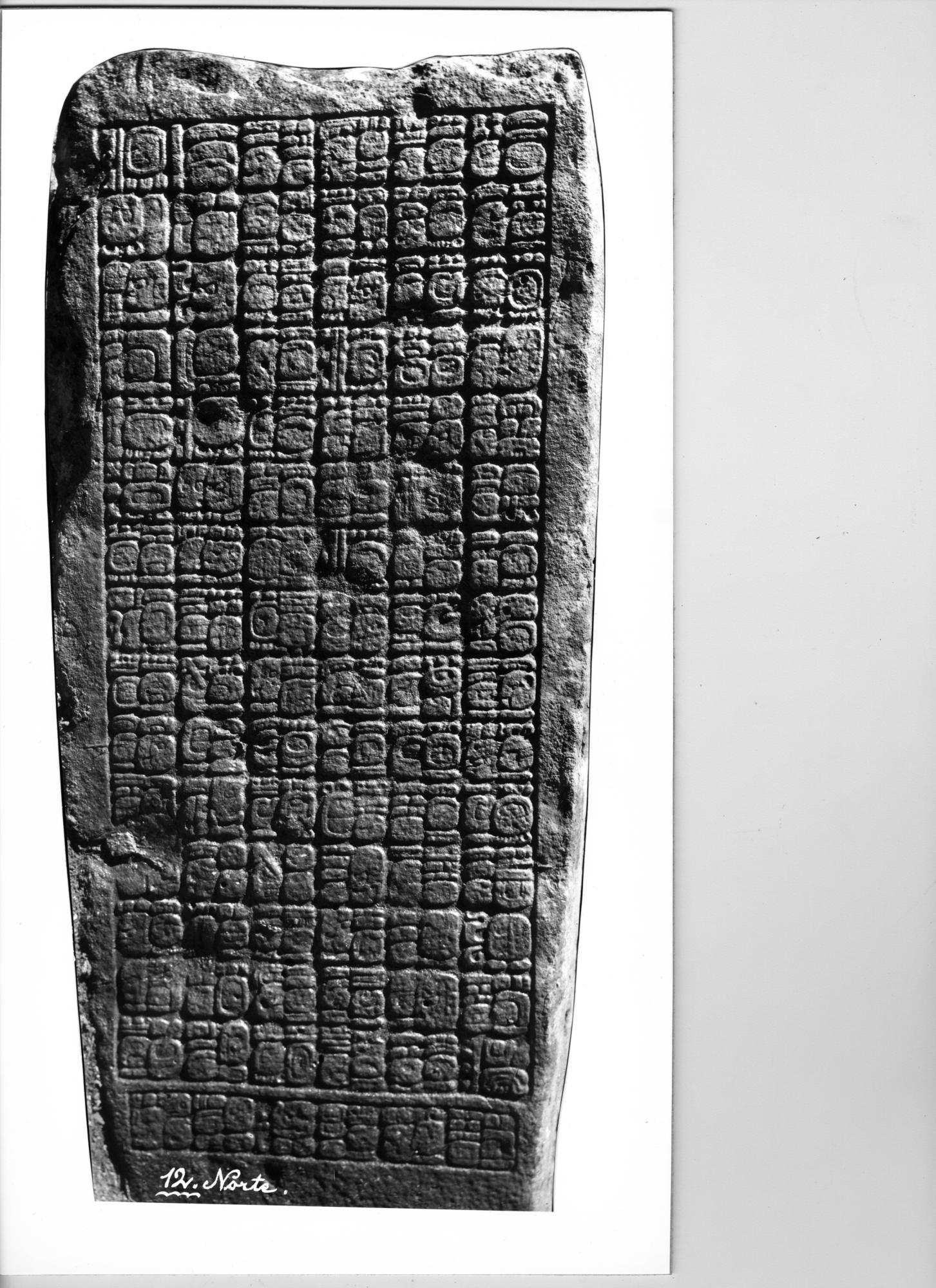 Photo of Naranjo, Stela 12, back, 2004.15.5.2.21
Photo of Naranjo, Stela 12, back, 2004.15.5.2.21
Location
Westernmost of three stelae on the south side of Structure B-19. Removed by looters in 1964. Fragments constituting about half of the back (glyphs B, C7-15, D-G 10-15, and H-M) were later impounded in Belize and sent to the Museo Nacional de Antropología y Etnología, Guatemala. No part of the front surface had come to light by 1974.
Condition
Intact when found by Maler and rather well preserved, although the finer details of the inscription on the back were eroded. The shaft being quite thick, the looters resorted to the use of a powered rock-drill in breaking it into pieces. The surviving pieces of the back show noticeable erosion since Maler's photograph was taken.
Material
Limestone
Shape
Sides tapering slightly toward the bottom, with a flat top.
Dimensions
|
HLC
|
2.00 m
|
|
PB
|
0.70 m
|
|
MW
|
0.88 m
|
|
WBC
|
0.74 m
|
|
MTh
|
0.36 m
|
|
ReI
|
unknown
|
Carved Areas
Front and back.
Photographs
Printed from Maler's original negatives of 1905.
Drawings
Graham, based on Maler's photographs and examination of the surviving portions of the back.
Stela 13
(Left) Drawing of Naranjo, Stela 13, front, 2004.15.6.2.22; (Right) Photo of Naranjo, Stela 13, front, 2004.15.5.2.22
Location
South side of Structure B-19, between Stelae 12 and 14. Fragmentary remains preserved in Guatemala City (see below).
Condition
Unbroken and still standing, although sharply inclined, when found by Maler. Excavated and lowered to the ground by him. Both sides were then in very fine condition. In the mid-1960s the stela was broken up by looters, but fragments amounting to more than half of the front surface were recovered in Belize and sent to the Museo Nacional Antropología y Etnología, Guatemala City.
Material
Limestone.
Shape
Narrow, with parallel sides tapering to a rounded point.
Dimensions
|
HLC
|
3.49 m
|
|
PB
|
0.96 m
|
|
MW
|
0.94 m
|
|
WBC
|
unknown
|
|
MTh
|
0.35 m
|
|
ReI
|
1.5 cm in surviving areas
|
Carved Areas
Front and back.
Photographs
Reproduced from Maler's original negatives of 1905.
Drawings
Front: von Euw. Back: Graham, based on Maler's photographs and examination of the surviving fragments of the front surface (these do not include the upper portion, with the glyph panel A1-4, B, C).
Stela 14
Location
Easternmost of three stelae on the south side of Structure B-19. Fragmentary remains preserved in Guatemala City (see below).
Condition
In quite well-preserved state when found by Maler, although broken in two and with some of the finer glyphic detail eroded. In about 1964 it was reduced to fragments by looters using a powered rock-drill and removed to Belize. There some of the fragments were confiscated and transferred to the Museo Nacional de Antropología e Historia, Guatemala City; they make up the entire back surface except for the loss of all, or a good part, of glyphs C1-4, D1, E5, F5, and G, H, I, most of these three incised glyphs having remained on the discarded butt at the site.
Material
Limestone.
Shape
Sides essentially parallel, if somewhat bulged, with an unsymmetrical top.
Dimensions
| HLC | 2.65 m |
|
PB
|
0.92 m
|
|
MW
|
0.76 m
|
|
WBC
|
unknown
|
|
MTh
|
0.31 m
|
|
ReI
|
1.4 cm
|
Carved Areas
Front and back.
Photographs
Reproduced from Maler's original negatives of 1905.
Drawings
Graham, based on Maler's photographs (his photograph of the back having been rectified for the purpose of tracing) and on an examination of the surviving fragments of the back in Guatemala City.
Stela 15
Location
Terrace of Structure B-20.
Condition
Broken into two pieces at least, when found by Maler, with all traces of carving weathered away over much of the surface.
Material
Close-grained limestone.
Shape
The shape of the whole shaft is unknown.
Dimensions
|
Ht
|
1.53 m
|
|
MW
|
1.01 m
|
|
MTh
|
0.30 m
|
|
ReI
|
1.0 cm
|
Carved Areas
Front in low relief, sides incised.
Photographs
Graham, 1973.
Drawings
Graham, based on photographs taken after ink had been applied to the incised lines as they were revealed by artificial light.
Remarks
The fragment illustrated was found by Maler among debris halfway down the substructure, below the terrace. The butt of the stela was excavated by him but seems to have become buried in debris again by 1970; Morley gives its length, or height, as 1.47 m. As the one surviving detail of sculpture on the front shows the end of a ceremonial bar, it must be assumed that another quite large fragment forming the upper part of the stela remains to be found.
Stela 16
Location
West side of Structure B-20, flanking the stairway on its left-hand side.
Condition
When found by Maler the upper half was broken off and the carved surface very badly weathered.
Material
Limestone.
Shape
Slightly bulged but essentially parallel sides, with a rounded top.
Dimensions
|
HLC
|
1.91 m
|
|
PB
|
unknown
|
|
MW
|
0.91 m
|
|
WBC
|
0.82 m
|
|
MTh
|
0.50 m
|
|
ReI
|
1.0 cm
|
Carved Areas
Front only.
Photograph
Graham, 1973.
Drawing
Graham, based on a field drawing corrected by artificial light.
Stela 17
Location
West side of Structure B-20, flanking the stairway on its right-hand side.
Condition
Intact and still standing when found by Maler but badly eroded. Later the stela broke at knee level, where Morley's photograph suggests a flaw in the stone.
Material
Limestone.
Shape
Somewhat tapered, with a flattish top.
Dimensions
|
HLC
|
1.93 m
|
|
PB
|
unknown
|
|
MW
|
0.82 m
|
|
WBC
|
unknown
|
|
MTh
|
0.50 m
|
|
ReI
|
1.3 cm
|
Drawing
Graham, based, for the upper three-quarters of the shaft, on a field drawing corrected at night, and for the lower part on Morley's photograph alone.
Remarks
A large amount of debris has slipped down from above since Morley's time. This has buried the lower part of the stela (which Graham did not attempt to dig out) and may have been responsible for the breakage.
Carved Areas
Front only.
Photograph
Morley, 1921.
Stela 18
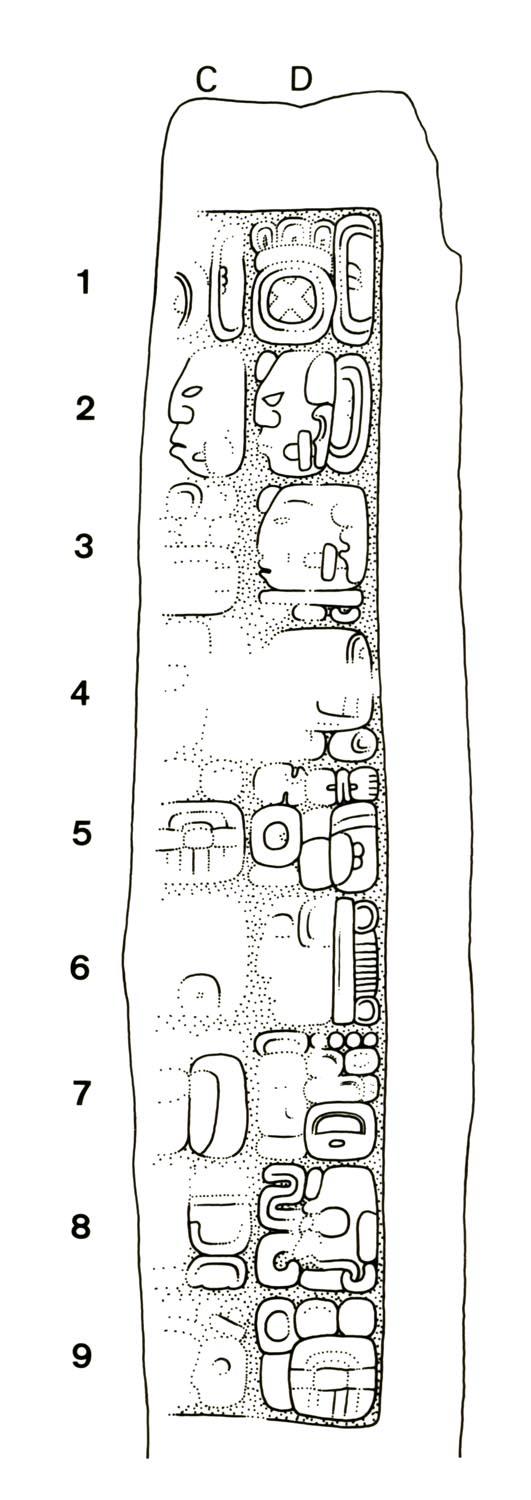
Location
Found on the west side of the southern extension of Structure B-20.
Condition
The shaft is unbroken, but the entire front of it, in the form of a layer perhaps 15 cm thick, has split off and disintegrated. The loss may be attributed to natural causes, although purposeful mutilation in antiquity cannot be discounted. The back and sides are moderately well preserved; there have been some losses from the back by flaking, but some of the irregularity so caused occurred before the incised text was carved.
Material
Limestone.
Shape
Unsymmetrical, tapering toward base; canted top.
Dimensions
|
HLC
|
1.52 m
|
|
PB
|
1.01 m
|
|
MW
|
0.96 m
|
|
WBC
|
0.85 m
|
|
MTh
|
0.36 m; originally about 0.50 m
|
|
ReI
|
1.2 cm on the sides
|
Carved Areas
Sides carved in low relief, as the front may have been also. The back carries an incised hieroglyphic text.
Photographs
Graham, 1969.
Drawings
Graham, based on field drawings corrected by artificial light, and a photograph of the incised text emphasized by inking.
Remarks
Nearly vertical parallel lines, which show most clearly on the plain base and over the three rows of glyphs next above it, may have originated when the shaft was dragged from the quarry to its place of erection. The same may be true of the thin laminae that must have split off before the text was incised, since the finish of the back suggests that at one time it had been smoothly dressed all over.
Stela 19
Location
North side of Structure B-21. Removed by looters in 1965. Front surface entered the collection of the Menil Foundation, Houston, Texas.
Condition
Intact when found by Maler, with the front in excellent condition, the back more weathered. The front has survived breakage by looters without significant losses; the back appears to have been destroyed.
Material
Limestone.
Shape
Parallel sides, with a flat top.
Dimensions
|
HLC
|
2.41m
|
|
PB
|
0.49m
|
|
MW
|
0.93m
|
|
WEC
|
0.87m
|
|
MTh
|
0.24m
|
|
ReI
|
2.8cm
|
Carved Areas
Front and back.
Photographs
Front: Hickey and Robertson, Houston. Back: reproduced from Maler's original negative of 1905.
Drawings
Graham. Drawing of the front based on examination of the original in Houston; that of the back on Maler's photograph only.
Stela 20
Location
South side of Structure B-13. Removed to Flores in 1972.
Condition
when found by Maler it was lying face down, broken across the middle, with its front surface well-preserved in places. The surface of the back was very badly eroded, and part of it had split off, some of these fragments later becoming lost.
Material
Limestone.
Shape
Parallel-sided, with rounded top.
Dimensions
|
HLC
|
1.83m
|
|
PB
|
0.43m
|
|
MW
|
0.89m
|
|
WEC
|
0.83m
|
|
MTh
|
0.32m
|
|
ReI
|
2.0cm
|
Carved Areas
Front and back.
Photographs
Front: reproduced from Maler's original negative of 1905. Back: Graham, 1974.
Drawing
von Euw, based on Maler's photograph and a field drawing of the inscription.
Stela 21
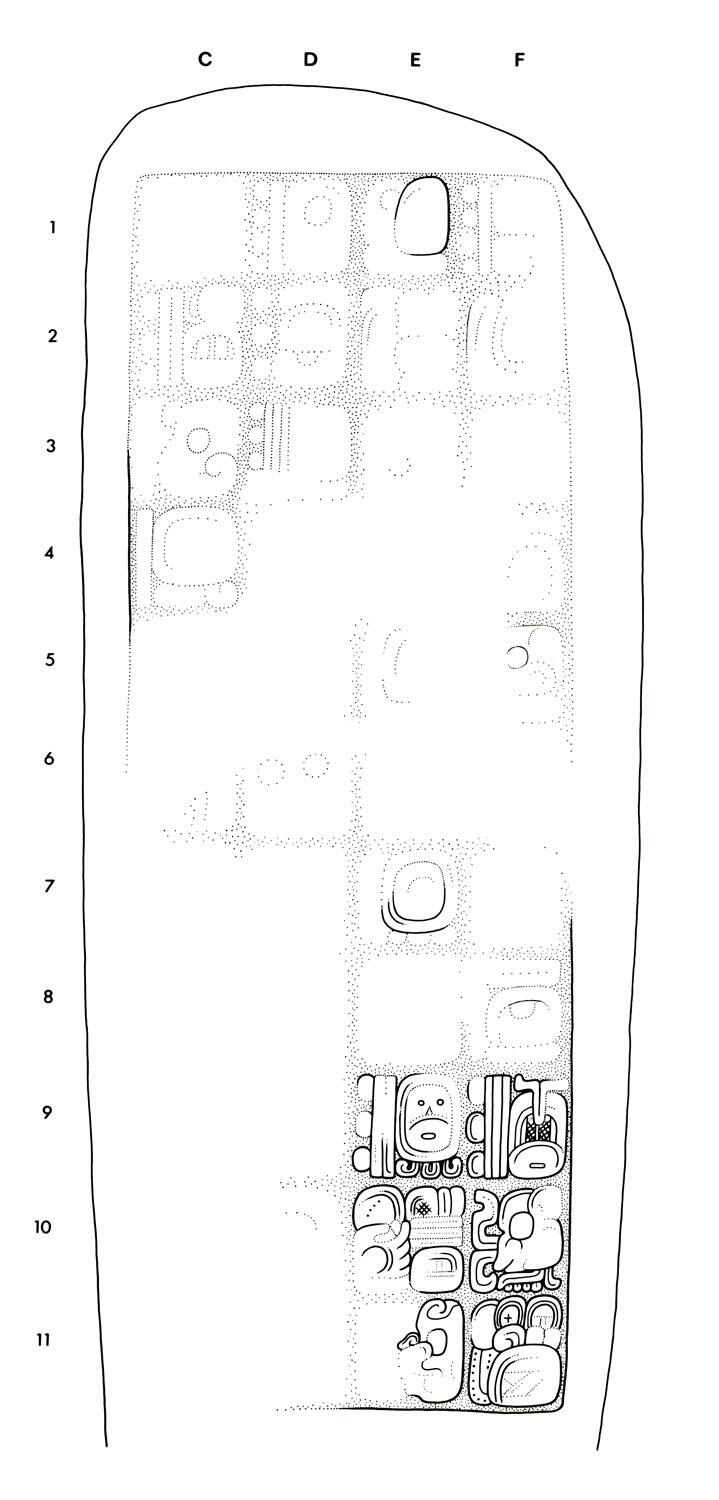
Location
western most of a row of three stelae on the south side of Structure C-6. Broken into pieces by looters in the mid 19605 and removed. Fragments of the front surface were confiscated in Belize and sent to the Museo Nacional de Antropologia y Etnologia, Guatemala City.
Condition
Unbroken when found by Maler, its front surface in an excellent state of preservation, the sculpture on the back almost entirely obliterated over much of the surface. The fragments now preserved in Guatemala include glyphs A1-9 and B11,12.
Material
Limestone.
Shape
Sides essentially parallel, with flattened, rounded top. The front surface was markedly curved, cylindrically, as is most apparent in a photograph by Morley, so that the cross section might be termed lenticular. However, the back surface may have had a less-pronounced curvature.
Dimensions
|
HLC
|
2.23m
|
|
PB
|
0.57m
|
|
MW
|
0.81m
|
|
WEC
|
unknown
|
|
MTh
|
0.33m
|
|
ReI
|
3.0cm
|
Carved Areas
Front and back.
Photographs
Front: reproduced from Maler's original negative of 1905. Back: Morley, 1921.
Drawings
Graham. Drawing of the front based on Maler's photograph and Morley's of l922, and examination of fragments preserved in Guatemala City; that of the back based on Morley's photographs of 1914 and 1921.
Stela 22
Location
Central stela of a group of three lying close to the south side of Structure C-6. Removed to Flores in 1971.
Condition
Unbroken, although Maler may be correct in stating that part of the butt is broken off in the ground. Erosion of the sculptured surfaces is moderate.
Material
A hard limestone.
Shape
Nearly parallel sides, with irregullarly rounded top.
Dimensions
|
HLC
|
2.55m
|
|
PB
|
0.67m
|
|
MW
|
1.14m
|
|
WEC
|
1.09m
|
|
MTh
|
0.45m
|
|
ReI
|
3.7cm
|
Carved Areas
Front and both narrow sides carved in relief.
Photographs
Front: reproduced from Maler's original negative of 1905. Sides: Graham, 1969.
Drawings
Graham, based on field drawings corrected by artificial light.
Remarks
Morley's lettering of the glyph-blocks is followed, except in regard to what he saw as a possible glyph on the hip of the subsidiary figure and designated by him as D1. This, as Maler realized, is the left foot of the squatting man.
Maler's statement that part of the butt lies buried suggests that he excavated in search of a cache, for the butt as it survives could be considered adequate.
Stela 23
Drawing of Naranjo, Stela 23, left, 2004.15.6.2.43
Drawing of Naranjo, Stela 23, right, 2004.15.6.2.44
Location
Easternrnost of the three stelae on the south side of Structure C-6.
Condition
Unbroken when found by Maler and apparently lying face down, since he writes of the relief having suffered from the moisture of the soil. The surface has indeed been severely eroded in an unusual way, with the recessed background left unaffected.In the mid-1960s the stela was shattered by fire or explosives set by looters. The lower half was left in fragments, some of which had disappeared a few years later; the upper part, although thoroughly cracked, remained coherent.
Material
Limestone.
Shape
The almost parallel sides taper somewhat towards the base; the top is rounded and irregular.
Dimensions
|
HLC
|
3.40m
|
|
PB
|
.80m
|
|
MW
|
1.07m
|
|
WBC
|
O.94m
|
|
MTh
|
O.34m
|
|
ReI
|
3.2cm
|
Carved Areas
Front, and both narrow sides.
Photographs
Reproduced from Maler's negatives taken in 1905, except for the upper part of the right-hand side down to glyphs G10 and H7, which is from a photograph by Graham. Stereophotos also by Graham.
Drawings
Front: von Euw. Sides: Graham. All were based on field drawings corrected by artificial light. the missing sections of the sides, for which the only record is Maler's, are E16-21, F17-21, G18-20, and small areas of other glyphs.
Stela 24
Location
North side of Structure C-7. The stela was broken up and removed in the mid-1960s. All the pieces constituting the front were later recovered and sent to the Miami Museum of Science for restoration and exhibition, on loan fronn the governnnent of Guatemala.
Condition
Unbroken when found by Maler, buried in debris and thus protected from erosion. After undergoing demolition and reconstruction the front of the stela remains in quite good condition, marred only by the numerous cracks running across it. The thickness of the shaft having been reduced by a little more than one-half, glyph collumns C and D,adjacent to the front, have survived with their inner edges cropped of about one-quarter of their width.
Material
Limestone.
Shape
Sides essentially parallel; unsymmetrically rounded top.
Dimensions
|
HLC
|
1.92m
|
|
PB
|
0.46m
|
|
MW
|
0.87m
|
|
WBC
|
0.86m
|
|
MTh
|
0.32m
|
|
ReI
|
4.0cm
|
Carved Areas
Front, and both narrow sides.
Photographs
Reproduced from Maler's negatives taken in 1905, except for the upper part of the right-hand side down to glyphs G10 and H7, which is from a photograph by Graham. Stereophotos also by Graham.
Drawings
Front: von Euw. Sides: Graham. All were based on field drawings corrected by artificial light. the missing sections of the sides, for which the only record is Maler's, are E16-21, F17-21, G18-20, and small areas of other glyphs.
Carved Areas
Front and both sides.
Photographs
reproduced from Maler's original negatives of 1905.
Drawings
Graham, based on Maler's photographs and examination of the original.
Stela 25
Location
Northernmost of the rear row of stelae set on the terrace in front of Structure C-9. The stela was removed to Flores in 1971.
Condition
Broken into two halves, with a piece missing at the break. The lower half was still standing when Maler found it. Most of the sculptured surface is qui te well preserved.
Material
A hard limestone,
Shape
Parallel sides, with rounded top.
Dimensions
|
HLC
|
1.86m
|
|
PB
|
0.80m
|
|
MW
|
0.70m
|
|
WBC
|
0.67 m
|
|
MTh
|
0.31 m
|
|
Rei
|
1.2 cm
|
Carved Areas
Front carved in relief; both sides carry incised inscriptions.
Photographs
Morley, 1921.
Drawings
Front: von Euw, based on field drawings corrected by artificial light. Sides: Graham, based on field drawings and a photograph of the upper right-hand side with the glyphs inked in.
Remarks
At B8, a third numerical dot can be faintly distinguished, although a month position number of three cannot properly occur with the day Kan. At C10, the position number in the month Zip is very clearly 18, whereas 17 is called for.
Stela 26
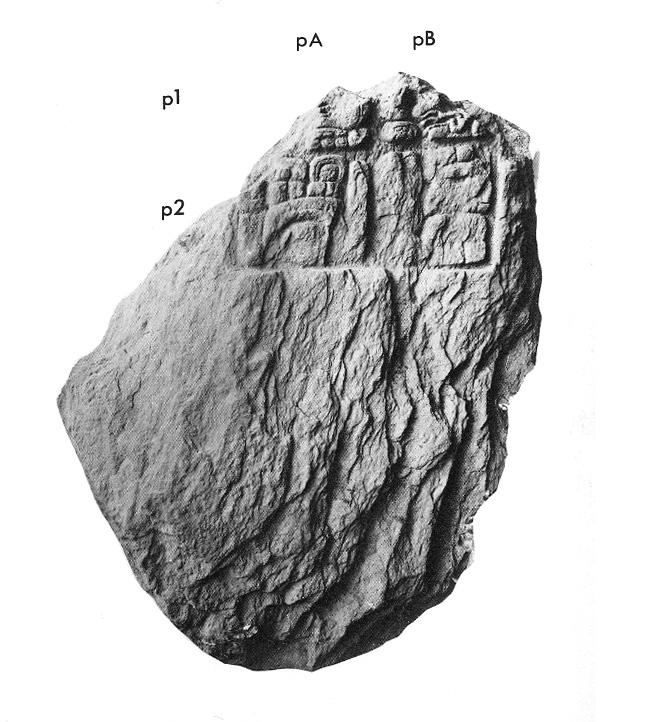
Location
Stated by Maler to have been the central member of a line of three stelae at the rear on the terrace in front of Structure C-9.
Condition
Broken into fragments of which Morley found two. In 1970 only one could be found, the same one that Morley illustrated.
Material
A schistose stone of grayish brown color.
Shape
Unknown.
Dimensions
|
HLC
|
0.33 m plus
|
|
PB
|
0.62 m
|
|
MW
|
0.84 m
|
|
WBC
|
unknown
|
|
MTh
|
0.25 m plus
|
|
Rel
|
2.0 em
|
Carved Areas
Unknown.
Photograph
Morley, 1922.
Drawing
Graham, based on field drawing corrrected by artificial light.
Stela 27
Location
Southernmost of the rear row of stelae set on the terrace in front of Structure C-9. Removed to Melchor de Meneos in 1972.
Condition
Broken into several pieces of which Morley found three, one of them smooth on both faces and therefore presumably part of the butt. In 1971 another sculptured fragment was found and is illustrated here.
Material
Fine-grainedlimestone. Maler's poor opinion of its quality may have been due to belief that a once-existing high relief had rather rapidly been reduced by action of the weather.
Shape
Unknown.
Dimensions
|
HLC
|
0.73 m plus
|
|
PB
|
0.47 m
|
|
MW
|
0.67 m plus
|
|
WBC
|
unknown
|
|
MTh
|
0.30 m
|
|
Rei
|
0.9 em
|
Carved Areas
Front only.
Photograph
Graham, 1971.
Drawing
Graham, based on a field drawing corrected by artificial light.
Stela 28
Location
Northernmost in the front row of four stelae on the terrace in front of Structure C -9. Removed to Flores in 1972.
Condition
Maler found the stela broken into three pieces, with most of the butt also broken off in the ground. The front had suffered considerable erosion, the back much more. Over the next half century the back lost more of its relief, and became more deeply pitted.
Material
Limestone.
Shape
Almost parallel sides, with flattish top.
Dimensions
|
HLC
|
2.34m
|
|
PB
|
0,27 m plus
|
|
MW
|
1.25 m
|
|
WBC
|
1.20 m approx.
|
|
MTh
|
0.46 m
|
|
R,I
|
4,0 em
|
Carved Areas
Front and back.
Photographs
Front: reproduced from Maler's original negatives of 1905. Back:
Morley, 1921. Stereophotos: Graham, 1972.
Drawings
Front: von Euw, based on field drawings corrected by artificial light. Back:
Graham, based mainly on Morley's photographs and to a lesser extent, because the surface has deteriorated, on stereophotos and a field drawing.
Stela 29
Location
Second from the north end of the front row of stelae that were set on the terrace at the foot of Structure C-9. Found by Maler lying on its right-hand edge, partly buried in debris. Removed to Melchor de Mencos in 1972.
Condition
Unbroken. The left-hand side of the front surface and the corresponding area of the back have deteriorated as the result of exposure to the weather.
Material
Limestone.
Shape
Nearly parallel sides, tapering slightly below the middle; rounded top.
Dimensions
|
HLC
|
2.44 In
|
|
PB
|
0.76 In
|
|
MW
|
1.03 In
|
|
WBC
|
0.92 ill
|
|
MTh
|
0.35 m
|
|
ReI
|
2.0 em
|
Carved Areas
Front and back.
Photographs
Reproduced from Maler's original negatives of 1905.
Drawings
Graham, based on field drawings corrected by artificial light.
Stela 30
Location
Second from the right-hand (southern) end in the front row of four stelae on the terrace at the foot of Structure C-9. In about 1966 looters broke up the stela, and two years later the fragments constituting the front surface came to light in the U.S. Customs at Houston, Texas, in a crate marked "Machinery." Through court action the government of Guatemala regained possession of these fragments.
Condition
The stela had fallen forward and lay unbroken when discovered by Maler. The front was in practically perfect
condition, the back considerably eroded. Since being smashed up by looters, the front is crisscrossed with breaks but has retained most of its fine detail. The back lies in a thousand chips at the site.
Material
Fine-grained limestone.
Shape
Parallel sides with nearly flat top.
Dimensions
|
HLC
|
2.33 m
|
|
PB
|
0.87 m
|
|
MW
|
1.17 m
|
|
WBC
|
l.13m
|
|
MTh
|
0.38 m
|
|
Rei
|
2.9 em
|
Carved Areas
Front and back.
Photographs
Reproduced from Maler's original negatives of 1905.
Drawings
Graham. Drawing of the front based on Maler's photograph and examination of the reassembled fragments; that of the back based on Maler's and Morley's photographs.
Stela 31
Location
Southernmost stela in the front row offourset on the terrace built out from the foot of Structure C-9 on its west side. Removed to Flores in 1972.
Condition
Lying broken in three pieces when found by Maler, the front moderately eroded, the back more seriously so.
Material
Limestone.
Shape
The sides, nearly parallel in the upper half, taper somewhat toward the bottom. The top is flat.
Dimensions
|
HLC
|
2.43 m (2.12 m
|
|
|
measured on the
|
|
|
back
|
|
PB
|
0.35 m plus
|
|
MW
|
1.19m
|
|
WBC
|
1.02 m
|
|
MTh
|
0.31 m
|
|
ReI
|
2.6 cm
|
Carved Areas
Front and back.
Photographs
Front: reproduced from Maler's original negative of 1905. Back:
Morley, 1921.
Drawings
Graham, based on field drawings corrected by artificial light.
Remarks
8 cm below the foot of the sculptured panel there is a noticeable horizontal ledge. This may correspond with the floor level in the original setting.
Stela 32
Location
Found by Maler lying face down on the plaza floor, at the foot of the terrace of Structure C-9, from which he considered that it must have fallen. It is perhaps more likely that it had been set up in the plaza, close to the place where Maler found it. Removed to Melchor de Mencos in 1972.
Condition
The top right-hand corner had been broken off when Maler discovered the stela. Although much of the sculptured surface was extremely well preserved, about one-quarter of it had flaked away. Looters in the mid-1960s thoroughly cracked the stela, possibly by means of fire and water, with the evident intention of removing it in pieces. This they never did.
Material
Fine-grained limestone.
Shape
Almost parallel-sided, with an irregular, flattish top.
Dimensions
|
HLC
|
1.86 m
|
|
PB
|
0.83 m
|
|
MW
|
1.23 m
|
|
WBC
|
1.09 m
|
|
MTh
|
0.35 m
|
|
Rei
|
1.5 cm
|
Carved Areas
Front only.
Photograph
Reproduced from Maler's original negative of 1905.
Drawing
Graham, based on a field drawing corrected by artificial light, making use also of photographs taken by Morley.
Stela 33
Location
Northernmost of a group of three stelae in front, i.e., to the east, of Structure B-20. Removed to Melchor de Meocos in 1971.
Condition
Unbroken, with its sculptured surface moderately wellpreserved.
Material
Gray, partially metamorphosed limestone, coarse-textured, and weathered brown on the surface.
Shape
Narrow shaft with a rounded peak, of oval cross section.
Dimensions
|
HLC
|
1.83 m
|
|
PB
|
O.SOm
|
|
MW
|
O.45m
|
|
WBC
|
0.45 m
|
|
MTh
|
0.30 m
|
|
Rei
|
1.2 em
|
Carved Areas
Front only.
Photographs
Graham, 1970.
Drawing
Graham, based on a field drawing corrected by artificial light.
Stela 34
Location
In the center of a row of three on the west side of Structure B-20.
Condition
Unbroken but very much eroded, especially along certain bedding planes that intersect the surface.
Material
Coarse limestone of brownish color, with abundant inclusions of quartzite.
Shape
Narrow shaft with parallel sides; the top perhaps squared off originally.
Dimensions
|
HLC
|
2.90 m
|
|
PB
|
0.91 m
|
|
MW
|
0.66 m
|
|
WBC
|
0.56 m
|
|
MTh
|
0.32 m
|
|
Rel
|
1.0 cm
|
Carved Areas
Front only.
Photographs
Entire stela: Morley, 1921; detail: Graham, 1972.
Stela 35
Location
Found by one of Morley's workers on the east side of Structure C-4, lying face up. Removed to Flores in 1971.
Condition
As found, the stela lay in five pieces, the smallest of which could not be found in 1971; this carried portions of glyphs C8, 9, 10. A fragment affecting glyphs E1, F1, also broke off the stela before discovery and has not come to light. The front is quite badly eroded, the back moderately so.
Material
Hard white limestone.
Shape
Sides nearly parallel; top unsymmetrical, with a shoulder caused by an irregularity of the shaft as quarried. The cross section is lenticular.
Dimensions
|
HLC
|
1.40 m
|
|
PB
|
0.48 (front)
|
|
|
0.61 m (back)
|
|
MW
|
0.53 m
|
|
WBC
|
0.48 m
|
|
MTh
|
0.29 m
|
|
Rel
|
1.2 cm
|
Carved Areas
Front and back.
Photographs
Graham, 1973; Morley's 1921 photographs have been used for the small fragment that has disappeared since his day. The apparent discontinuity in the outline of the back is due to the lower partion having been photographed from an offcenter camera position.
Drawings
Graham. The drawings were based on tracings from photographs of flat casts made from latex molds. In this way distortion could be avoided: direct photographs of the stela suffer from unavoidable foreshortening toward the sides, due to the curvature of the sculptured surfaces. Details in the renderings were based on field drawings corrected by artificial light, and on Morley's photographs.
Stela 36
Location
Set up on the west side of the small structure B-1, which appears to have been associated with the ceremonial causeway leading north to Group D.
Condition
Intact and erect until February 1971. Then it was cracked into pieces by fire and the carved portion removed by some ignorant would-be merchant of pre-Columbian sculpture.
Material
A hard limestone.
Shape
Somewhat asymmetrically tapered, with a rounded top. Morley's photographs, the only ones known, were not taken from directly in front of the stela and so distort the shape,
Dimensions
|
Ht
|
1.22m
|
|
MW
|
0.76 m
|
|
MTh
|
0.30 m
|
|
Rel
|
unknown
|
Carved Areas
Front only.
Photograph
Morley, 1922.
Drawing
von Euw, based on Morley's photograph, partially rectified in order to reduce distortion.
Stela 37
Location
Isolated, near the edge of the plaza defined by Structures A-19, A-I5, and the West Acropolis. In 1972 the fragments were removed to Flores.
Condition
Broken into several pieces of which six are known. The sculptured surface is quite badly eroded.
Material
Coarse-grained limestone.
Shape
Approximately parallel sides, narrowing slightly towards the top, which is nearly flat.
Dimensions
|
HLC
|
2.88 m approx.
|
|
PB
|
unknown
|
|
MW
|
0.95 m
|
|
WBC
|
0.94 m approx.
|
|
MTh
|
0.50 m
|
|
Rel
|
2.2 cm
|
Carved Areas
Front only.
Photograph
Graham, 1971.
Drawing
Graham, based on field drawing corrected by artificial light.
Remarks
Stela 37 came to light in 1959 when it was struck by the blade of a bulldozer that was opening a road for lumbering. It was seen lying by the roadside, with scars still fresh, by Graham when he passed by soon after.
Stela 38
Location
Close against the south side of Structure D-1, 1.4 m to the west of Stela 39. When found, the butt was in situ, with the main portion of the stela resting on it and leaning forward against a tree. Rafael Morales H. excavated the butt and removed the stela to Flores in 1971.
Condition
Broken into two pieces, with a clean break near the bottom of the sculptured panel. The degree of erosion is very slight, the face of the personage portrayed having been obliterated in antiquity.
Material
A hard, fine-grained limestone.
Shape
Somewhat barrel-shaped, with a rounded, f1attish top.
Dimensions
|
HLC
|
1.58 m
|
|
PB
|
0.58 m
|
|
MW
|
0.89 m
|
| WBC |
0.79 m
|
|
MTh
|
0.43 m
|
|
Rel
|
0.9 cm
|
Carved Areas
Front surface only; carved in relief, with the inscriptions incised on raised panels.
Photographs
Graham, 1971,
Drawing
Graham, based on a field drawing corrected by artificial light.
Stela 39
Location
Easternmost of two stelae at the foot of the stairway leading up the south side of Structure D-1. Discovered in 1971, the stela was stolen within the following year before it had been properly recorded.
Condition
Only the badly weathered lower portion was found, still set in the ground.
Material
Limestone.
Shape
Unknown.
Dimensions
No measurements were taken; the shaft was narrow.
Carved Areas
The front alone seemed to have been carved.
Photograph
Graham, 1971.
Stela 40
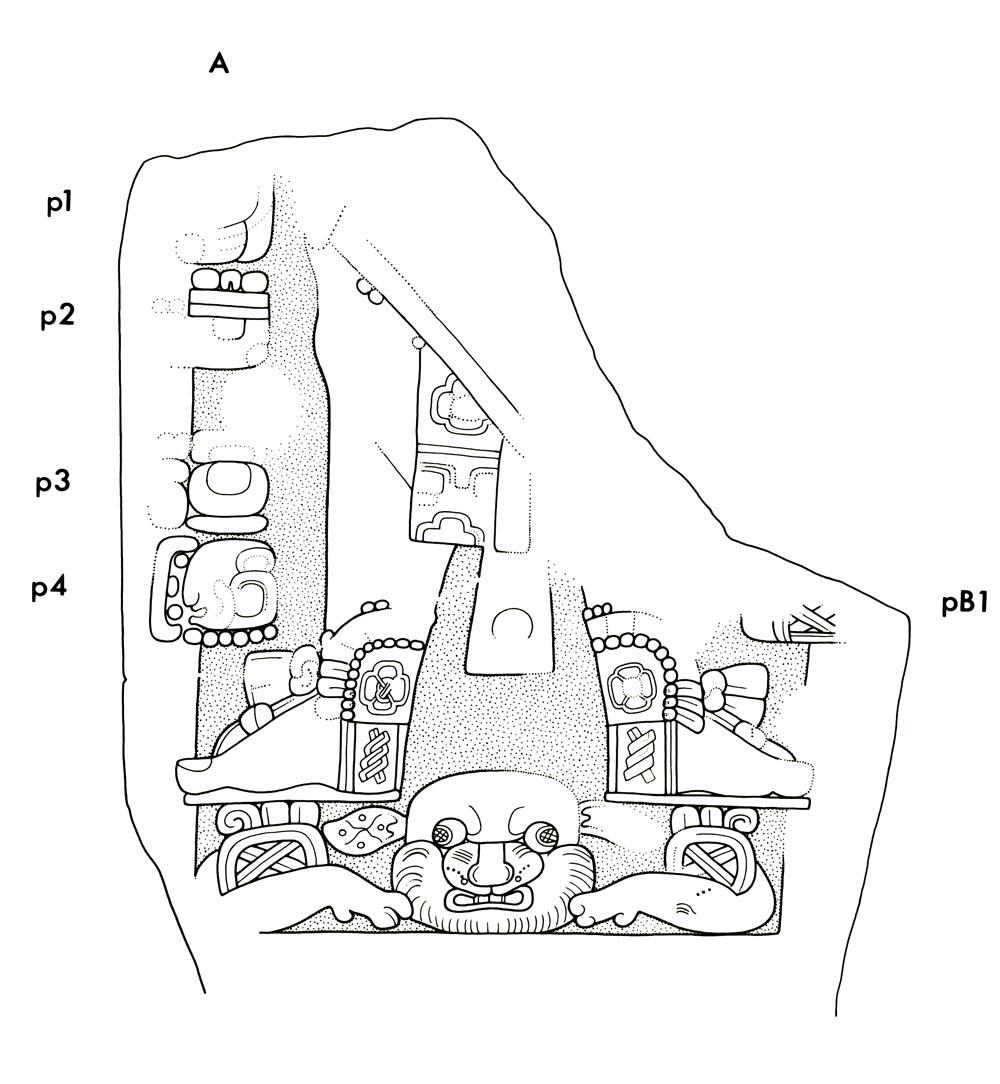
Drawing of Naranjo, Stela 40, front, 2004.15.6.3.21
Location
South side of Structure D-1, where it appears to have been set directly in front of Stela 39. Discovered in 1971 and removed in that year to the Museo Nacional de Antropología y Etnología, Guatemala City.
Condition
Only the lower portion of the stela was found. It lay almost buried, face down, and so escaped erosion.
Material
Limestone of reddish brown cast.
Shape
Unknown.
Dimensions
|
HLC
|
0.74 m plus
|
|
PB
|
0.40 m
|
|
MW
|
0.69 m
|
|
WBC
|
0.63 m
|
|
MTh
|
0.21 m
|
|
Rel
|
1.0 cm
|
Carved Areas
Front only.
Photograph
Grahilln, 1971.
Drawing
Graham, based on a field drawing corrected by artificial light.
Stela 41
Location
Found on the west side of Structure C-10. This structure, 9 m high, and other smaller ones in front of it are situated on the flattened top of a hill which stands about 28 m higher than ground level in the plaza to the west of it. Neither Morley nor I ever ascended this hill while exploring the site, nor did either of us notice the parallel bounding walls of a ceremonial approach up the hillside. Early in 1978 looters who were cutting a trench into the mound came upon the stela, which apparently lay covered by rubble. Their activities were discovered before they had managed to remove the stela. Shortly thereafter it was removed to Melchor de Mencos by Marco Antonio Bailey of the Instituto de Antropología e Historia. The revised portion of the site plan printed on this page is based on a survey that I made in 1978.
Condition
Unbroken and rather well preserved, apart from areas near the bottom that have split off and the damaged top edge. The face was evidently obliterated in antiquity.
Material
Limestone.
Shape
Parallel sides, with a rounded top.
Dimensions
|
HLC
|
1.45 m
|
|
|
PB
|
0.80 m
|
|
|
MW
|
0.76 m
|
|
|
WBC
|
0.71 m
|
|
|
MTh
|
0.40 m
|
|
|
Rel
|
1.5
|
cm
|
Carved Areas
Front only.
Photograph
Graham, 1978.
Drawing
Graham, based on a field drawing corrected by artificial light.
Altar 1
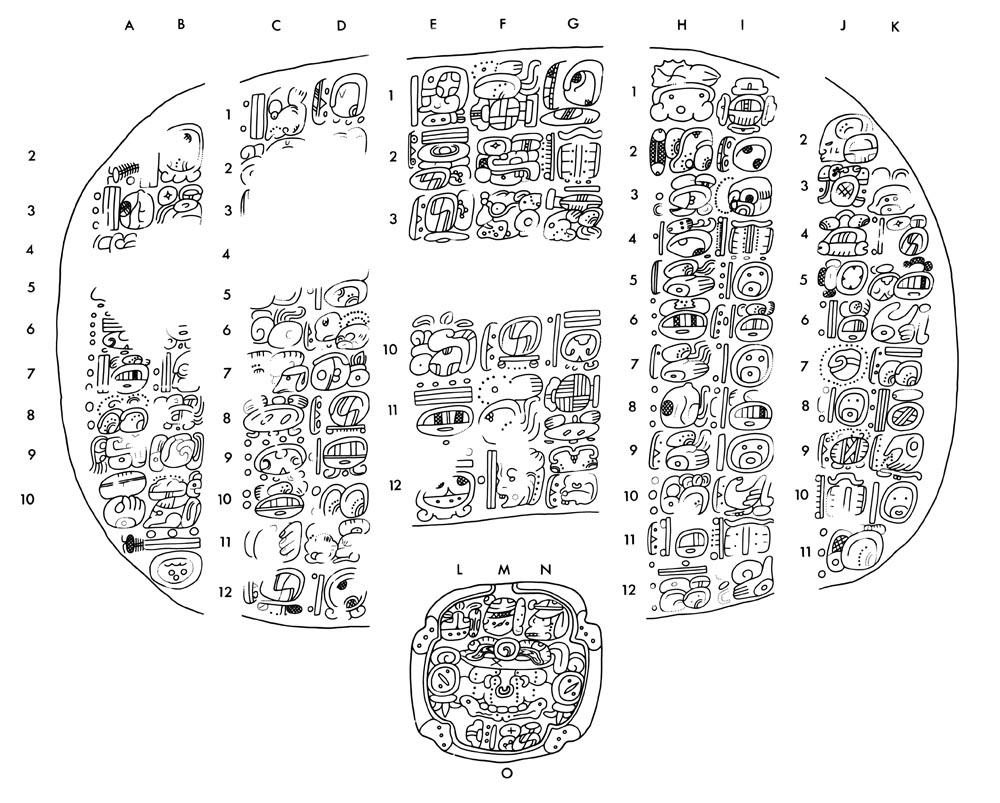
Location
This altar came to light in 1977 in the collection of Sr. Jorge Castillo, of Guatemala City. As a piece without secure provenience, it would ordinarily have been given a "Collections" designation; however, it can be recognized, on the basis of parallel passages in the two inscriptions, as almost certainly the altar of Stela 38 from Naranjo. Presumably it was removed from its setting not long before April 1971, the date of the first visit to Group D by Sr. Rafael Morales H. and the author, for on that occasion signs of recent activity by looters were in evidence.
Condition
Broken into four pieces, plus a small fragment now lost. Apart from some losses by flaking, the surface condition is good. Red paint can be seen in some of the drilled holes.
Material
Yellowish limestone of fine grain, flawed by weak cleavage planes.
Shape
Oval, with smoothly dressed face and (to a lesser extent) edges.
Dimensions
|
Max. diameter
|
0.82 m
|
|
|
Min. diameter
|
0.61 m
|
|
|
MTh
|
0.14 m
|
|
|
Rel
|
0.2
|
cm
|
Carved Areas
Upper surface only; text incised, with central cartouche outlined in slightly greater relief.
Photograph
Graham, 1977.
Drawing
Graham, based on a drawing corrected by artificial light.
Lintel 1
Location
Found by Maler reused in the second step of the Hieroglyphic Stairway, between Inscription 7 and Inscription 8 in Morley's terminology, or Step VII and Step VIIl in the informal usage of this work. Removed by Herbert J. Spinden to the American Museum of Natural History in 1914.
Condition
Found by Maler buried in debris and rather well preserved, although trimmed down from its original size. Already cracked, Spinden broke the lintel to carry it away; this action resulted in no significant loss of detail. Textual evidence shows that a whole column of glyphs was anciently trimmed off the left side, and half a column on the right. Maler was probably mistaken in supposing the upper border also to have been trimmed before reuse in the stairway.
Material
Limestone.
Shape
Essentially rectangular, with a narrow, well finished border above and one that is wider and more roughly dressed below.
Dimensions
|
Ht
|
0.47 m
|
|
MW
|
0.70 m
|
|
HSc
|
0.37 m
|
|
MTh
|
unknown
|
|
Rei
|
unknown
|
Carved Areas
Front only (or underside, if truly a lintel).
Photograph
Reproduced from Maler's original negative of 1905.
Drawing
Graham, based on Maler's photograph and on a drawing made of the original lintel on display, mounted in a showcase from which it was evidently not convenient to remove it.
Remarks
This piece might better have been called Panel 1. The fact that inscriptions on lintels generally run down rather than across and the inequality of the borders suggest a panel, one perhaps that had its lower edge set in a floor, A further point is that carved stone lintels are otherwise unknown in the eastern Maya lowlands.
Sculpture 1
Location
When found in 1979 by site guards employed by the Instituto de Antropología e Historia, this fragment was lying on the ground to the northwest of Structures B-32 and B-33, a pair of mounds that forms one of the two ball courts at this site.
Condition
The fragment represents about one third of a ball-court marker ring. The side lying uppermost is so badly eroded that the two hieroglyphs carved on it are barely distinguishable; the other side and the periphery show only moderate weathering.
Material
White limestone.
Shape
A carefully dressed ring of square section with rounded inner edges. At one end the fragment becomes wider, where presumably a tenon was formed.
Dimensions
|
Outer dia
|
0.42 m
|
|
|
Inner dia
|
0.19 m
|
|
|
MTh
|
0.20 m
|
|
|
Rei
|
0.4
|
em
|
Photograph
Graham, 1979.
Drawing
Graham, based on a field drawing not checked by artificial light.
Note
A ring without surviving tenon was found by von Euw at Xultun, just to the north of Structures A-16 and A-17, a ball court. Its outer and inner diameters are 0.42 m and 0.12 m; its thickness 0.22m.
Carved Areas
Both sides and the periphery in intaglio or depressed relief.
Hieroglyphic Stairway
Drawing of Naranjo Hieroglyphic Stairway, front
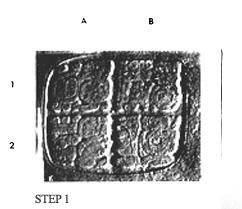
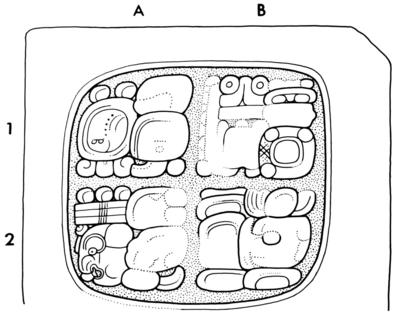
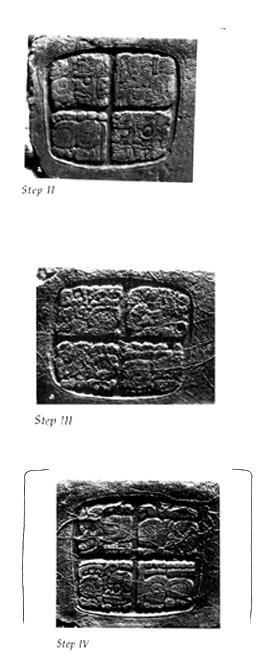
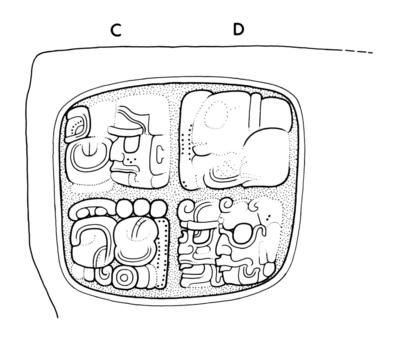
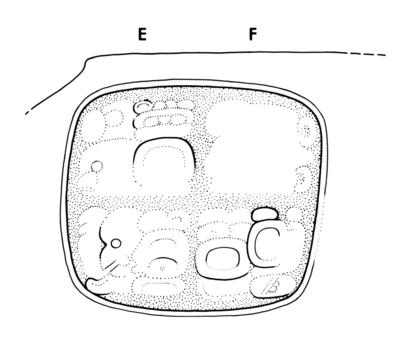
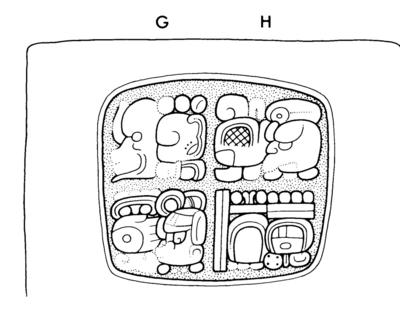
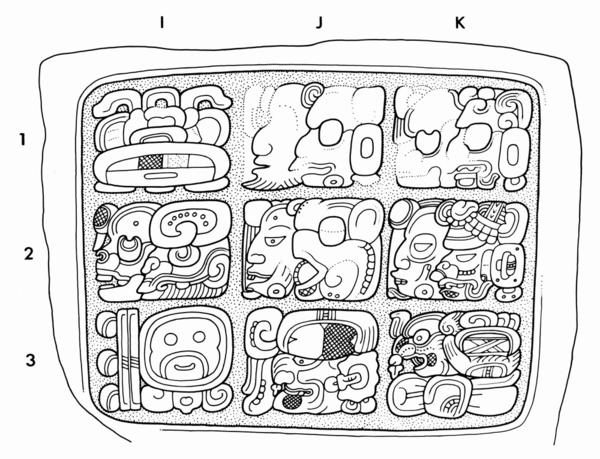
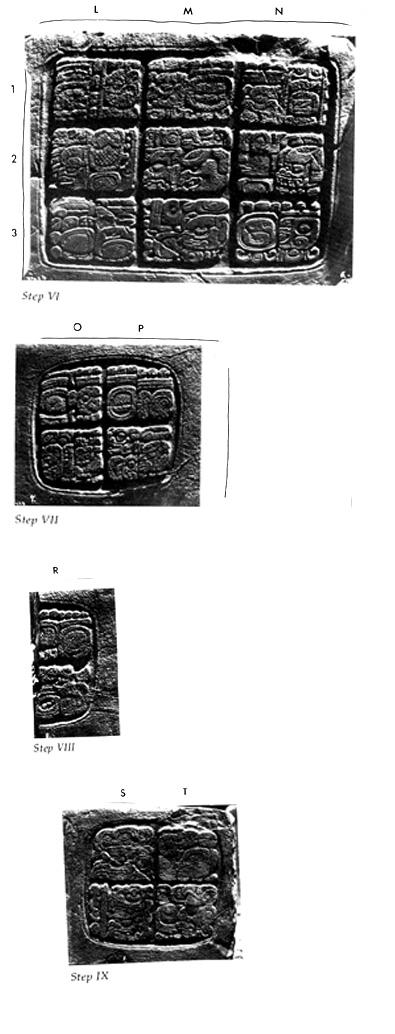
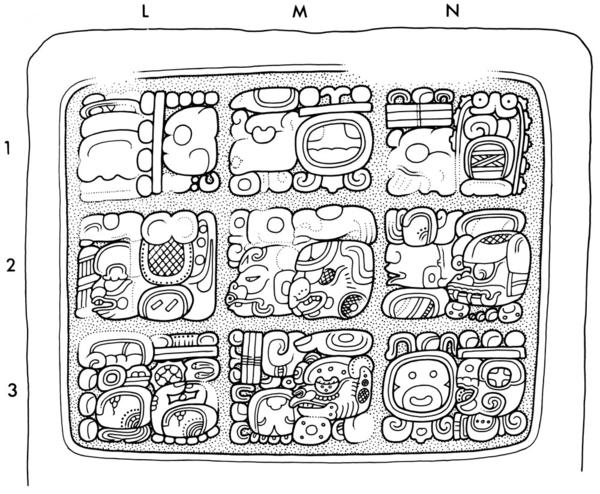
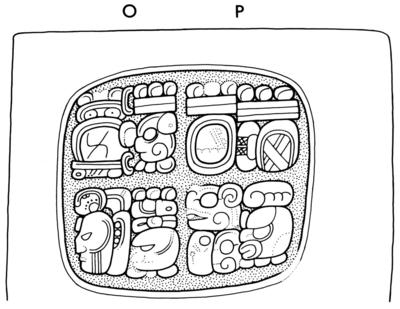
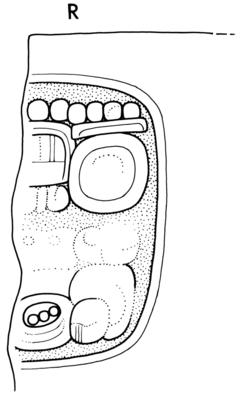

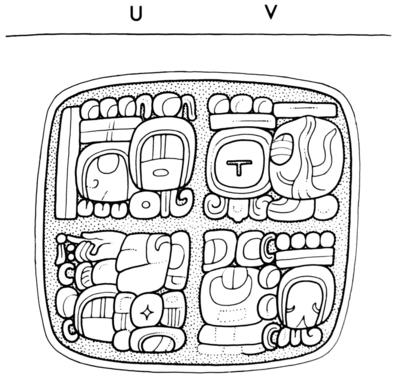

A Note on Nomenclature
Maler's numbering of the individual blocks, or Inscriptions in Morley's terminology, is retained but given in Roman numerals. Formally, a block will be referred to as HS. 1, IV, for example, or less formally as Step IV where there is no danger of confusion with the fourth step of the stairway.
Location
The carved blocks were incorporated into the lower part of the stairway leading up the west side of Structure B-18. Alterations to the stairway and dismemberment of it evidently began long ago, probably in Postclassic times, as Maler realized when he found a reused panel inserted in place of a broken step. Another striking piece of evidence is the step, undoubtedly once part of the stairway and here designated Step XIII, that was found at Ucanal, 35 kilometers away as the guacamayo flies.
As mentioned above in the general description of the site, the stairway was picked clean of its sculpture within fifteen years of discovery, except for the three monsters' heads, and they disappeared in the 1960s. The location of the steps in 1977 is as follows: Steps I and IV to XI in the British Museum; Step XII in the Museum of the American Indian, Heye Foundation, New York City; Step XIII in storage at Tikal National Park; Steps II and III lost, the latter possibly in transit to El Cayo in 1920 (Morley 1937-38, vol. 2, p. 58).
Condition
The general condition of the steps at the time of their discovery was good because they were of hard stone, and most of them had fallen on their faces or else had been buried in debris. Step XIII retains most of its design in spite of having lain face up for a few centuries, at least. The only noteworthy breakage, apart from Step VIII, the left-hand half of which is missing, is the loss of about one-tenth of the cartouche of Step XI. As the result of being broken up for removal, the steps now in the British Museum show some small losses. Step XII appears exactly as in Maler's photograph, and Step XIII was taken out of Ucanal entire.
Material
Hard, fine-grained limestone.
Shape
Rectangular blocks, with the front and upper surfaces smoothly dressed. The upper edge is well rounded in some cases, most notably Steps IV, VII, and XIII, and least so in Steps V and VI.
Dimensions
The most consistent dimensions are those of the cartouches: these all fall within one centimeter of 0.35 by 0.38 m for the smaller steps, neglecting the surrounding line. The width of the stone blocks is more variable and in some cases cannot now be established because of breakage. The two larger blocks, Steps V and VI, have cartouches measuring 0.75 by 0.60 m and 0.78 by 0.62 m respectively.
Carved Areas
Front surfaces (risers) only.
Photographs
Steps I to XII: reproduced from Maler's original negatives of 1905; Step XIII: Graham, 1972.
Drawings
Graham, based on above photographs and drawings from originals (excepting Steps II and III). The outlines of some of the blocks have been left incomplete because they fell outside the frame of Maler's photgraph and have since been altered by breakage.
The diagram showing the arrangement of the steps and the monsters' heads is taken from Morley 1937-38, vol. 2, fig. 26. Individual blocks are numbered in Arabic numerals on the diagram, rather than in the Roman numerals employed in this work.
Note
Further information on Step XIII will be found in the section of this work treating of Ucanal and its monuments.
